Quick filters:
Sericulture Stock Photos and Images
 China. Sericulture Silkworm culture. Cocoon tray waterbath worm reel paper 1748 Stock Photohttps://www.alamy.com/image-license-details/?v=1https://www.alamy.com/china-sericulture-silkworm-culture-cocoon-tray-waterbath-worm-reel-paper-1748-image242613421.html
China. Sericulture Silkworm culture. Cocoon tray waterbath worm reel paper 1748 Stock Photohttps://www.alamy.com/image-license-details/?v=1https://www.alamy.com/china-sericulture-silkworm-culture-cocoon-tray-waterbath-worm-reel-paper-1748-image242613421.htmlRFT2KYW1–China. Sericulture Silkworm culture. Cocoon tray waterbath worm reel paper 1748
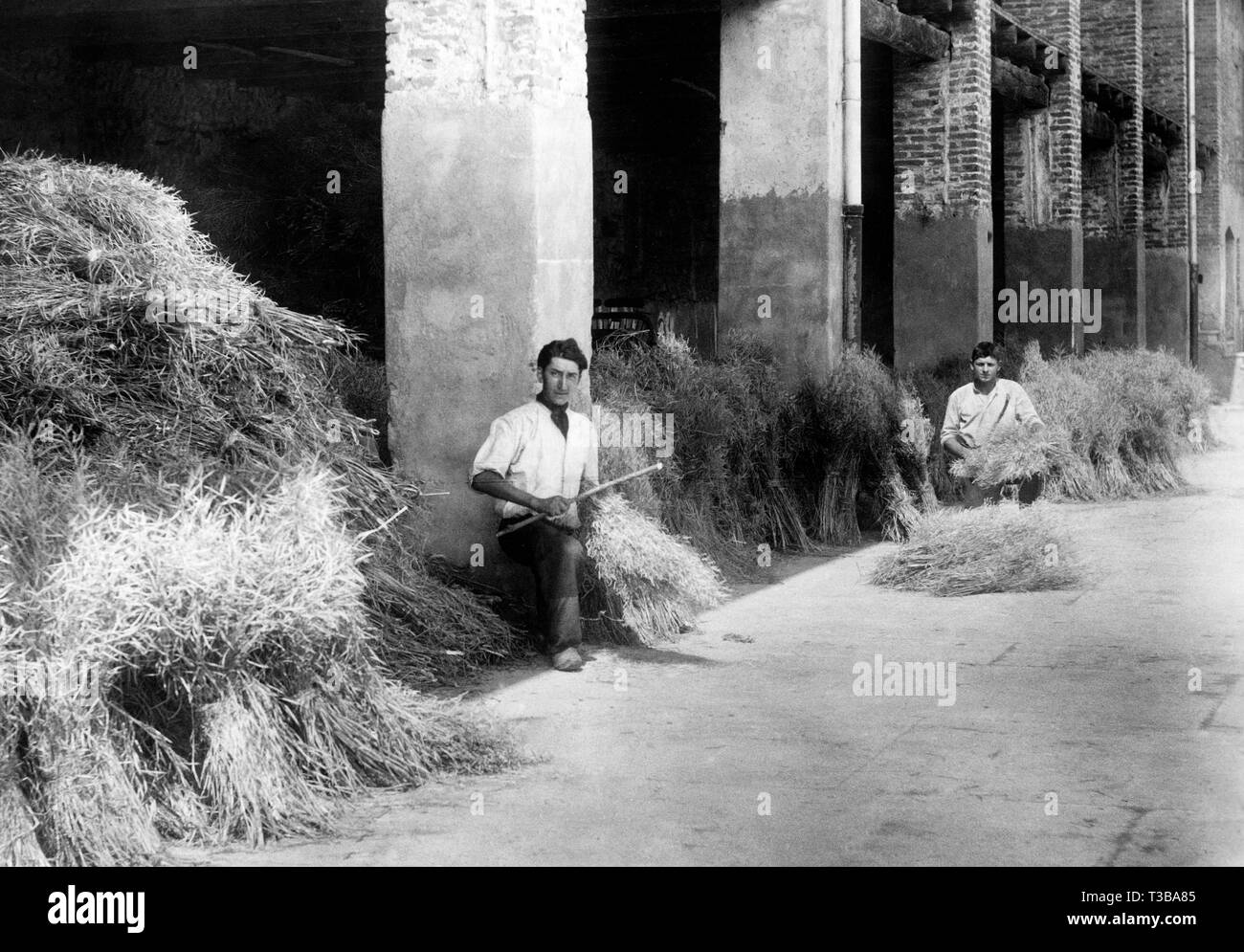 sericulture Stock Photohttps://www.alamy.com/image-license-details/?v=1https://www.alamy.com/sericulture-image243038661.html
sericulture Stock Photohttps://www.alamy.com/image-license-details/?v=1https://www.alamy.com/sericulture-image243038661.htmlRMT3BA85–sericulture
 Silkworm cocoons 'Bombyx mori' on wooden frame, production of silk thread. Hoi An, Vietnam. Stock Photohttps://www.alamy.com/image-license-details/?v=1https://www.alamy.com/stock-photo-silkworm-cocoons-bombyx-mori-on-wooden-frame-production-of-silk-thread-172131425.html
Silkworm cocoons 'Bombyx mori' on wooden frame, production of silk thread. Hoi An, Vietnam. Stock Photohttps://www.alamy.com/image-license-details/?v=1https://www.alamy.com/stock-photo-silkworm-cocoons-bombyx-mori-on-wooden-frame-production-of-silk-thread-172131425.htmlRMM017AW–Silkworm cocoons 'Bombyx mori' on wooden frame, production of silk thread. Hoi An, Vietnam.
 spinning silk thread at the Queen Sirikit Sericulture Center in Surin Thailand Stock Photohttps://www.alamy.com/image-license-details/?v=1https://www.alamy.com/stock-photo-spinning-silk-thread-at-the-queen-sirikit-sericulture-center-in-surin-20483219.html
spinning silk thread at the Queen Sirikit Sericulture Center in Surin Thailand Stock Photohttps://www.alamy.com/image-license-details/?v=1https://www.alamy.com/stock-photo-spinning-silk-thread-at-the-queen-sirikit-sericulture-center-in-surin-20483219.htmlRMB592FF–spinning silk thread at the Queen Sirikit Sericulture Center in Surin Thailand
 Women reeling silk threads from cocoons in a silk factory, Bangalore. India Stock Photohttps://www.alamy.com/image-license-details/?v=1https://www.alamy.com/women-reeling-silk-threads-from-cocoons-in-a-silk-factory-bangalore-image4058468.html
Women reeling silk threads from cocoons in a silk factory, Bangalore. India Stock Photohttps://www.alamy.com/image-license-details/?v=1https://www.alamy.com/women-reeling-silk-threads-from-cocoons-in-a-silk-factory-bangalore-image4058468.htmlRMA9RW65–Women reeling silk threads from cocoons in a silk factory, Bangalore. India
 Vietnam Hanoi Woman working in sericulture plant Stock Photohttps://www.alamy.com/image-license-details/?v=1https://www.alamy.com/stock-photo-vietnam-hanoi-woman-working-in-sericulture-plant-14123743.html
Vietnam Hanoi Woman working in sericulture plant Stock Photohttps://www.alamy.com/image-license-details/?v=1https://www.alamy.com/stock-photo-vietnam-hanoi-woman-working-in-sericulture-plant-14123743.htmlRMAG7WHM–Vietnam Hanoi Woman working in sericulture plant
 Notes on Sericulture M.73.75.45 Stock Photohttps://www.alamy.com/image-license-details/?v=1https://www.alamy.com/stock-photo-notes-on-sericulture-m737545-58490864.html
Notes on Sericulture M.73.75.45 Stock Photohttps://www.alamy.com/image-license-details/?v=1https://www.alamy.com/stock-photo-notes-on-sericulture-m737545-58490864.htmlRMDB4DKC–Notes on Sericulture M.73.75.45
![[ 1910s Japan - Japanese Silk Farming ] — Silk farming. This postcard is from a series about sericulture, showing the steps involved in making silk. This is card 9. 20th century vintage postcard. Stock Photo [ 1910s Japan - Japanese Silk Farming ] — Silk farming. This postcard is from a series about sericulture, showing the steps involved in making silk. This is card 9. 20th century vintage postcard. Stock Photo](https://c8.alamy.com/comp/2BKNAD8/1910s-japan-japanese-silk-farming-silk-farming-this-postcard-is-from-a-series-about-sericulture-showing-the-steps-involved-in-making-silk-this-is-card-9-20th-century-vintage-postcard-2BKNAD8.jpg) [ 1910s Japan - Japanese Silk Farming ] — Silk farming. This postcard is from a series about sericulture, showing the steps involved in making silk. This is card 9. 20th century vintage postcard. Stock Photohttps://www.alamy.com/image-license-details/?v=1https://www.alamy.com/1910s-japan-japanese-silk-farming-silk-farming-this-postcard-is-from-a-series-about-sericulture-showing-the-steps-involved-in-making-silk-this-is-card-9-20th-century-vintage-postcard-image356355028.html
[ 1910s Japan - Japanese Silk Farming ] — Silk farming. This postcard is from a series about sericulture, showing the steps involved in making silk. This is card 9. 20th century vintage postcard. Stock Photohttps://www.alamy.com/image-license-details/?v=1https://www.alamy.com/1910s-japan-japanese-silk-farming-silk-farming-this-postcard-is-from-a-series-about-sericulture-showing-the-steps-involved-in-making-silk-this-is-card-9-20th-century-vintage-postcard-image356355028.htmlRM2BKNAD8–[ 1910s Japan - Japanese Silk Farming ] — Silk farming. This postcard is from a series about sericulture, showing the steps involved in making silk. This is card 9. 20th century vintage postcard.
 Sericulture Spreading Mulberry leaves to feed silkworms India Asia Stock Photohttps://www.alamy.com/image-license-details/?v=1https://www.alamy.com/stock-photo-sericulture-spreading-mulberry-leaves-to-feed-silkworms-india-asia-83624130.html
Sericulture Spreading Mulberry leaves to feed silkworms India Asia Stock Photohttps://www.alamy.com/image-license-details/?v=1https://www.alamy.com/stock-photo-sericulture-spreading-mulberry-leaves-to-feed-silkworms-india-asia-83624130.htmlRMET1BC2–Sericulture Spreading Mulberry leaves to feed silkworms India Asia
 Sericulture (The Process of Making Silk), early 1200s. Attributed to Liang Kai (Chinese, mid-1100s-early 1200s). Handscroll; ink and color on silk; third section: 27.6 x 92.3 cm (10 7/8 x 36 5/16 in.); second section: 27.6 x 92.3 cm (10 7/8 x 36 5/16 in.); first section: 26.7 x 98.6 cm (10 1/2 x 38 13/16 in Stock Photohttps://www.alamy.com/image-license-details/?v=1https://www.alamy.com/sericulture-the-process-of-making-silk-early-1200s-attributed-to-liang-kai-chinese-mid-1100s-early-1200s-handscroll-ink-and-color-on-silk-third-section-276-x-923-cm-10-78-x-36-516-in-second-section-276-x-923-cm-10-78-x-36-516-in-first-section-267-x-986-cm-10-12-x-38-1316-in-image240450452.html
Sericulture (The Process of Making Silk), early 1200s. Attributed to Liang Kai (Chinese, mid-1100s-early 1200s). Handscroll; ink and color on silk; third section: 27.6 x 92.3 cm (10 7/8 x 36 5/16 in.); second section: 27.6 x 92.3 cm (10 7/8 x 36 5/16 in.); first section: 26.7 x 98.6 cm (10 1/2 x 38 13/16 in Stock Photohttps://www.alamy.com/image-license-details/?v=1https://www.alamy.com/sericulture-the-process-of-making-silk-early-1200s-attributed-to-liang-kai-chinese-mid-1100s-early-1200s-handscroll-ink-and-color-on-silk-third-section-276-x-923-cm-10-78-x-36-516-in-second-section-276-x-923-cm-10-78-x-36-516-in-first-section-267-x-986-cm-10-12-x-38-1316-in-image240450452.htmlRMRY5D04–Sericulture (The Process of Making Silk), early 1200s. Attributed to Liang Kai (Chinese, mid-1100s-early 1200s). Handscroll; ink and color on silk; third section: 27.6 x 92.3 cm (10 7/8 x 36 5/16 in.); second section: 27.6 x 92.3 cm (10 7/8 x 36 5/16 in.); first section: 26.7 x 98.6 cm (10 1/2 x 38 13/16 in
 Sericulture, interior view, Nanping, Huangshan, China, Asia Stock Photohttps://www.alamy.com/image-license-details/?v=1https://www.alamy.com/stock-photo-sericulture-interior-view-nanping-huangshan-china-asia-23954045.html
Sericulture, interior view, Nanping, Huangshan, China, Asia Stock Photohttps://www.alamy.com/image-license-details/?v=1https://www.alamy.com/stock-photo-sericulture-interior-view-nanping-huangshan-china-asia-23954045.htmlRMBAY5HH–Sericulture, interior view, Nanping, Huangshan, China, Asia
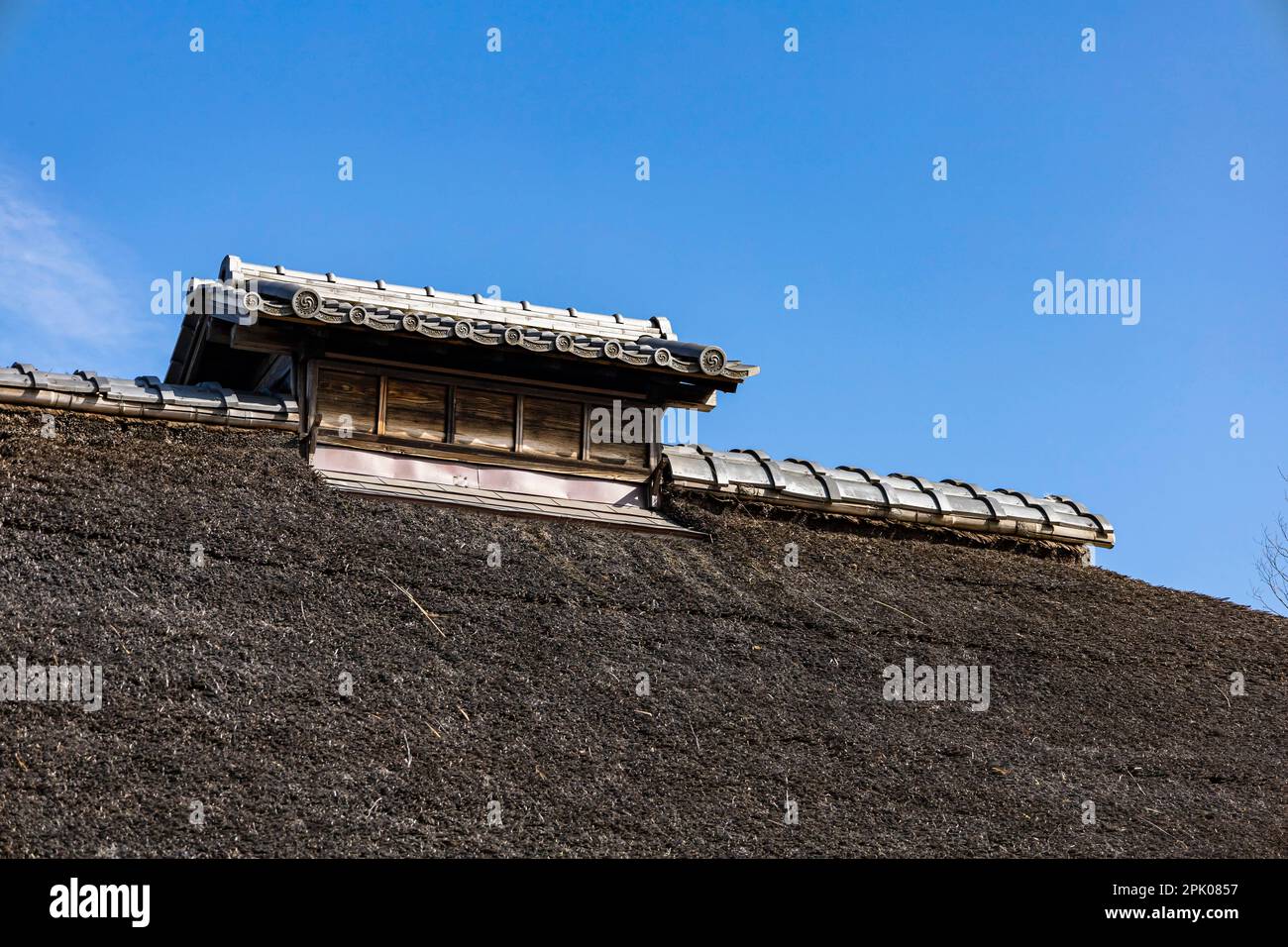 Small roof top of sericulture room, old farmers house, thatched roof, Jidayubori park, Kitami, Setagaya Ku, Tokyo, Japan, East Asia, Asia Stock Photohttps://www.alamy.com/image-license-details/?v=1https://www.alamy.com/small-roof-top-of-sericulture-room-old-farmers-house-thatched-roof-jidayubori-park-kitami-setagaya-ku-tokyo-japan-east-asia-asia-image545206291.html
Small roof top of sericulture room, old farmers house, thatched roof, Jidayubori park, Kitami, Setagaya Ku, Tokyo, Japan, East Asia, Asia Stock Photohttps://www.alamy.com/image-license-details/?v=1https://www.alamy.com/small-roof-top-of-sericulture-room-old-farmers-house-thatched-roof-jidayubori-park-kitami-setagaya-ku-tokyo-japan-east-asia-asia-image545206291.htmlRM2PK0857–Small roof top of sericulture room, old farmers house, thatched roof, Jidayubori park, Kitami, Setagaya Ku, Tokyo, Japan, East Asia, Asia
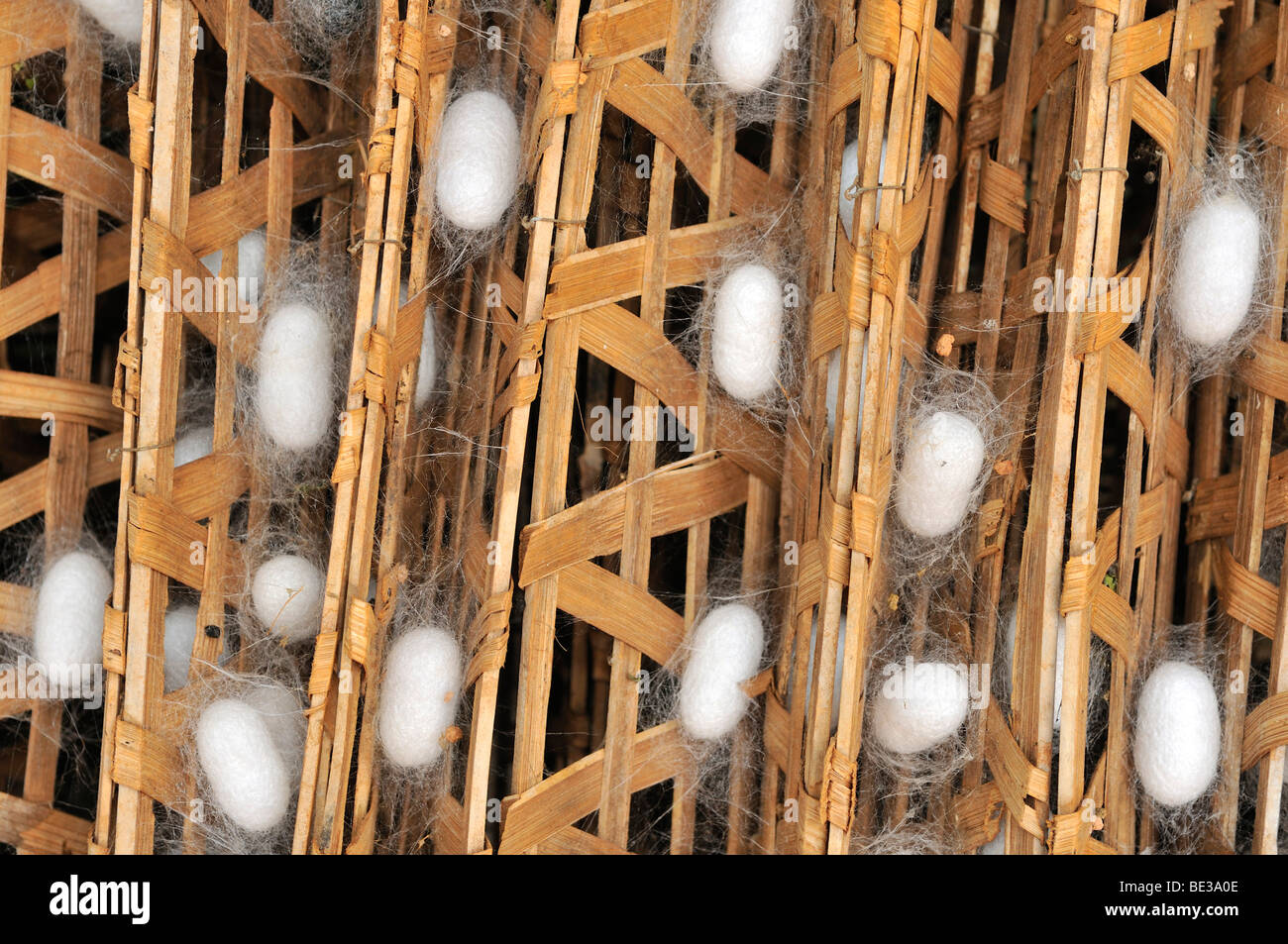 Sericulture, silk farming, silk cocoons, Dalat capital, Central Highlands, Vietnam, Asia Stock Photohttps://www.alamy.com/image-license-details/?v=1https://www.alamy.com/stock-photo-sericulture-silk-farming-silk-cocoons-dalat-capital-central-highlands-25889262.html
Sericulture, silk farming, silk cocoons, Dalat capital, Central Highlands, Vietnam, Asia Stock Photohttps://www.alamy.com/image-license-details/?v=1https://www.alamy.com/stock-photo-sericulture-silk-farming-silk-cocoons-dalat-capital-central-highlands-25889262.htmlRFBE3A0E–Sericulture, silk farming, silk cocoons, Dalat capital, Central Highlands, Vietnam, Asia
 Abstract background of sericulture, soft focus. Stock Photohttps://www.alamy.com/image-license-details/?v=1https://www.alamy.com/abstract-background-of-sericulture-soft-focus-image185930631.html
Abstract background of sericulture, soft focus. Stock Photohttps://www.alamy.com/image-license-details/?v=1https://www.alamy.com/abstract-background-of-sericulture-soft-focus-image185930631.htmlRFMPDTBK–Abstract background of sericulture, soft focus.
 Bursa, Turkey – November 11, 2020. Surviving walls of Ipeker sericulture and silk factory in the courtyard of Tofas Museum of Anatolian Carriages in B Stock Photohttps://www.alamy.com/image-license-details/?v=1https://www.alamy.com/bursa-turkey-november-11-2020-surviving-walls-of-ipeker-sericulture-and-silk-factory-in-the-courtyard-of-tofas-museum-of-anatolian-carriages-in-b-image450394092.html
Bursa, Turkey – November 11, 2020. Surviving walls of Ipeker sericulture and silk factory in the courtyard of Tofas Museum of Anatolian Carriages in B Stock Photohttps://www.alamy.com/image-license-details/?v=1https://www.alamy.com/bursa-turkey-november-11-2020-surviving-walls-of-ipeker-sericulture-and-silk-factory-in-the-courtyard-of-tofas-museum-of-anatolian-carriages-in-b-image450394092.htmlRF2H4N678–Bursa, Turkey – November 11, 2020. Surviving walls of Ipeker sericulture and silk factory in the courtyard of Tofas Museum of Anatolian Carriages in B
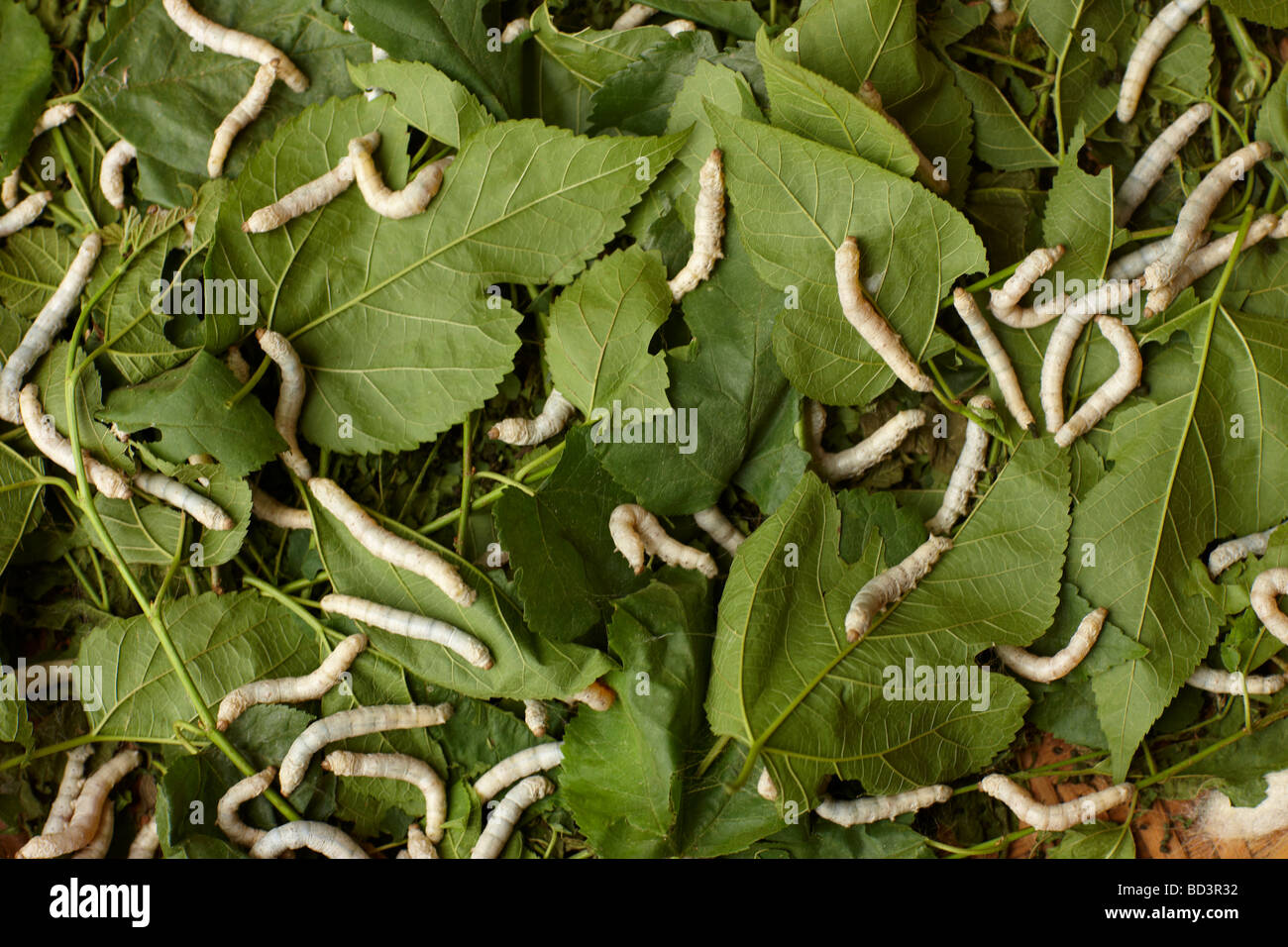 silk worms at a weaving centre in Luang Prabang, Laos Stock Photohttps://www.alamy.com/image-license-details/?v=1https://www.alamy.com/stock-photo-silk-worms-at-a-weaving-centre-in-luang-prabang-laos-25284870.html
silk worms at a weaving centre in Luang Prabang, Laos Stock Photohttps://www.alamy.com/image-license-details/?v=1https://www.alamy.com/stock-photo-silk-worms-at-a-weaving-centre-in-luang-prabang-laos-25284870.htmlRMBD3R32–silk worms at a weaving centre in Luang Prabang, Laos
 Signs ousside the Govt of Assam Sericulture department office of the Extension officer Twisting Plant in Sualkuchi, Assam, India. Sualkuchi is a small Stock Photohttps://www.alamy.com/image-license-details/?v=1https://www.alamy.com/signs-ousside-the-govt-of-assam-sericulture-department-office-of-the-extension-officer-twisting-plant-in-sualkuchi-assam-india-sualkuchi-is-a-small-image560348710.html
Signs ousside the Govt of Assam Sericulture department office of the Extension officer Twisting Plant in Sualkuchi, Assam, India. Sualkuchi is a small Stock Photohttps://www.alamy.com/image-license-details/?v=1https://www.alamy.com/signs-ousside-the-govt-of-assam-sericulture-department-office-of-the-extension-officer-twisting-plant-in-sualkuchi-assam-india-sualkuchi-is-a-small-image560348710.htmlRM2RFJ2DX–Signs ousside the Govt of Assam Sericulture department office of the Extension officer Twisting Plant in Sualkuchi, Assam, India. Sualkuchi is a small
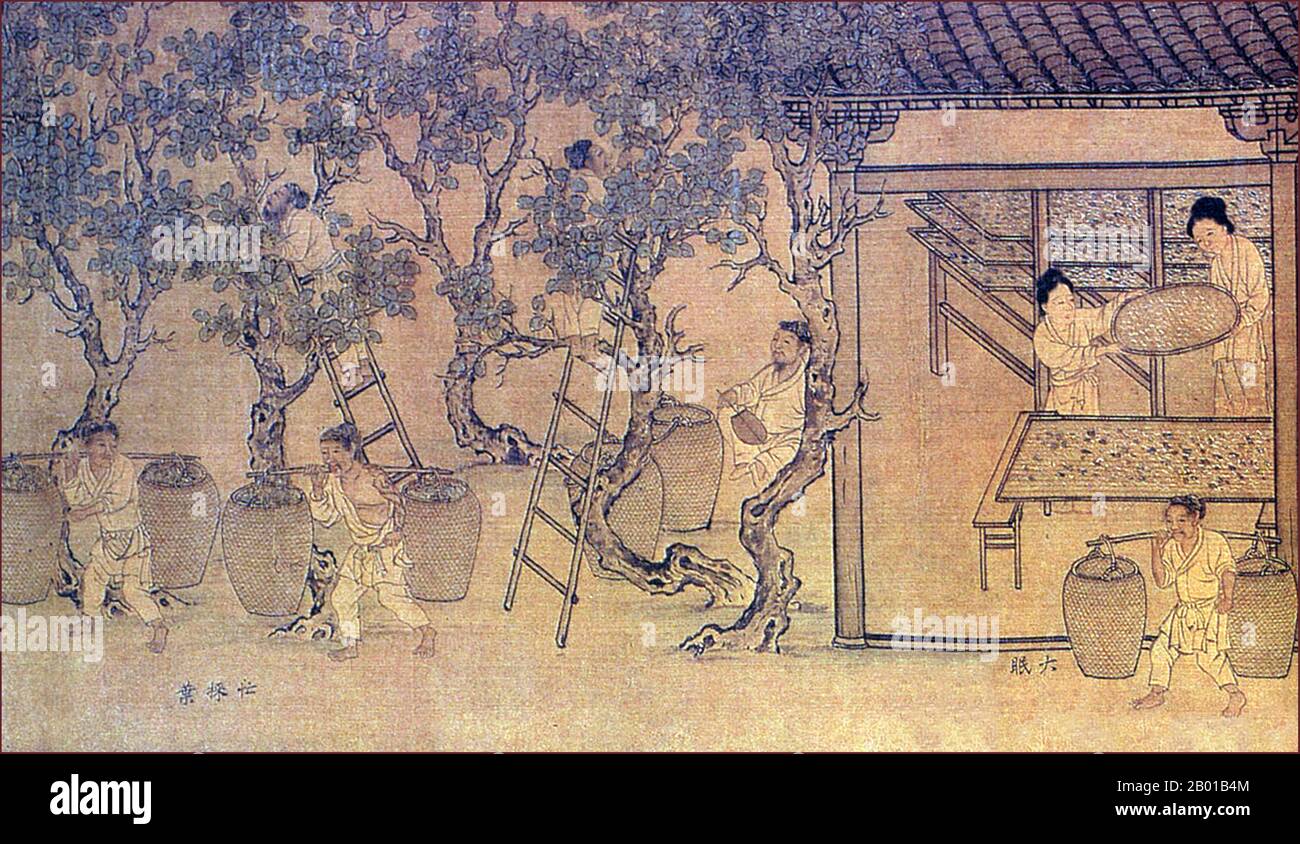 China: The Art of Making Silk (1) - Picking and sorting mulberry leaves. Detail from a Song Dynasty (960-1279) handscroll painting, 11th century. In China, silk worm farming was originally restricted to women, and many women were employed in the silk-making industry. Even though some saw this development of a luxury product as useless, silk provoked such a craze among high society that the laws were used to regulate and limit its use to the members of the imperial family. For approximately a millennium, the right to wear silk was reserved for the emperor and the highest dignitaries. Stock Photohttps://www.alamy.com/image-license-details/?v=1https://www.alamy.com/china-the-art-of-making-silk-1-picking-and-sorting-mulberry-leaves-detail-from-a-song-dynasty-960-1279-handscroll-painting-11th-century-in-china-silk-worm-farming-was-originally-restricted-to-women-and-many-women-were-employed-in-the-silk-making-industry-even-though-some-saw-this-development-of-a-luxury-product-as-useless-silk-provoked-such-a-craze-among-high-society-that-the-laws-were-used-to-regulate-and-limit-its-use-to-the-members-of-the-imperial-family-for-approximately-a-millennium-the-right-to-wear-silk-was-reserved-for-the-emperor-and-the-highest-dignitaries-image344238068.html
China: The Art of Making Silk (1) - Picking and sorting mulberry leaves. Detail from a Song Dynasty (960-1279) handscroll painting, 11th century. In China, silk worm farming was originally restricted to women, and many women were employed in the silk-making industry. Even though some saw this development of a luxury product as useless, silk provoked such a craze among high society that the laws were used to regulate and limit its use to the members of the imperial family. For approximately a millennium, the right to wear silk was reserved for the emperor and the highest dignitaries. Stock Photohttps://www.alamy.com/image-license-details/?v=1https://www.alamy.com/china-the-art-of-making-silk-1-picking-and-sorting-mulberry-leaves-detail-from-a-song-dynasty-960-1279-handscroll-painting-11th-century-in-china-silk-worm-farming-was-originally-restricted-to-women-and-many-women-were-employed-in-the-silk-making-industry-even-though-some-saw-this-development-of-a-luxury-product-as-useless-silk-provoked-such-a-craze-among-high-society-that-the-laws-were-used-to-regulate-and-limit-its-use-to-the-members-of-the-imperial-family-for-approximately-a-millennium-the-right-to-wear-silk-was-reserved-for-the-emperor-and-the-highest-dignitaries-image344238068.htmlRM2B01B4M–China: The Art of Making Silk (1) - Picking and sorting mulberry leaves. Detail from a Song Dynasty (960-1279) handscroll painting, 11th century. In China, silk worm farming was originally restricted to women, and many women were employed in the silk-making industry. Even though some saw this development of a luxury product as useless, silk provoked such a craze among high society that the laws were used to regulate and limit its use to the members of the imperial family. For approximately a millennium, the right to wear silk was reserved for the emperor and the highest dignitaries.
 Turkish Silk Farmer or Peasant Carrying Bag of Silk Cocoons to the Silk Market in Koza Han, Bursa, Turkey Stock Photohttps://www.alamy.com/image-license-details/?v=1https://www.alamy.com/stock-photo-turkish-silk-farmer-or-peasant-carrying-bag-of-silk-cocoons-to-the-170367050.html
Turkish Silk Farmer or Peasant Carrying Bag of Silk Cocoons to the Silk Market in Koza Han, Bursa, Turkey Stock Photohttps://www.alamy.com/image-license-details/?v=1https://www.alamy.com/stock-photo-turkish-silk-farmer-or-peasant-carrying-bag-of-silk-cocoons-to-the-170367050.htmlRMKW4TWE–Turkish Silk Farmer or Peasant Carrying Bag of Silk Cocoons to the Silk Market in Koza Han, Bursa, Turkey
 China Sericulture Silkworm culture. Winding silk onto reels from water bath 1748 Stock Photohttps://www.alamy.com/image-license-details/?v=1https://www.alamy.com/china-sericulture-silkworm-culture-winding-silk-onto-reels-from-water-bath-1748-image242613426.html
China Sericulture Silkworm culture. Winding silk onto reels from water bath 1748 Stock Photohttps://www.alamy.com/image-license-details/?v=1https://www.alamy.com/china-sericulture-silkworm-culture-winding-silk-onto-reels-from-water-bath-1748-image242613426.htmlRFT2KYW6–China Sericulture Silkworm culture. Winding silk onto reels from water bath 1748
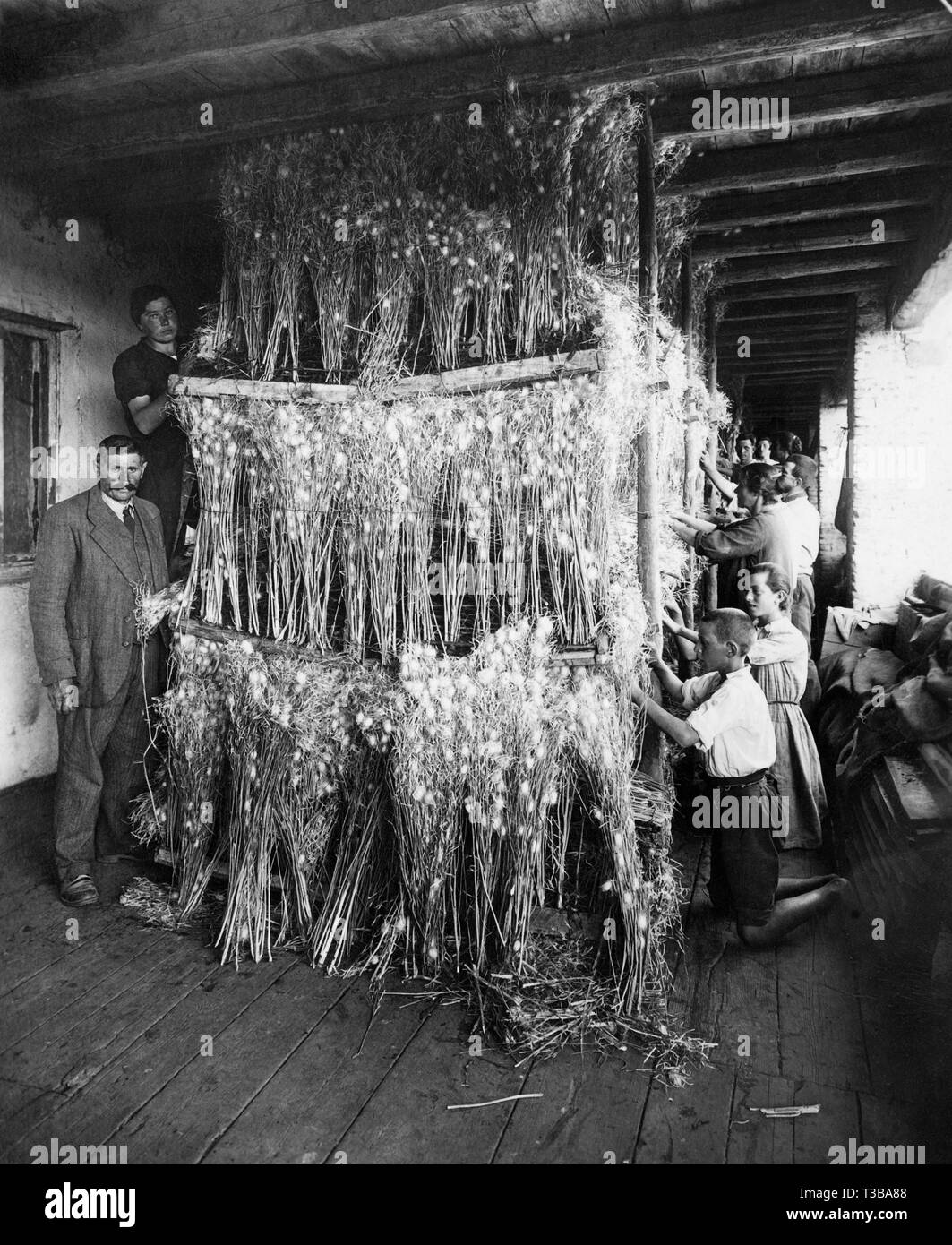 sericulture Stock Photohttps://www.alamy.com/image-license-details/?v=1https://www.alamy.com/sericulture-image243038664.html
sericulture Stock Photohttps://www.alamy.com/image-license-details/?v=1https://www.alamy.com/sericulture-image243038664.htmlRMT3BA88–sericulture
 Close-up of silkworms 'Bombyx mori' feeding on White Mulberry 'Morus alba' leaves, Hoi An, Quang Nam Province. Stock Photohttps://www.alamy.com/image-license-details/?v=1https://www.alamy.com/stock-photo-close-up-of-silkworms-bombyx-mori-feeding-on-white-mulberry-morus-172080280.html
Close-up of silkworms 'Bombyx mori' feeding on White Mulberry 'Morus alba' leaves, Hoi An, Quang Nam Province. Stock Photohttps://www.alamy.com/image-license-details/?v=1https://www.alamy.com/stock-photo-close-up-of-silkworms-bombyx-mori-feeding-on-white-mulberry-morus-172080280.htmlRMKYXX48–Close-up of silkworms 'Bombyx mori' feeding on White Mulberry 'Morus alba' leaves, Hoi An, Quang Nam Province.
 working with silk thread at the Queen Sirikit Sericulture Center in Surin Thailand Stock Photohttps://www.alamy.com/image-license-details/?v=1https://www.alamy.com/stock-photo-working-with-silk-thread-at-the-queen-sirikit-sericulture-center-in-20452690.html
working with silk thread at the Queen Sirikit Sericulture Center in Surin Thailand Stock Photohttps://www.alamy.com/image-license-details/?v=1https://www.alamy.com/stock-photo-working-with-silk-thread-at-the-queen-sirikit-sericulture-center-in-20452690.htmlRMB57KH6–working with silk thread at the Queen Sirikit Sericulture Center in Surin Thailand
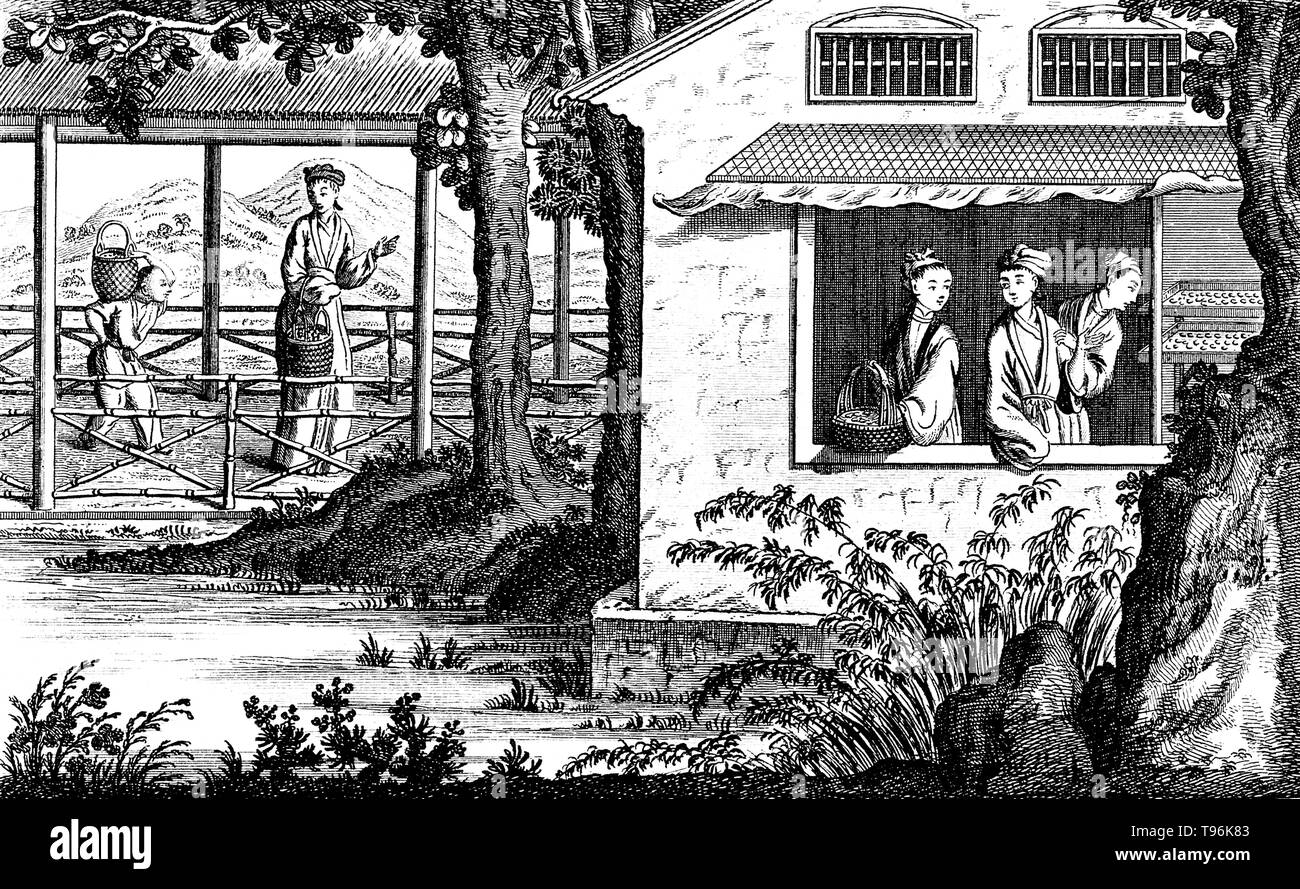 Textiles: silk manufacture in China, gathering the eggs. The production of silk originates in China in prehistoric times. Silk remained confined to China until the Silk Road opened at some point during the later half of the first millennium BC. China maintained its virtual monopoly over silk production for another thousand years. Sericulture, or silk farming, is the cultivation of silkworms to produce silk. Stock Photohttps://www.alamy.com/image-license-details/?v=1https://www.alamy.com/textiles-silk-manufacture-in-china-gathering-the-eggs-the-production-of-silk-originates-in-china-in-prehistoric-times-silk-remained-confined-to-china-until-the-silk-road-opened-at-some-point-during-the-later-half-of-the-first-millennium-bc-china-maintained-its-virtual-monopoly-over-silk-production-for-another-thousand-years-sericulture-or-silk-farming-is-the-cultivation-of-silkworms-to-produce-silk-image246623891.html
Textiles: silk manufacture in China, gathering the eggs. The production of silk originates in China in prehistoric times. Silk remained confined to China until the Silk Road opened at some point during the later half of the first millennium BC. China maintained its virtual monopoly over silk production for another thousand years. Sericulture, or silk farming, is the cultivation of silkworms to produce silk. Stock Photohttps://www.alamy.com/image-license-details/?v=1https://www.alamy.com/textiles-silk-manufacture-in-china-gathering-the-eggs-the-production-of-silk-originates-in-china-in-prehistoric-times-silk-remained-confined-to-china-until-the-silk-road-opened-at-some-point-during-the-later-half-of-the-first-millennium-bc-china-maintained-its-virtual-monopoly-over-silk-production-for-another-thousand-years-sericulture-or-silk-farming-is-the-cultivation-of-silkworms-to-produce-silk-image246623891.htmlRMT96K83–Textiles: silk manufacture in China, gathering the eggs. The production of silk originates in China in prehistoric times. Silk remained confined to China until the Silk Road opened at some point during the later half of the first millennium BC. China maintained its virtual monopoly over silk production for another thousand years. Sericulture, or silk farming, is the cultivation of silkworms to produce silk.
 Woman feeding silkworms with mulberry leaves at a village womens cooperative venture. Shiapur, Bangladesh Stock Photohttps://www.alamy.com/image-license-details/?v=1https://www.alamy.com/stock-photo-woman-feeding-silkworms-with-mulberry-leaves-at-a-village-womens-cooperative-54065584.html
Woman feeding silkworms with mulberry leaves at a village womens cooperative venture. Shiapur, Bangladesh Stock Photohttps://www.alamy.com/image-license-details/?v=1https://www.alamy.com/stock-photo-woman-feeding-silkworms-with-mulberry-leaves-at-a-village-womens-cooperative-54065584.htmlRMD3XW5M–Woman feeding silkworms with mulberry leaves at a village womens cooperative venture. Shiapur, Bangladesh
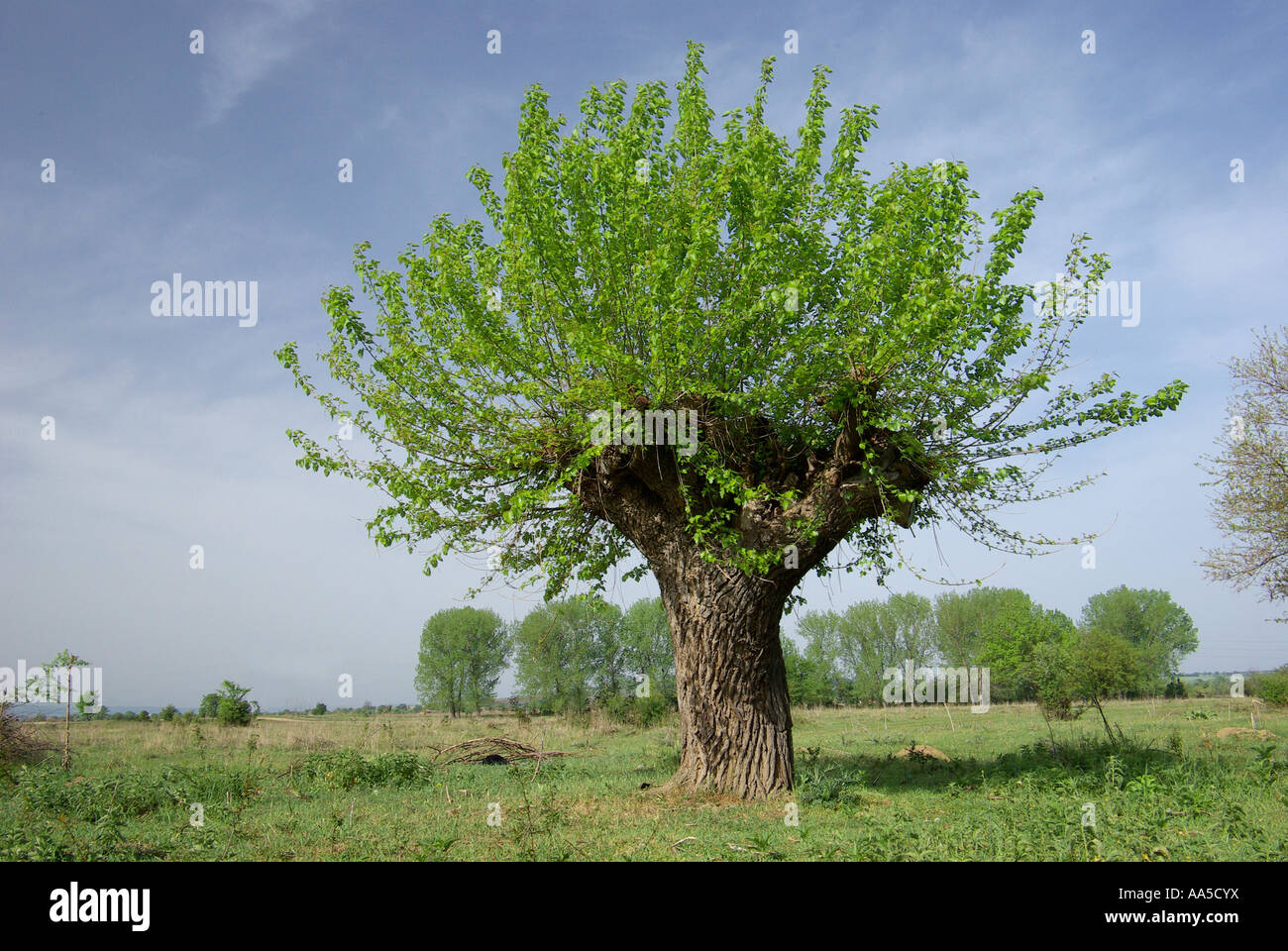 Young branches of an old mulberry tree. Stock Photohttps://www.alamy.com/image-license-details/?v=1https://www.alamy.com/stock-photo-young-branches-of-an-old-mulberry-tree-12520141.html
Young branches of an old mulberry tree. Stock Photohttps://www.alamy.com/image-license-details/?v=1https://www.alamy.com/stock-photo-young-branches-of-an-old-mulberry-tree-12520141.htmlRFAA5CYX–Young branches of an old mulberry tree.
![[ 1910s Japan - Japanese Silk Farming ] — A woman shows silk cocoons. This postcard is from a series about sericulture, showing the steps involved in making silk. This is card 8. 20th century vintage postcard. Stock Photo [ 1910s Japan - Japanese Silk Farming ] — A woman shows silk cocoons. This postcard is from a series about sericulture, showing the steps involved in making silk. This is card 8. 20th century vintage postcard. Stock Photo](https://c8.alamy.com/comp/2BKNA9R/1910s-japan-japanese-silk-farming-a-woman-shows-silk-cocoons-this-postcard-is-from-a-series-about-sericulture-showing-the-steps-involved-in-making-silk-this-is-card-8-20th-century-vintage-postcard-2BKNA9R.jpg) [ 1910s Japan - Japanese Silk Farming ] — A woman shows silk cocoons. This postcard is from a series about sericulture, showing the steps involved in making silk. This is card 8. 20th century vintage postcard. Stock Photohttps://www.alamy.com/image-license-details/?v=1https://www.alamy.com/1910s-japan-japanese-silk-farming-a-woman-shows-silk-cocoons-this-postcard-is-from-a-series-about-sericulture-showing-the-steps-involved-in-making-silk-this-is-card-8-20th-century-vintage-postcard-image356354931.html
[ 1910s Japan - Japanese Silk Farming ] — A woman shows silk cocoons. This postcard is from a series about sericulture, showing the steps involved in making silk. This is card 8. 20th century vintage postcard. Stock Photohttps://www.alamy.com/image-license-details/?v=1https://www.alamy.com/1910s-japan-japanese-silk-farming-a-woman-shows-silk-cocoons-this-postcard-is-from-a-series-about-sericulture-showing-the-steps-involved-in-making-silk-this-is-card-8-20th-century-vintage-postcard-image356354931.htmlRM2BKNA9R–[ 1910s Japan - Japanese Silk Farming ] — A woman shows silk cocoons. This postcard is from a series about sericulture, showing the steps involved in making silk. This is card 8. 20th century vintage postcard.
 Sericulture woman spreading mulberry leaves to feed silkworms India Asia Stock Photohttps://www.alamy.com/image-license-details/?v=1https://www.alamy.com/stock-photo-sericulture-woman-spreading-mulberry-leaves-to-feed-silkworms-india-83624129.html
Sericulture woman spreading mulberry leaves to feed silkworms India Asia Stock Photohttps://www.alamy.com/image-license-details/?v=1https://www.alamy.com/stock-photo-sericulture-woman-spreading-mulberry-leaves-to-feed-silkworms-india-83624129.htmlRMET1BC1–Sericulture woman spreading mulberry leaves to feed silkworms India Asia
 Sericulture, Unwinding Cocoons, Jan van der Straet, called Stradanus, Flemish, 1523–1605, Pen and brown ink on white laid paper, Horizontal rectangle. Verso: Several women are seated at tables on which the silk worm cocoons are place, and are in the process of unwinding the cocoons, the thread being wound on large spools. Woman stands at right, holding a child in her arms. Another tends the fire in left foreground., Netherlands, ca. 1590, figures, Drawing Stock Photohttps://www.alamy.com/image-license-details/?v=1https://www.alamy.com/sericulture-unwinding-cocoons-jan-van-der-straet-called-stradanus-flemish-15231605-pen-and-brown-ink-on-white-laid-paper-horizontal-rectangle-verso-several-women-are-seated-at-tables-on-which-the-silk-worm-cocoons-are-place-and-are-in-the-process-of-unwinding-the-cocoons-the-thread-being-wound-on-large-spools-woman-stands-at-right-holding-a-child-in-her-arms-another-tends-the-fire-in-left-foreground-netherlands-ca-1590-figures-drawing-image391581085.html
Sericulture, Unwinding Cocoons, Jan van der Straet, called Stradanus, Flemish, 1523–1605, Pen and brown ink on white laid paper, Horizontal rectangle. Verso: Several women are seated at tables on which the silk worm cocoons are place, and are in the process of unwinding the cocoons, the thread being wound on large spools. Woman stands at right, holding a child in her arms. Another tends the fire in left foreground., Netherlands, ca. 1590, figures, Drawing Stock Photohttps://www.alamy.com/image-license-details/?v=1https://www.alamy.com/sericulture-unwinding-cocoons-jan-van-der-straet-called-stradanus-flemish-15231605-pen-and-brown-ink-on-white-laid-paper-horizontal-rectangle-verso-several-women-are-seated-at-tables-on-which-the-silk-worm-cocoons-are-place-and-are-in-the-process-of-unwinding-the-cocoons-the-thread-being-wound-on-large-spools-woman-stands-at-right-holding-a-child-in-her-arms-another-tends-the-fire-in-left-foreground-netherlands-ca-1590-figures-drawing-image391581085.htmlRM2DN21JN–Sericulture, Unwinding Cocoons, Jan van der Straet, called Stradanus, Flemish, 1523–1605, Pen and brown ink on white laid paper, Horizontal rectangle. Verso: Several women are seated at tables on which the silk worm cocoons are place, and are in the process of unwinding the cocoons, the thread being wound on large spools. Woman stands at right, holding a child in her arms. Another tends the fire in left foreground., Netherlands, ca. 1590, figures, Drawing
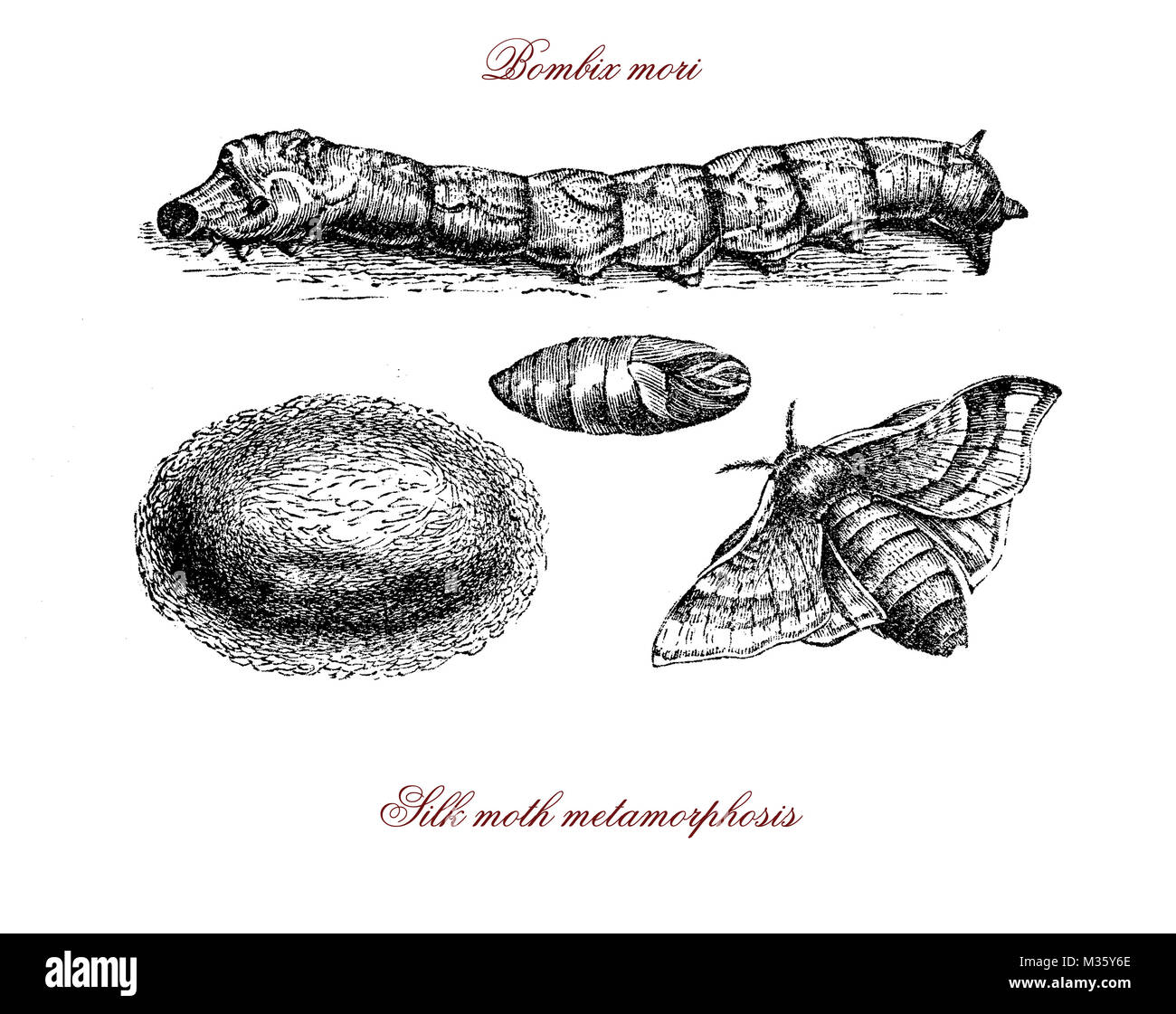 Bombix mori, silkworm, cocoon, silk moth metamorphosis vintage engraving Stock Photohttps://www.alamy.com/image-license-details/?v=1https://www.alamy.com/stock-photo-bombix-mori-silkworm-cocoon-silk-moth-metamorphosis-vintage-engraving-174078758.html
Bombix mori, silkworm, cocoon, silk moth metamorphosis vintage engraving Stock Photohttps://www.alamy.com/image-license-details/?v=1https://www.alamy.com/stock-photo-bombix-mori-silkworm-cocoon-silk-moth-metamorphosis-vintage-engraving-174078758.htmlRFM35Y6E–Bombix mori, silkworm, cocoon, silk moth metamorphosis vintage engraving
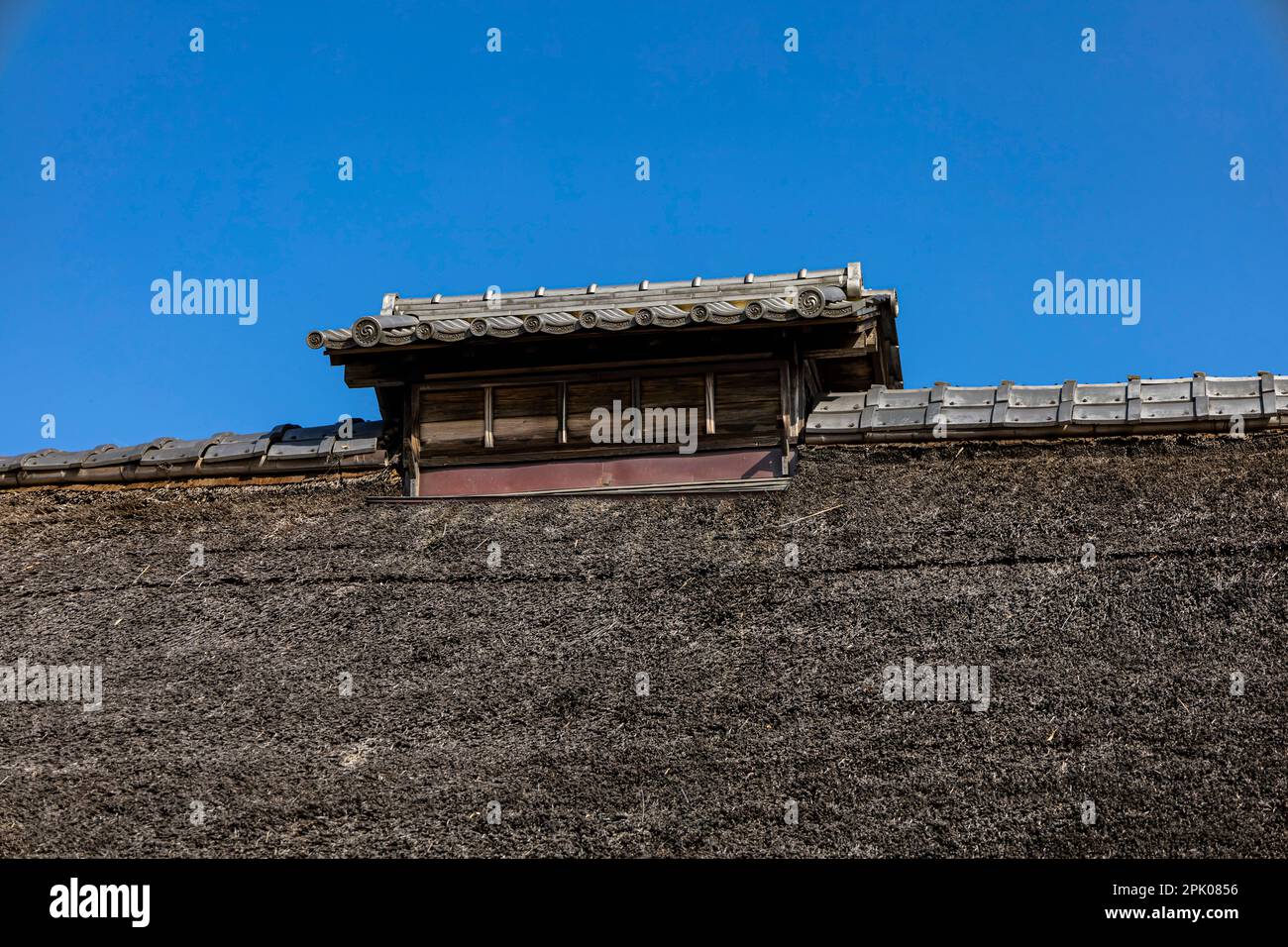 Small roof top of sericulture room, old farmers house, thatched roof, Jidayubori park, Kitami, Setagaya Ku, Tokyo, Japan, East Asia, Asia Stock Photohttps://www.alamy.com/image-license-details/?v=1https://www.alamy.com/small-roof-top-of-sericulture-room-old-farmers-house-thatched-roof-jidayubori-park-kitami-setagaya-ku-tokyo-japan-east-asia-asia-image545206290.html
Small roof top of sericulture room, old farmers house, thatched roof, Jidayubori park, Kitami, Setagaya Ku, Tokyo, Japan, East Asia, Asia Stock Photohttps://www.alamy.com/image-license-details/?v=1https://www.alamy.com/small-roof-top-of-sericulture-room-old-farmers-house-thatched-roof-jidayubori-park-kitami-setagaya-ku-tokyo-japan-east-asia-asia-image545206290.htmlRM2PK0856–Small roof top of sericulture room, old farmers house, thatched roof, Jidayubori park, Kitami, Setagaya Ku, Tokyo, Japan, East Asia, Asia
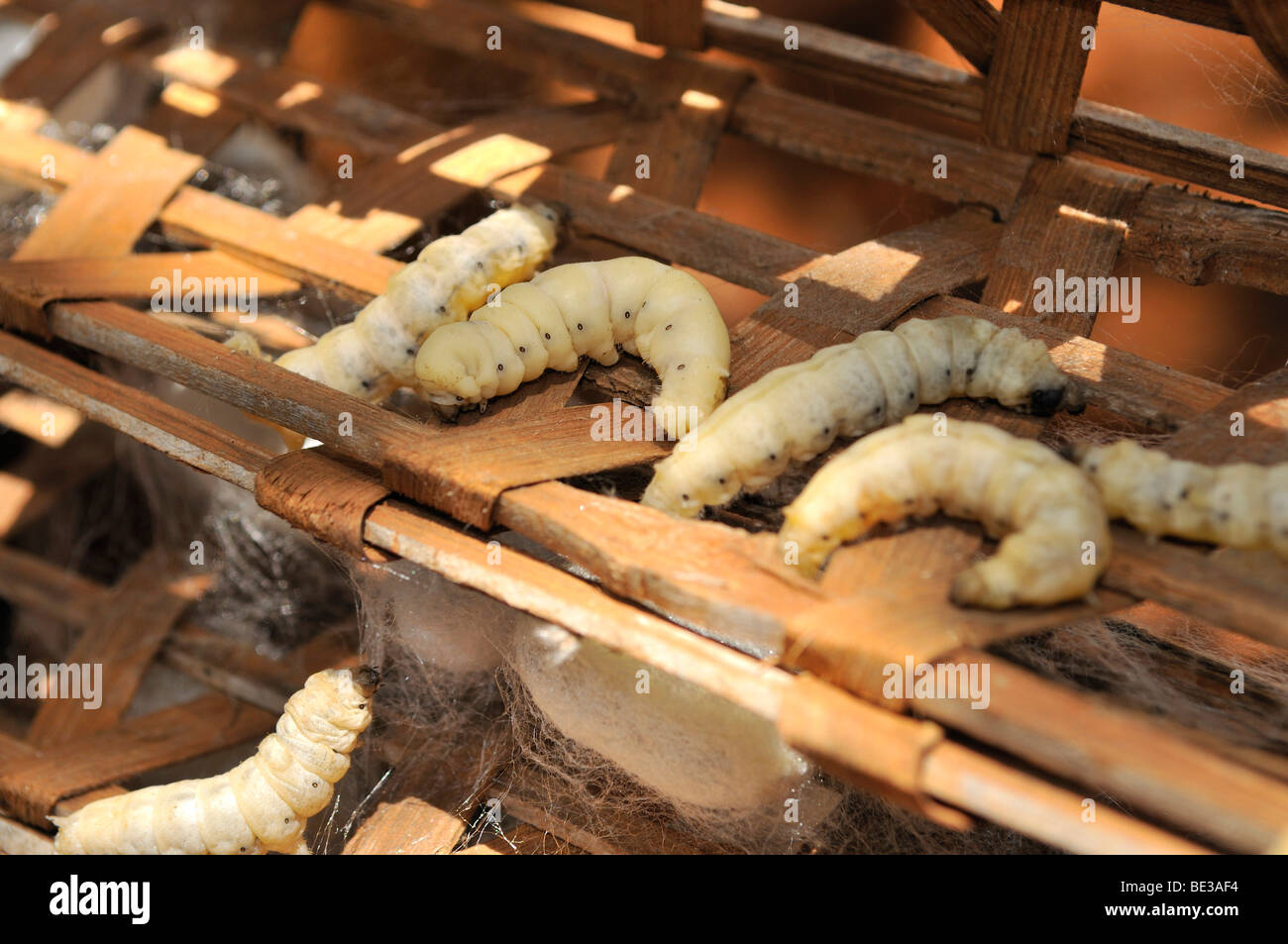 Silkworms (Bombyx mori), sericulture, silk farming, Dalat capital, Central Highlands, Vietnam, Asia Stock Photohttps://www.alamy.com/image-license-details/?v=1https://www.alamy.com/stock-photo-silkworms-bombyx-mori-sericulture-silk-farming-dalat-capital-central-25889672.html
Silkworms (Bombyx mori), sericulture, silk farming, Dalat capital, Central Highlands, Vietnam, Asia Stock Photohttps://www.alamy.com/image-license-details/?v=1https://www.alamy.com/stock-photo-silkworms-bombyx-mori-sericulture-silk-farming-dalat-capital-central-25889672.htmlRFBE3AF4–Silkworms (Bombyx mori), sericulture, silk farming, Dalat capital, Central Highlands, Vietnam, Asia
 SONY DSCGreat mulberry isolated on white background Stock Photohttps://www.alamy.com/image-license-details/?v=1https://www.alamy.com/sony-dscgreat-mulberry-isolated-on-white-background-image379263146.html
SONY DSCGreat mulberry isolated on white background Stock Photohttps://www.alamy.com/image-license-details/?v=1https://www.alamy.com/sony-dscgreat-mulberry-isolated-on-white-background-image379263146.htmlRF2D10X0A–SONY DSCGreat mulberry isolated on white background
 Bobbins with High qualty natural Thai Silk at one of the Chang Mai Silk producers ready to be woven into exquisite designs. Stock Photohttps://www.alamy.com/image-license-details/?v=1https://www.alamy.com/bobbins-with-high-qualty-natural-thai-silk-at-one-of-the-chang-mai-image9198838.html
Bobbins with High qualty natural Thai Silk at one of the Chang Mai Silk producers ready to be woven into exquisite designs. Stock Photohttps://www.alamy.com/image-license-details/?v=1https://www.alamy.com/bobbins-with-high-qualty-natural-thai-silk-at-one-of-the-chang-mai-image9198838.htmlRMARNNK7–Bobbins with High qualty natural Thai Silk at one of the Chang Mai Silk producers ready to be woven into exquisite designs.
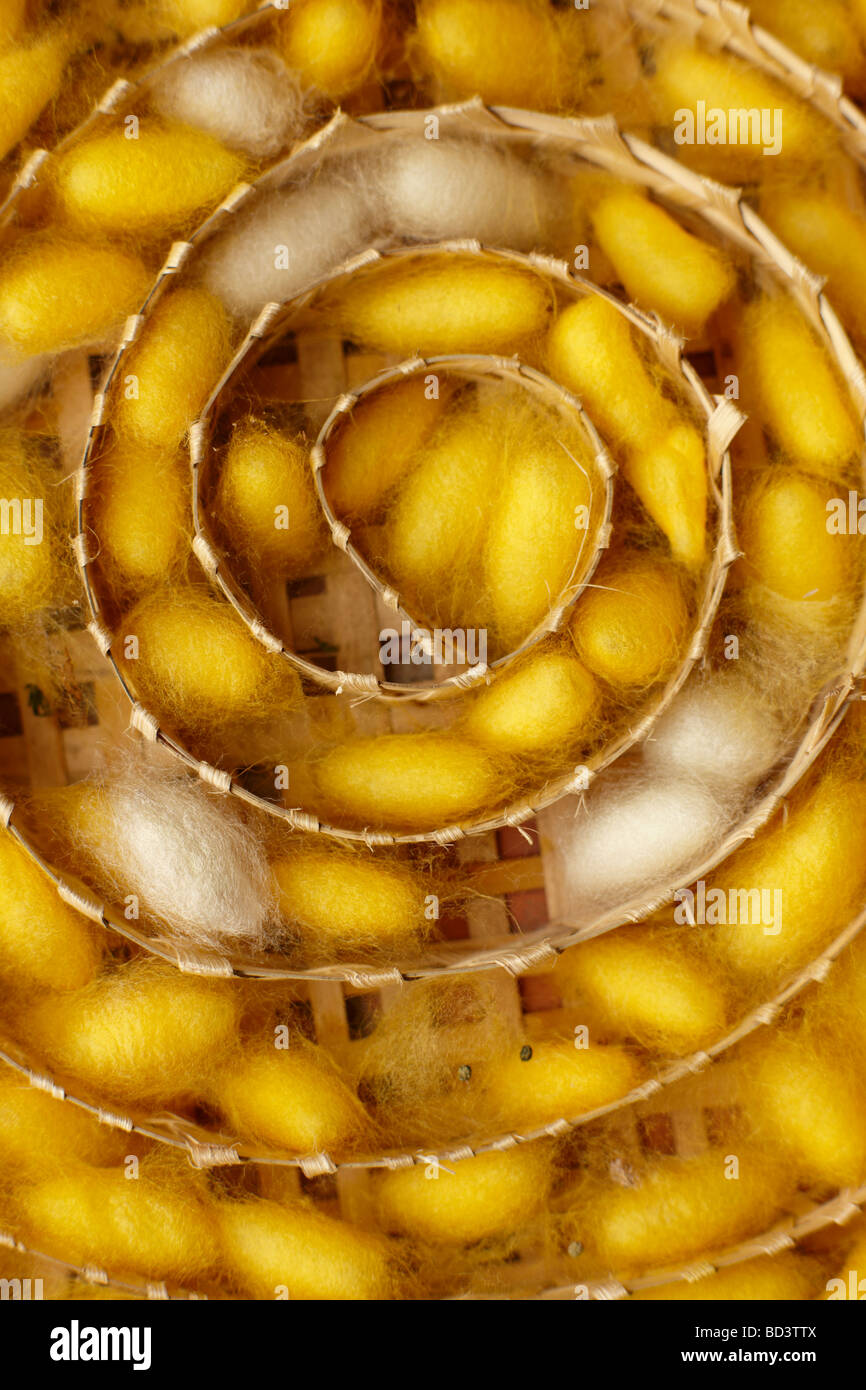 silk worm cocoons at a weaving centre in Luang Prabang, Laos Stock Photohttps://www.alamy.com/image-license-details/?v=1https://www.alamy.com/stock-photo-silk-worm-cocoons-at-a-weaving-centre-in-luang-prabang-laos-25286266.html
silk worm cocoons at a weaving centre in Luang Prabang, Laos Stock Photohttps://www.alamy.com/image-license-details/?v=1https://www.alamy.com/stock-photo-silk-worm-cocoons-at-a-weaving-centre-in-luang-prabang-laos-25286266.htmlRMBD3TTX–silk worm cocoons at a weaving centre in Luang Prabang, Laos
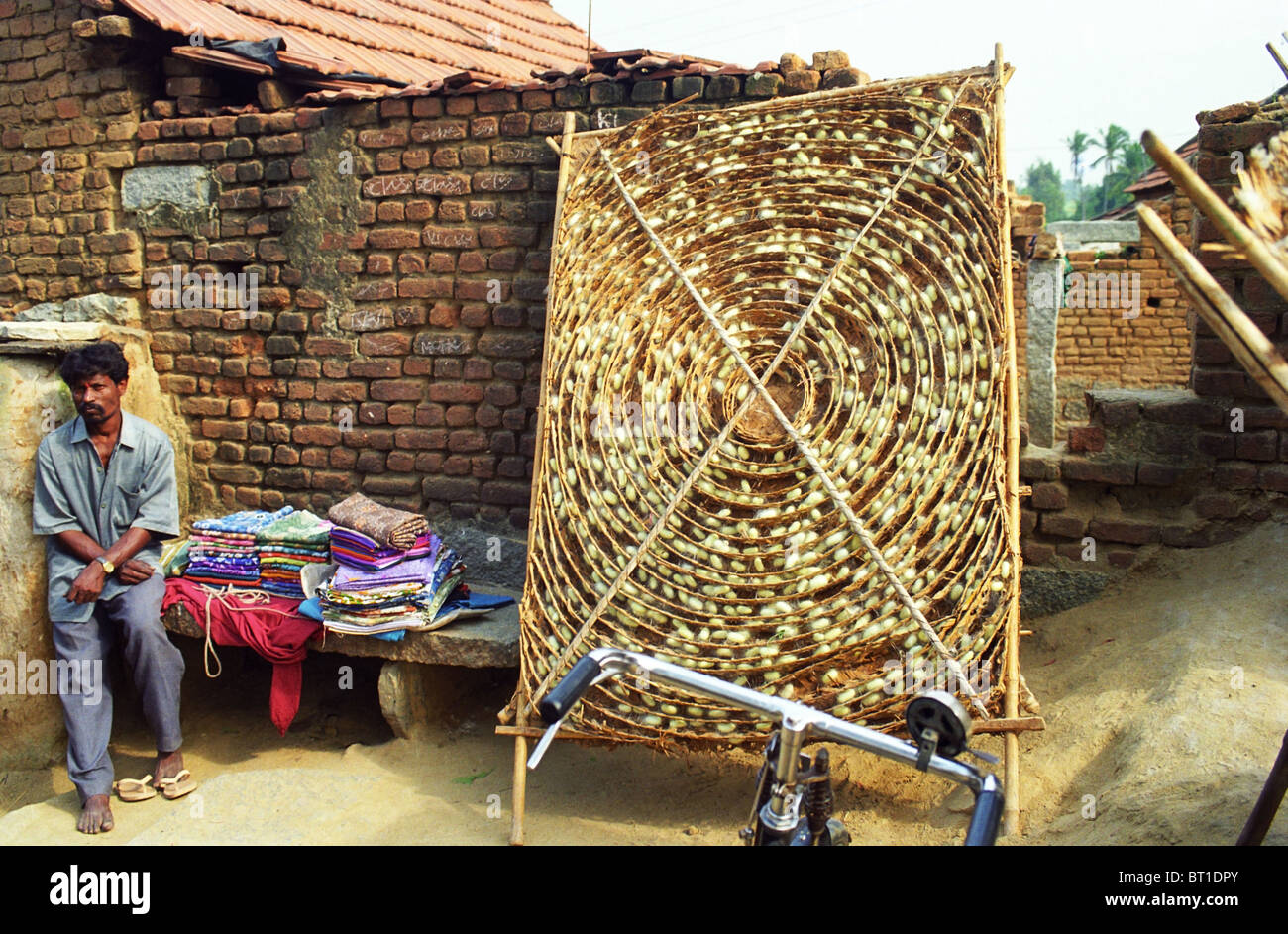 Silk worm cocoons in a small village in south India. Stock Photohttps://www.alamy.com/image-license-details/?v=1https://www.alamy.com/stock-photo-silk-worm-cocoons-in-a-small-village-in-south-india-31994899.html
Silk worm cocoons in a small village in south India. Stock Photohttps://www.alamy.com/image-license-details/?v=1https://www.alamy.com/stock-photo-silk-worm-cocoons-in-a-small-village-in-south-india-31994899.htmlRMBT1DPY–Silk worm cocoons in a small village in south India.
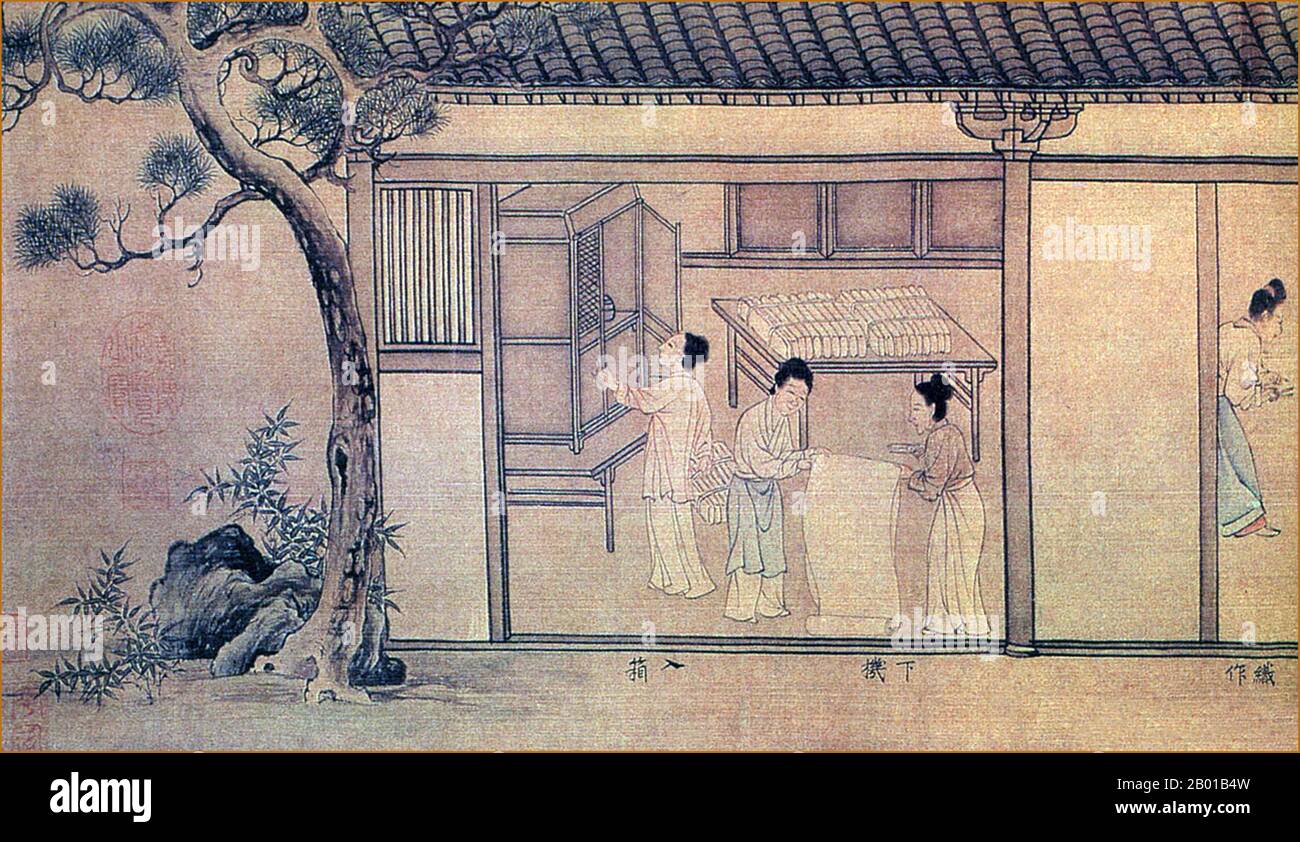 China: The Art of Making Silk (3) - Folding and storing bales of silk. Detail from a Song Dynasty (960-1279) handscroll painting, 11th century. In China, silk worm farming was originally restricted to women, and many women were employed in the silk-making industry. Even though some saw this development of a luxury product as useless, silk provoked such a craze among high society that the laws were used to regulate and limit its use to the members of the imperial family. For approximately a millennium, the right to wear silk was reserved for the emperor and the highest dignitaries Stock Photohttps://www.alamy.com/image-license-details/?v=1https://www.alamy.com/china-the-art-of-making-silk-3-folding-and-storing-bales-of-silk-detail-from-a-song-dynasty-960-1279-handscroll-painting-11th-century-in-china-silk-worm-farming-was-originally-restricted-to-women-and-many-women-were-employed-in-the-silk-making-industry-even-though-some-saw-this-development-of-a-luxury-product-as-useless-silk-provoked-such-a-craze-among-high-society-that-the-laws-were-used-to-regulate-and-limit-its-use-to-the-members-of-the-imperial-family-for-approximately-a-millennium-the-right-to-wear-silk-was-reserved-for-the-emperor-and-the-highest-dignitaries-image344238073.html
China: The Art of Making Silk (3) - Folding and storing bales of silk. Detail from a Song Dynasty (960-1279) handscroll painting, 11th century. In China, silk worm farming was originally restricted to women, and many women were employed in the silk-making industry. Even though some saw this development of a luxury product as useless, silk provoked such a craze among high society that the laws were used to regulate and limit its use to the members of the imperial family. For approximately a millennium, the right to wear silk was reserved for the emperor and the highest dignitaries Stock Photohttps://www.alamy.com/image-license-details/?v=1https://www.alamy.com/china-the-art-of-making-silk-3-folding-and-storing-bales-of-silk-detail-from-a-song-dynasty-960-1279-handscroll-painting-11th-century-in-china-silk-worm-farming-was-originally-restricted-to-women-and-many-women-were-employed-in-the-silk-making-industry-even-though-some-saw-this-development-of-a-luxury-product-as-useless-silk-provoked-such-a-craze-among-high-society-that-the-laws-were-used-to-regulate-and-limit-its-use-to-the-members-of-the-imperial-family-for-approximately-a-millennium-the-right-to-wear-silk-was-reserved-for-the-emperor-and-the-highest-dignitaries-image344238073.htmlRM2B01B4W–China: The Art of Making Silk (3) - Folding and storing bales of silk. Detail from a Song Dynasty (960-1279) handscroll painting, 11th century. In China, silk worm farming was originally restricted to women, and many women were employed in the silk-making industry. Even though some saw this development of a luxury product as useless, silk provoked such a craze among high society that the laws were used to regulate and limit its use to the members of the imperial family. For approximately a millennium, the right to wear silk was reserved for the emperor and the highest dignitaries
 Bags of Silk Cocoons at the Silk Cocoon Market Held Annually in July When Silk Farmers Gather to Sell their Silk Cocoons, in the Silk Bazaar, or Koza Han, Bursa, Turkey Stock Photohttps://www.alamy.com/image-license-details/?v=1https://www.alamy.com/stock-photo-bags-of-silk-cocoons-at-the-silk-cocoon-market-held-annually-in-july-94672130.html
Bags of Silk Cocoons at the Silk Cocoon Market Held Annually in July When Silk Farmers Gather to Sell their Silk Cocoons, in the Silk Bazaar, or Koza Han, Bursa, Turkey Stock Photohttps://www.alamy.com/image-license-details/?v=1https://www.alamy.com/stock-photo-bags-of-silk-cocoons-at-the-silk-cocoon-market-held-annually-in-july-94672130.htmlRMFE0K7E–Bags of Silk Cocoons at the Silk Cocoon Market Held Annually in July When Silk Farmers Gather to Sell their Silk Cocoons, in the Silk Bazaar, or Koza Han, Bursa, Turkey
 Natural silkworms cocoons sericulture breeding Stock Photohttps://www.alamy.com/image-license-details/?v=1https://www.alamy.com/natural-silkworms-cocoons-sericulture-breeding-image327679583.html
Natural silkworms cocoons sericulture breeding Stock Photohttps://www.alamy.com/image-license-details/?v=1https://www.alamy.com/natural-silkworms-cocoons-sericulture-breeding-image327679583.htmlRF2A132J7–Natural silkworms cocoons sericulture breeding
 leaves, preparation for silkworm Stock Photohttps://www.alamy.com/image-license-details/?v=1https://www.alamy.com/leaves-preparation-for-silkworm-image243038646.html
leaves, preparation for silkworm Stock Photohttps://www.alamy.com/image-license-details/?v=1https://www.alamy.com/leaves-preparation-for-silkworm-image243038646.htmlRMT3BA7J–leaves, preparation for silkworm
 Close-up of silkworms 'Bombyx mori' feeding on White Mulberry 'Morus alba' leaves, Hoi An, Quang Nam Province. Stock Photohttps://www.alamy.com/image-license-details/?v=1https://www.alamy.com/stock-photo-close-up-of-silkworms-bombyx-mori-feeding-on-white-mulberry-morus-172072856.html
Close-up of silkworms 'Bombyx mori' feeding on White Mulberry 'Morus alba' leaves, Hoi An, Quang Nam Province. Stock Photohttps://www.alamy.com/image-license-details/?v=1https://www.alamy.com/stock-photo-close-up-of-silkworms-bombyx-mori-feeding-on-white-mulberry-morus-172072856.htmlRMKYXGK4–Close-up of silkworms 'Bombyx mori' feeding on White Mulberry 'Morus alba' leaves, Hoi An, Quang Nam Province.
 silkworms at the Queen Sirikit Sericulture Center in Surin Thailand Stock Photohttps://www.alamy.com/image-license-details/?v=1https://www.alamy.com/stock-photo-silkworms-at-the-queen-sirikit-sericulture-center-in-surin-thailand-20502780.html
silkworms at the Queen Sirikit Sericulture Center in Surin Thailand Stock Photohttps://www.alamy.com/image-license-details/?v=1https://www.alamy.com/stock-photo-silkworms-at-the-queen-sirikit-sericulture-center-in-surin-thailand-20502780.htmlRFB59YE4–silkworms at the Queen Sirikit Sericulture Center in Surin Thailand
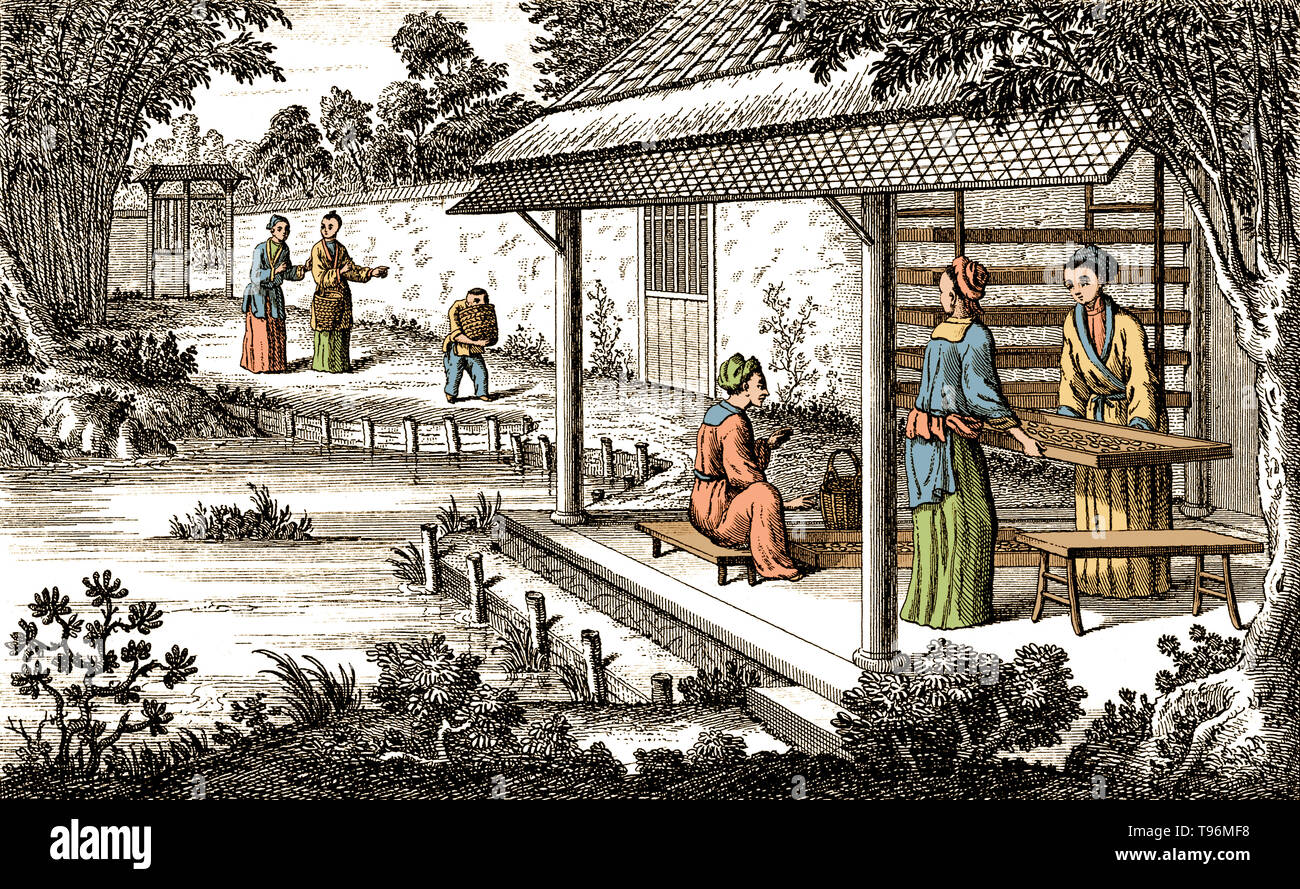 Textiles: silk manufacture in China, feeding the silkworms. The production of silk originates in China in prehistoric times. Silk remained confined to China until the Silk Road opened at some point during the later half of the first millennium BC. China maintained its virtual monopoly over silk production for another thousand years. Sericulture, or silk farming, is the cultivation of silkworms to produce silk. Stock Photohttps://www.alamy.com/image-license-details/?v=1https://www.alamy.com/textiles-silk-manufacture-in-china-feeding-the-silkworms-the-production-of-silk-originates-in-china-in-prehistoric-times-silk-remained-confined-to-china-until-the-silk-road-opened-at-some-point-during-the-later-half-of-the-first-millennium-bc-china-maintained-its-virtual-monopoly-over-silk-production-for-another-thousand-years-sericulture-or-silk-farming-is-the-cultivation-of-silkworms-to-produce-silk-image246624876.html
Textiles: silk manufacture in China, feeding the silkworms. The production of silk originates in China in prehistoric times. Silk remained confined to China until the Silk Road opened at some point during the later half of the first millennium BC. China maintained its virtual monopoly over silk production for another thousand years. Sericulture, or silk farming, is the cultivation of silkworms to produce silk. Stock Photohttps://www.alamy.com/image-license-details/?v=1https://www.alamy.com/textiles-silk-manufacture-in-china-feeding-the-silkworms-the-production-of-silk-originates-in-china-in-prehistoric-times-silk-remained-confined-to-china-until-the-silk-road-opened-at-some-point-during-the-later-half-of-the-first-millennium-bc-china-maintained-its-virtual-monopoly-over-silk-production-for-another-thousand-years-sericulture-or-silk-farming-is-the-cultivation-of-silkworms-to-produce-silk-image246624876.htmlRMT96MF8–Textiles: silk manufacture in China, feeding the silkworms. The production of silk originates in China in prehistoric times. Silk remained confined to China until the Silk Road opened at some point during the later half of the first millennium BC. China maintained its virtual monopoly over silk production for another thousand years. Sericulture, or silk farming, is the cultivation of silkworms to produce silk.
 Close-up of a chakra tray used in silkworm production. Bangalore, South India Stock Photohttps://www.alamy.com/image-license-details/?v=1https://www.alamy.com/close-up-of-a-chakra-tray-used-in-silkworm-production-bangalore-south-image4058410.html
Close-up of a chakra tray used in silkworm production. Bangalore, South India Stock Photohttps://www.alamy.com/image-license-details/?v=1https://www.alamy.com/close-up-of-a-chakra-tray-used-in-silkworm-production-bangalore-south-image4058410.htmlRMA9RW2B–Close-up of a chakra tray used in silkworm production. Bangalore, South India
 Young branch grew older instead cut branches. Stock Photohttps://www.alamy.com/image-license-details/?v=1https://www.alamy.com/stock-photo-young-branch-grew-older-instead-cut-branches-12520136.html
Young branch grew older instead cut branches. Stock Photohttps://www.alamy.com/image-license-details/?v=1https://www.alamy.com/stock-photo-young-branch-grew-older-instead-cut-branches-12520136.htmlRFAA5CYN–Young branch grew older instead cut branches.
![[ 1910s Japan - Japanese Silk Farming ] — Two women are feeding silkworms mulberry leaves. This postcard is from a series about sericulture, showing the steps involved in making silk. This is card 4. 20th century vintage postcard. Stock Photo [ 1910s Japan - Japanese Silk Farming ] — Two women are feeding silkworms mulberry leaves. This postcard is from a series about sericulture, showing the steps involved in making silk. This is card 4. 20th century vintage postcard. Stock Photo](https://c8.alamy.com/comp/2BKNA3N/1910s-japan-japanese-silk-farming-two-women-are-feeding-silkworms-mulberry-leaves-this-postcard-is-from-a-series-about-sericulture-showing-the-steps-involved-in-making-silk-this-is-card-4-20th-century-vintage-postcard-2BKNA3N.jpg) [ 1910s Japan - Japanese Silk Farming ] — Two women are feeding silkworms mulberry leaves. This postcard is from a series about sericulture, showing the steps involved in making silk. This is card 4. 20th century vintage postcard. Stock Photohttps://www.alamy.com/image-license-details/?v=1https://www.alamy.com/1910s-japan-japanese-silk-farming-two-women-are-feeding-silkworms-mulberry-leaves-this-postcard-is-from-a-series-about-sericulture-showing-the-steps-involved-in-making-silk-this-is-card-4-20th-century-vintage-postcard-image356354761.html
[ 1910s Japan - Japanese Silk Farming ] — Two women are feeding silkworms mulberry leaves. This postcard is from a series about sericulture, showing the steps involved in making silk. This is card 4. 20th century vintage postcard. Stock Photohttps://www.alamy.com/image-license-details/?v=1https://www.alamy.com/1910s-japan-japanese-silk-farming-two-women-are-feeding-silkworms-mulberry-leaves-this-postcard-is-from-a-series-about-sericulture-showing-the-steps-involved-in-making-silk-this-is-card-4-20th-century-vintage-postcard-image356354761.htmlRM2BKNA3N–[ 1910s Japan - Japanese Silk Farming ] — Two women are feeding silkworms mulberry leaves. This postcard is from a series about sericulture, showing the steps involved in making silk. This is card 4. 20th century vintage postcard.
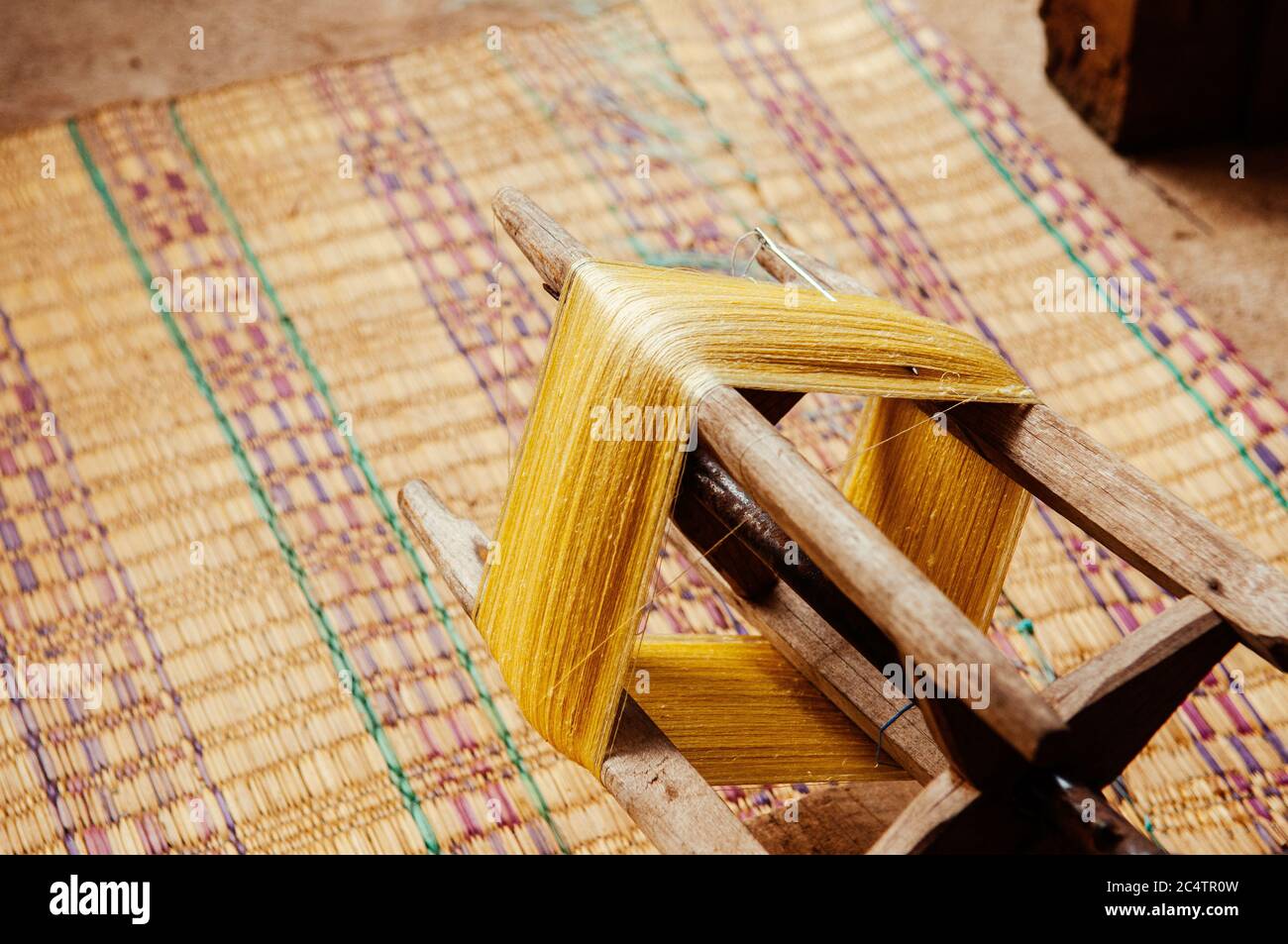 Details of natural shining yellow silk thread traditional sericulture of Thai silk making in Countryside Stock Photohttps://www.alamy.com/image-license-details/?v=1https://www.alamy.com/details-of-natural-shining-yellow-silk-thread-traditional-sericulture-of-thai-silk-making-in-countryside-image364421257.html
Details of natural shining yellow silk thread traditional sericulture of Thai silk making in Countryside Stock Photohttps://www.alamy.com/image-license-details/?v=1https://www.alamy.com/details-of-natural-shining-yellow-silk-thread-traditional-sericulture-of-thai-silk-making-in-countryside-image364421257.htmlRF2C4TR0W–Details of natural shining yellow silk thread traditional sericulture of Thai silk making in Countryside
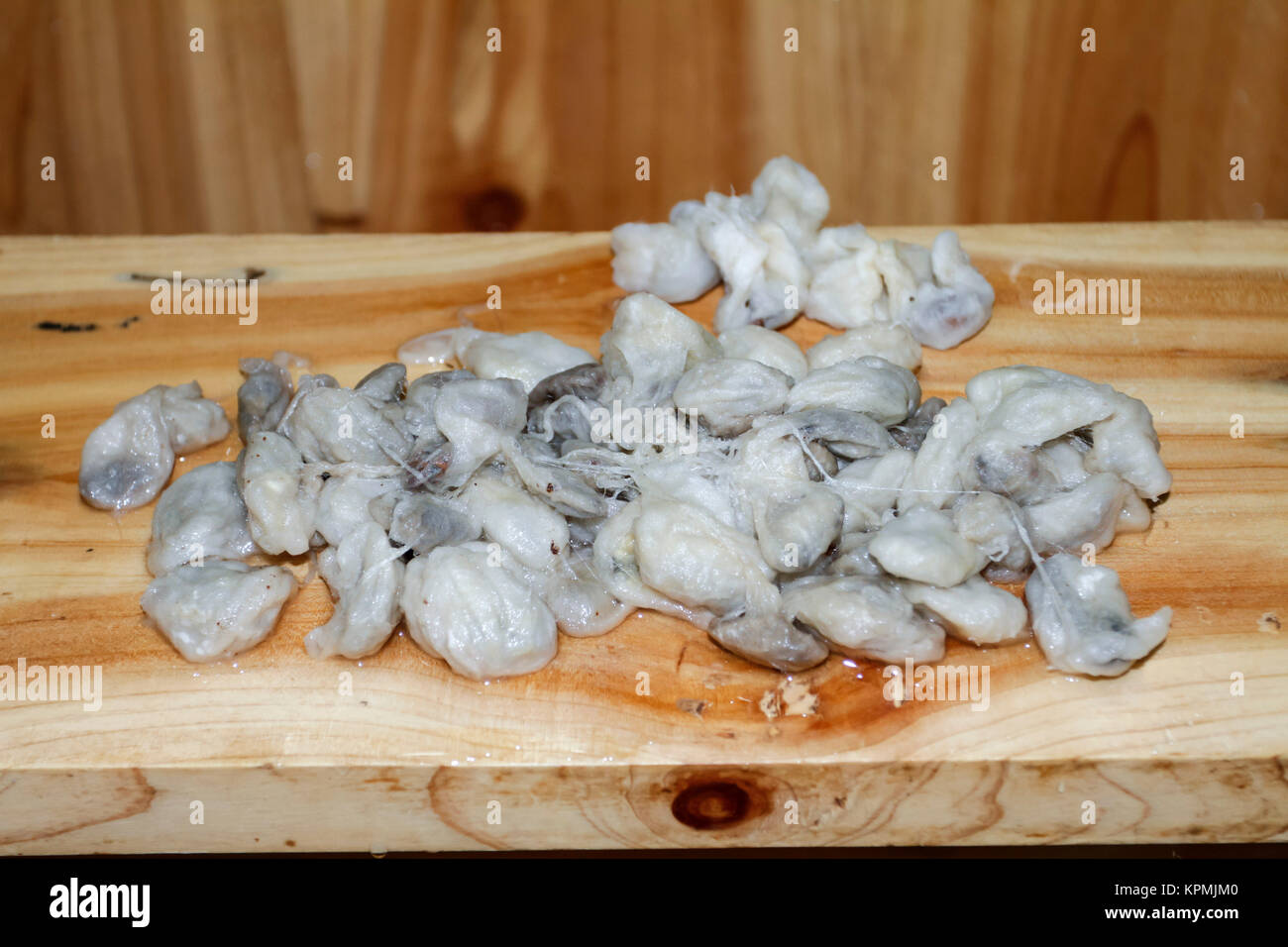 Boiled silk worm cocoon. Stock Photohttps://www.alamy.com/image-license-details/?v=1https://www.alamy.com/stock-image-boiled-silk-worm-cocoon-168869456.html
Boiled silk worm cocoon. Stock Photohttps://www.alamy.com/image-license-details/?v=1https://www.alamy.com/stock-image-boiled-silk-worm-cocoon-168869456.htmlRFKPMJM0–Boiled silk worm cocoon.
 Bursa, Turkey The Yesil Camii (the Green Mosque) dating from 1424; below, mulberry plantations intended for sericulture, Economic activity, Religion, Housing, Architecture, Agriculture, breeding, Mulberry tree, Sericulture, Islam, Mosque, Religious architecture, Asian Turkey, Bush, The green mosque, the trunks of mulberry trees lit in the foreground, Bursa, 03/06/1913 - 03/06/1913, Léon, Auguste, photographer, 1913 - Balkans - Léon Busy and Auguste Léon - (23 April - 9 June), Autochrome, photo, Glass, Autochrome, photo, Positive, Vertical, Size 9 x 12 cm Stock Photohttps://www.alamy.com/image-license-details/?v=1https://www.alamy.com/bursa-turkey-the-yesil-camii-the-green-mosque-dating-from-1424-below-mulberry-plantations-intended-for-sericulture-economic-activity-religion-housing-architecture-agriculture-breeding-mulberry-tree-sericulture-islam-mosque-religious-architecture-asian-turkey-bush-the-green-mosque-the-trunks-of-mulberry-trees-lit-in-the-foreground-bursa-03061913-03061913-lon-auguste-photographer-1913-balkans-lon-busy-and-auguste-lon-23-april-9-june-autochrome-photo-glass-autochrome-photo-positive-vertical-size-9-x-12-cm-image576135163.html
Bursa, Turkey The Yesil Camii (the Green Mosque) dating from 1424; below, mulberry plantations intended for sericulture, Economic activity, Religion, Housing, Architecture, Agriculture, breeding, Mulberry tree, Sericulture, Islam, Mosque, Religious architecture, Asian Turkey, Bush, The green mosque, the trunks of mulberry trees lit in the foreground, Bursa, 03/06/1913 - 03/06/1913, Léon, Auguste, photographer, 1913 - Balkans - Léon Busy and Auguste Léon - (23 April - 9 June), Autochrome, photo, Glass, Autochrome, photo, Positive, Vertical, Size 9 x 12 cm Stock Photohttps://www.alamy.com/image-license-details/?v=1https://www.alamy.com/bursa-turkey-the-yesil-camii-the-green-mosque-dating-from-1424-below-mulberry-plantations-intended-for-sericulture-economic-activity-religion-housing-architecture-agriculture-breeding-mulberry-tree-sericulture-islam-mosque-religious-architecture-asian-turkey-bush-the-green-mosque-the-trunks-of-mulberry-trees-lit-in-the-foreground-bursa-03061913-03061913-lon-auguste-photographer-1913-balkans-lon-busy-and-auguste-lon-23-april-9-june-autochrome-photo-glass-autochrome-photo-positive-vertical-size-9-x-12-cm-image576135163.htmlRM2TD967R–Bursa, Turkey The Yesil Camii (the Green Mosque) dating from 1424; below, mulberry plantations intended for sericulture, Economic activity, Religion, Housing, Architecture, Agriculture, breeding, Mulberry tree, Sericulture, Islam, Mosque, Religious architecture, Asian Turkey, Bush, The green mosque, the trunks of mulberry trees lit in the foreground, Bursa, 03/06/1913 - 03/06/1913, Léon, Auguste, photographer, 1913 - Balkans - Léon Busy and Auguste Léon - (23 April - 9 June), Autochrome, photo, Glass, Autochrome, photo, Positive, Vertical, Size 9 x 12 cm
 Weaving the silk (Sericulture by Liang Kai, 1200s) Stock Photohttps://www.alamy.com/image-license-details/?v=1https://www.alamy.com/stock-photo-weaving-the-silk-sericulture-by-liang-kai-1200s-135613509.html
Weaving the silk (Sericulture by Liang Kai, 1200s) Stock Photohttps://www.alamy.com/image-license-details/?v=1https://www.alamy.com/stock-photo-weaving-the-silk-sericulture-by-liang-kai-1200s-135613509.htmlRMHTHMBH–Weaving the silk (Sericulture by Liang Kai, 1200s)
 Many white silkworm cocoons, sericulture, silk farming, Dalat capital, Central Highlands, Vietnam, Asia Stock Photohttps://www.alamy.com/image-license-details/?v=1https://www.alamy.com/stock-photo-many-white-silkworm-cocoons-sericulture-silk-farming-dalat-capital-25889691.html
Many white silkworm cocoons, sericulture, silk farming, Dalat capital, Central Highlands, Vietnam, Asia Stock Photohttps://www.alamy.com/image-license-details/?v=1https://www.alamy.com/stock-photo-many-white-silkworm-cocoons-sericulture-silk-farming-dalat-capital-25889691.htmlRFBE3AFR–Many white silkworm cocoons, sericulture, silk farming, Dalat capital, Central Highlands, Vietnam, Asia
 Drawing, Sericulture, Unwinding Cocoons, ca. 1590 Stock Photohttps://www.alamy.com/image-license-details/?v=1https://www.alamy.com/drawing-sericulture-unwinding-cocoons-ca-1590-image264828102.html
Drawing, Sericulture, Unwinding Cocoons, ca. 1590 Stock Photohttps://www.alamy.com/image-license-details/?v=1https://www.alamy.com/drawing-sericulture-unwinding-cocoons-ca-1590-image264828102.htmlRMWARXXE–Drawing, Sericulture, Unwinding Cocoons, ca. 1590
 Imperial Rites of Sericulture (Scroll 4- “Offering Cocoons”) Stock Photohttps://www.alamy.com/image-license-details/?v=1https://www.alamy.com/imperial-rites-of-sericulture-scroll-4-offering-cocoons-image184830379.html
Imperial Rites of Sericulture (Scroll 4- “Offering Cocoons”) Stock Photohttps://www.alamy.com/image-license-details/?v=1https://www.alamy.com/imperial-rites-of-sericulture-scroll-4-offering-cocoons-image184830379.htmlRMMMKN0Y–Imperial Rites of Sericulture (Scroll 4- “Offering Cocoons”)
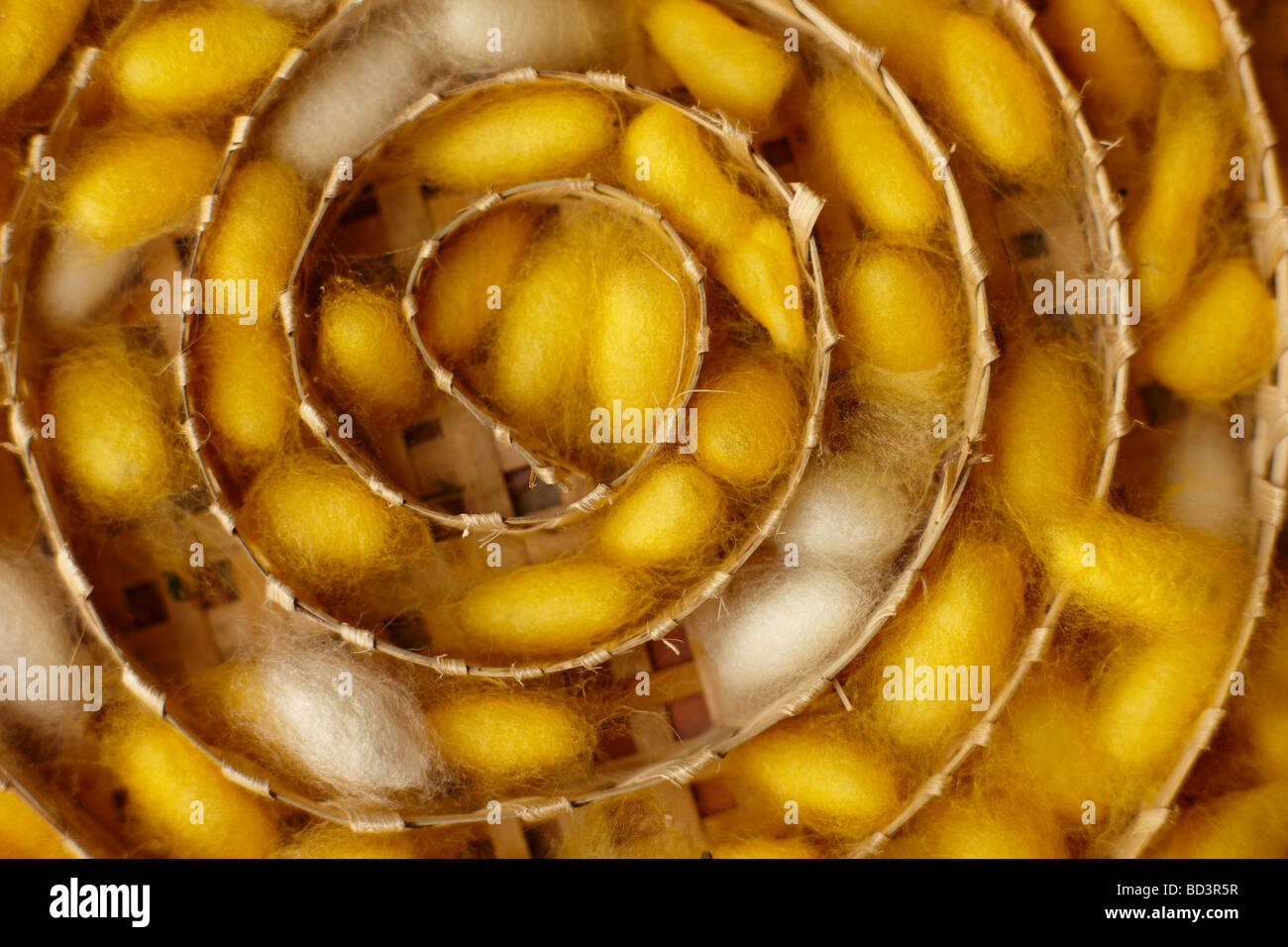 silk worm cocoons at a weaving centre in Luang Prabang, Laos Stock Photohttps://www.alamy.com/image-license-details/?v=1https://www.alamy.com/stock-photo-silk-worm-cocoons-at-a-weaving-centre-in-luang-prabang-laos-25284947.html
silk worm cocoons at a weaving centre in Luang Prabang, Laos Stock Photohttps://www.alamy.com/image-license-details/?v=1https://www.alamy.com/stock-photo-silk-worm-cocoons-at-a-weaving-centre-in-luang-prabang-laos-25284947.htmlRMBD3R5R–silk worm cocoons at a weaving centre in Luang Prabang, Laos
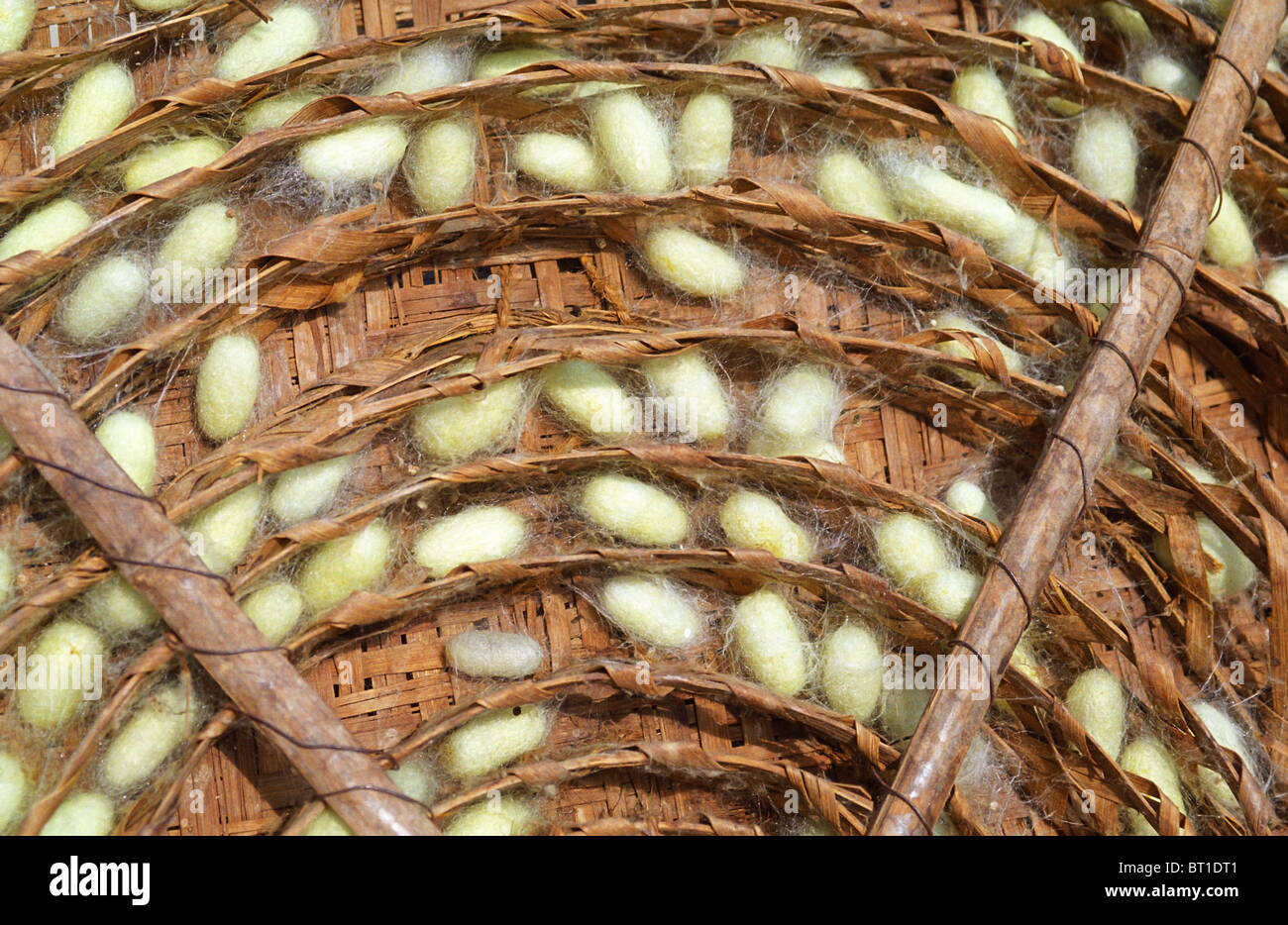 Silk worm cocoons in a small village in south India. Stock Photohttps://www.alamy.com/image-license-details/?v=1https://www.alamy.com/stock-photo-silk-worm-cocoons-in-a-small-village-in-south-india-31994929.html
Silk worm cocoons in a small village in south India. Stock Photohttps://www.alamy.com/image-license-details/?v=1https://www.alamy.com/stock-photo-silk-worm-cocoons-in-a-small-village-in-south-india-31994929.htmlRMBT1DT1–Silk worm cocoons in a small village in south India.
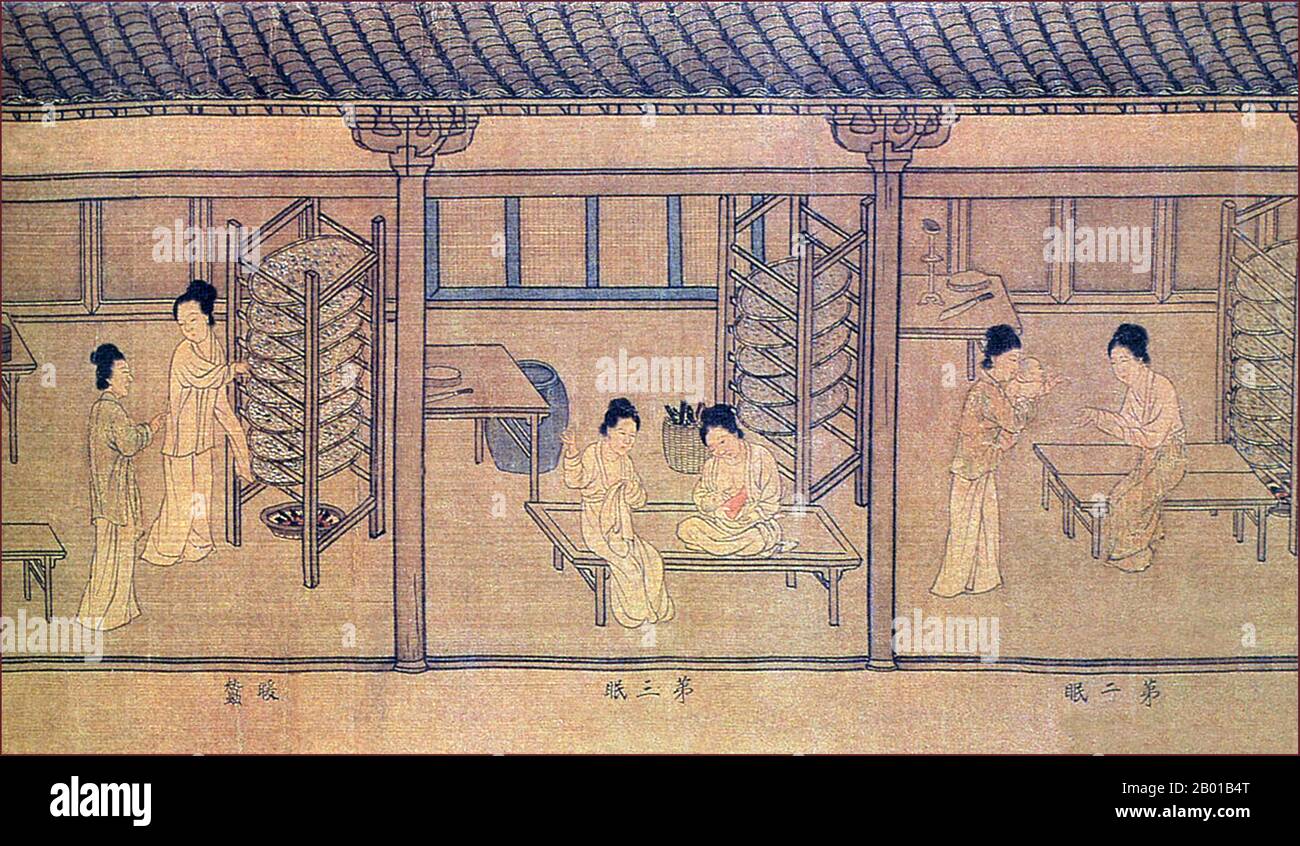 China: The Art of Making Silk (2) - Feeding and caring for silk worms while doing other chores such as sewing and playing with a baby. Detail from a Song Dynasty (960-1279) handscroll painting, 11th century. In China, silk worm farming was originally restricted to women, and many women were employed in the silk-making industry. Even though some saw this development of a luxury product as useless, silk provoked such a craze among high society that the laws were used to regulate and limit its use to the members of the imperial family. Stock Photohttps://www.alamy.com/image-license-details/?v=1https://www.alamy.com/china-the-art-of-making-silk-2-feeding-and-caring-for-silk-worms-while-doing-other-chores-such-as-sewing-and-playing-with-a-baby-detail-from-a-song-dynasty-960-1279-handscroll-painting-11th-century-in-china-silk-worm-farming-was-originally-restricted-to-women-and-many-women-were-employed-in-the-silk-making-industry-even-though-some-saw-this-development-of-a-luxury-product-as-useless-silk-provoked-such-a-craze-among-high-society-that-the-laws-were-used-to-regulate-and-limit-its-use-to-the-members-of-the-imperial-family-image344238072.html
China: The Art of Making Silk (2) - Feeding and caring for silk worms while doing other chores such as sewing and playing with a baby. Detail from a Song Dynasty (960-1279) handscroll painting, 11th century. In China, silk worm farming was originally restricted to women, and many women were employed in the silk-making industry. Even though some saw this development of a luxury product as useless, silk provoked such a craze among high society that the laws were used to regulate and limit its use to the members of the imperial family. Stock Photohttps://www.alamy.com/image-license-details/?v=1https://www.alamy.com/china-the-art-of-making-silk-2-feeding-and-caring-for-silk-worms-while-doing-other-chores-such-as-sewing-and-playing-with-a-baby-detail-from-a-song-dynasty-960-1279-handscroll-painting-11th-century-in-china-silk-worm-farming-was-originally-restricted-to-women-and-many-women-were-employed-in-the-silk-making-industry-even-though-some-saw-this-development-of-a-luxury-product-as-useless-silk-provoked-such-a-craze-among-high-society-that-the-laws-were-used-to-regulate-and-limit-its-use-to-the-members-of-the-imperial-family-image344238072.htmlRM2B01B4T–China: The Art of Making Silk (2) - Feeding and caring for silk worms while doing other chores such as sewing and playing with a baby. Detail from a Song Dynasty (960-1279) handscroll painting, 11th century. In China, silk worm farming was originally restricted to women, and many women were employed in the silk-making industry. Even though some saw this development of a luxury product as useless, silk provoked such a craze among high society that the laws were used to regulate and limit its use to the members of the imperial family.
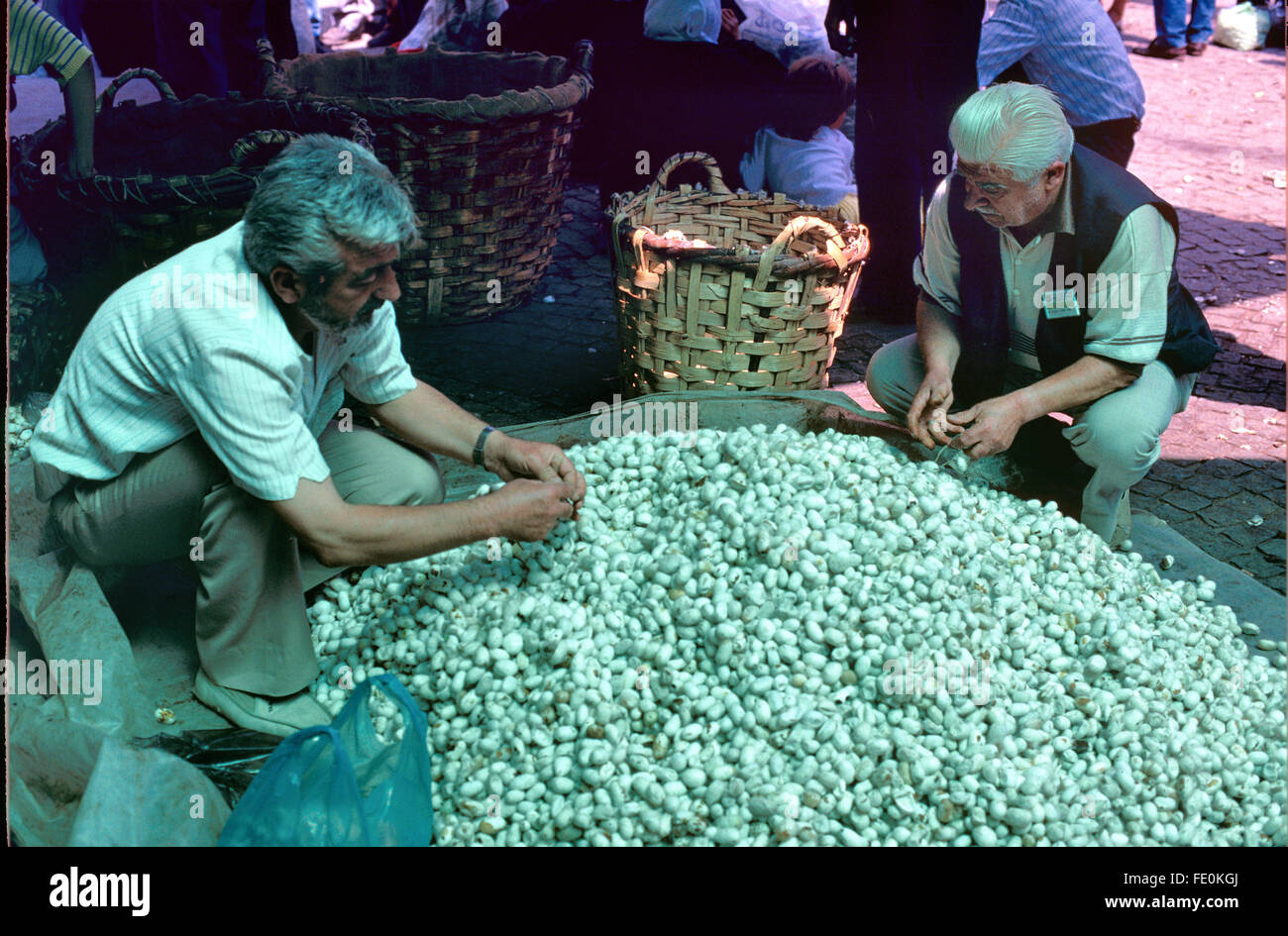 Silk Traders or Farmers Sort Silk Cocoons at the Silk Cocoon Market Held Annually in July When Silk Farmers Gather to Sell their Silk Cocoons in the Silk Bazaar, or Koza Han, Bursa, Turkey Stock Photohttps://www.alamy.com/image-license-details/?v=1https://www.alamy.com/stock-photo-silk-traders-or-farmers-sort-silk-cocoons-at-the-silk-cocoon-market-94672386.html
Silk Traders or Farmers Sort Silk Cocoons at the Silk Cocoon Market Held Annually in July When Silk Farmers Gather to Sell their Silk Cocoons in the Silk Bazaar, or Koza Han, Bursa, Turkey Stock Photohttps://www.alamy.com/image-license-details/?v=1https://www.alamy.com/stock-photo-silk-traders-or-farmers-sort-silk-cocoons-at-the-silk-cocoon-market-94672386.htmlRMFE0KGJ–Silk Traders or Farmers Sort Silk Cocoons at the Silk Cocoon Market Held Annually in July When Silk Farmers Gather to Sell their Silk Cocoons in the Silk Bazaar, or Koza Han, Bursa, Turkey
 Natural silkworms cocoons sericulture breeding Stock Photohttps://www.alamy.com/image-license-details/?v=1https://www.alamy.com/natural-silkworms-cocoons-sericulture-breeding-image327679670.html
Natural silkworms cocoons sericulture breeding Stock Photohttps://www.alamy.com/image-license-details/?v=1https://www.alamy.com/natural-silkworms-cocoons-sericulture-breeding-image327679670.htmlRF2A132NA–Natural silkworms cocoons sericulture breeding
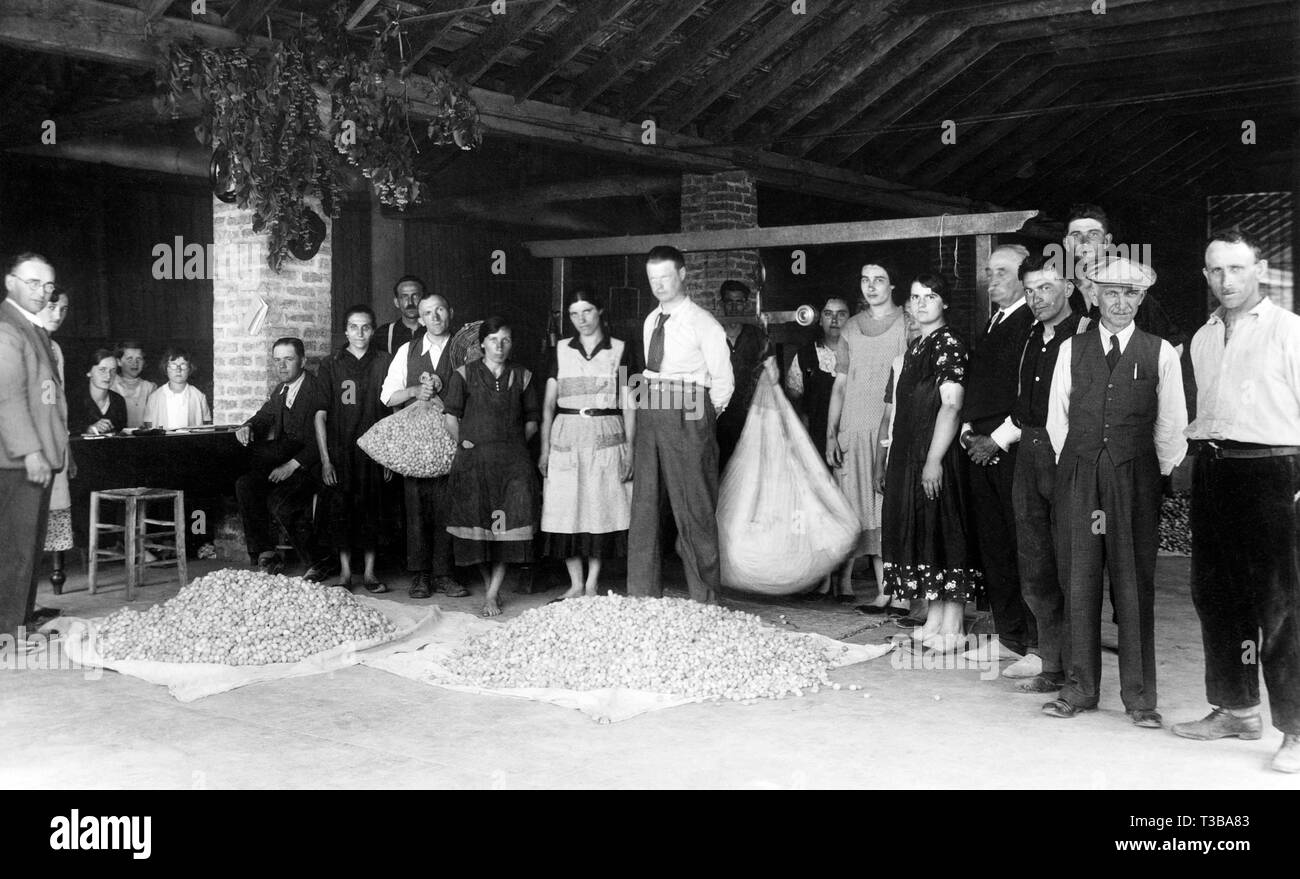 sericulture Stock Photohttps://www.alamy.com/image-license-details/?v=1https://www.alamy.com/sericulture-image243038659.html
sericulture Stock Photohttps://www.alamy.com/image-license-details/?v=1https://www.alamy.com/sericulture-image243038659.htmlRMT3BA83–sericulture
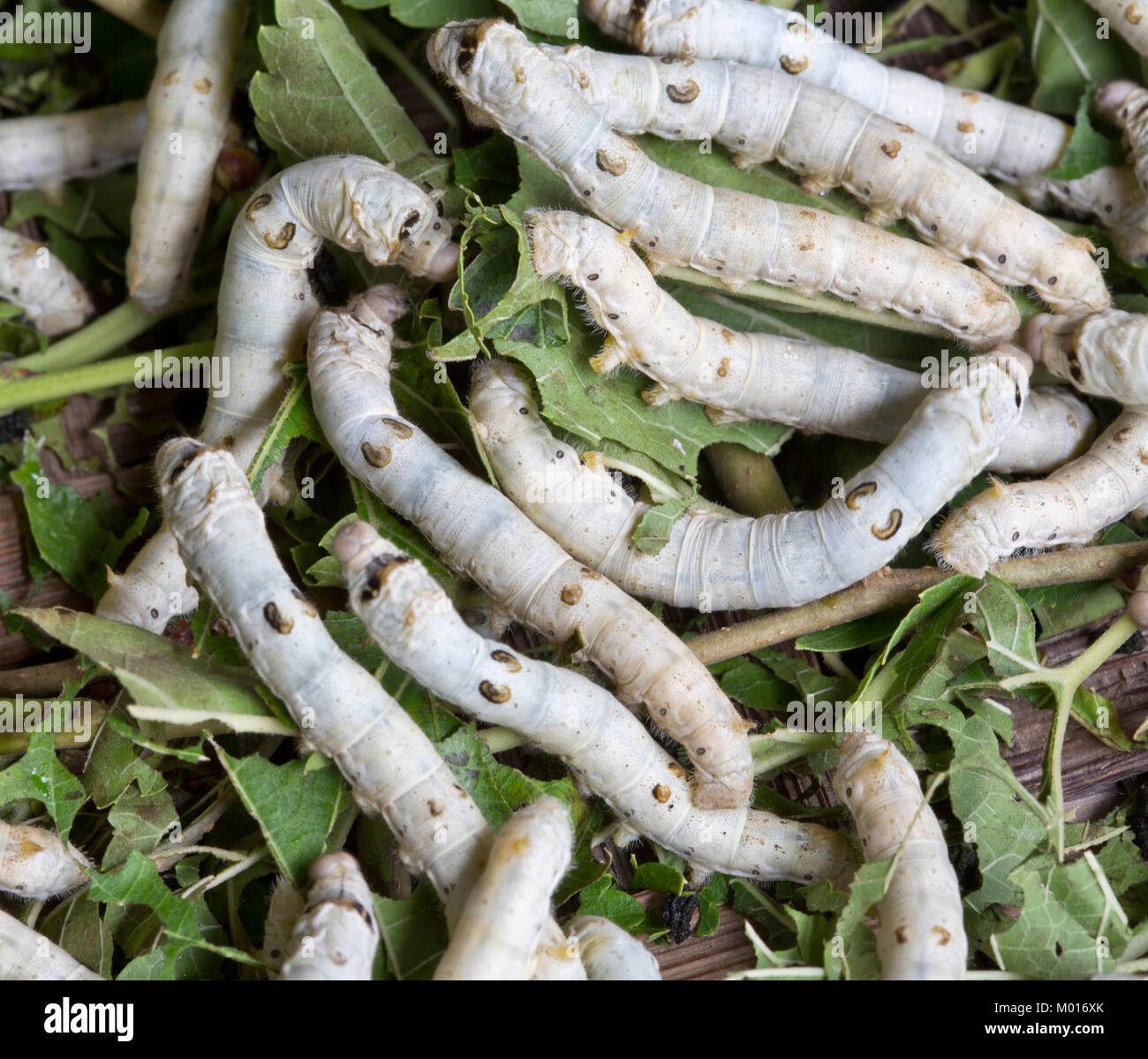 Close-up of silkworms 'Bombyx mori' feeding on White Mulberry 'Morus alba' leaves, Hoi An, Quang Nam Province. Stock Photohttps://www.alamy.com/image-license-details/?v=1https://www.alamy.com/stock-photo-close-up-of-silkworms-bombyx-mori-feeding-on-white-mulberry-morus-172131083.html
Close-up of silkworms 'Bombyx mori' feeding on White Mulberry 'Morus alba' leaves, Hoi An, Quang Nam Province. Stock Photohttps://www.alamy.com/image-license-details/?v=1https://www.alamy.com/stock-photo-close-up-of-silkworms-bombyx-mori-feeding-on-white-mulberry-morus-172131083.htmlRMM016XK–Close-up of silkworms 'Bombyx mori' feeding on White Mulberry 'Morus alba' leaves, Hoi An, Quang Nam Province.
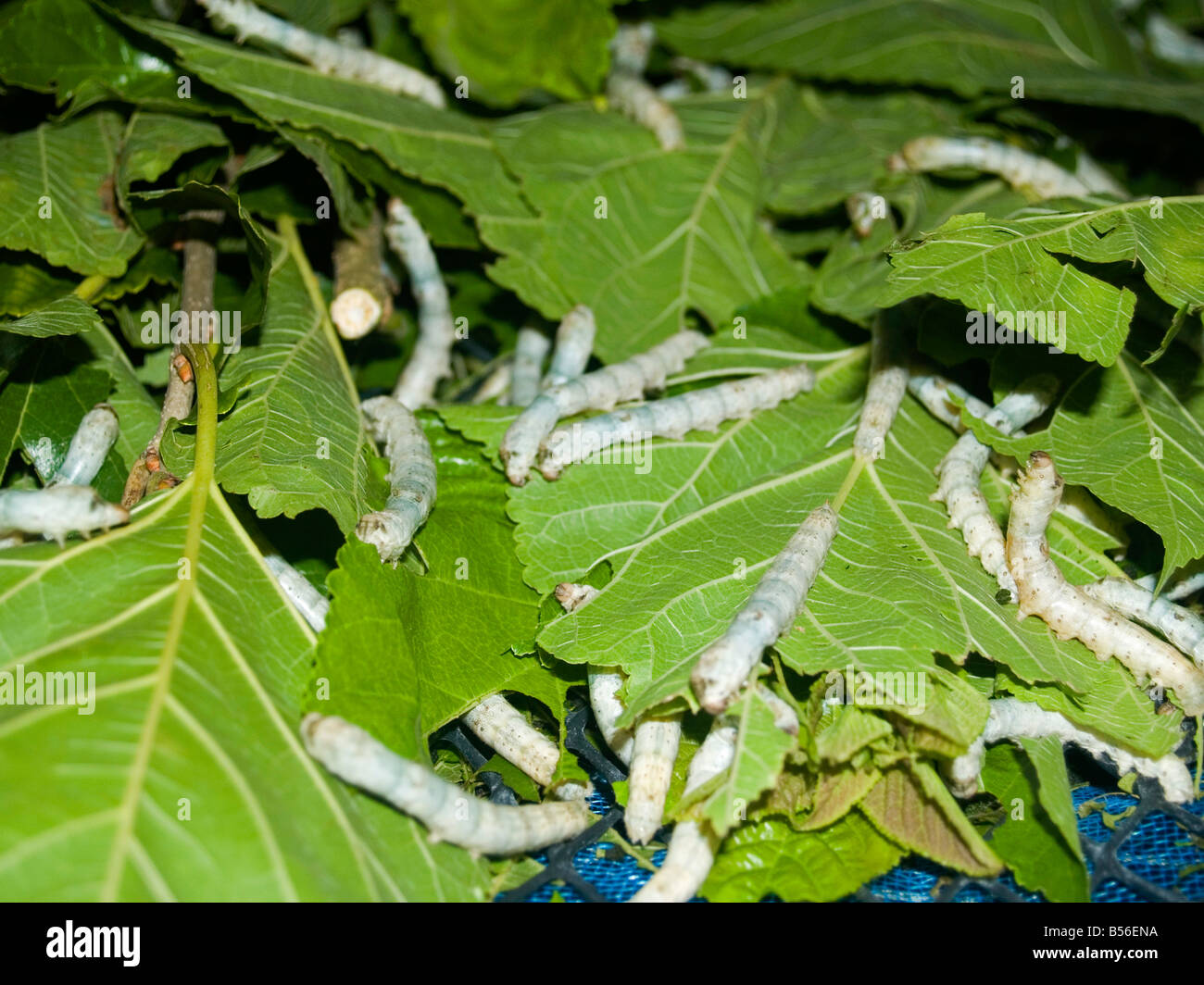 silkworms at the Queen Sirikit Sericulture Center in Surin Thailand Stock Photohttps://www.alamy.com/image-license-details/?v=1https://www.alamy.com/stock-photo-silkworms-at-the-queen-sirikit-sericulture-center-in-surin-thailand-20426934.html
silkworms at the Queen Sirikit Sericulture Center in Surin Thailand Stock Photohttps://www.alamy.com/image-license-details/?v=1https://www.alamy.com/stock-photo-silkworms-at-the-queen-sirikit-sericulture-center-in-surin-thailand-20426934.htmlRFB56ENA–silkworms at the Queen Sirikit Sericulture Center in Surin Thailand
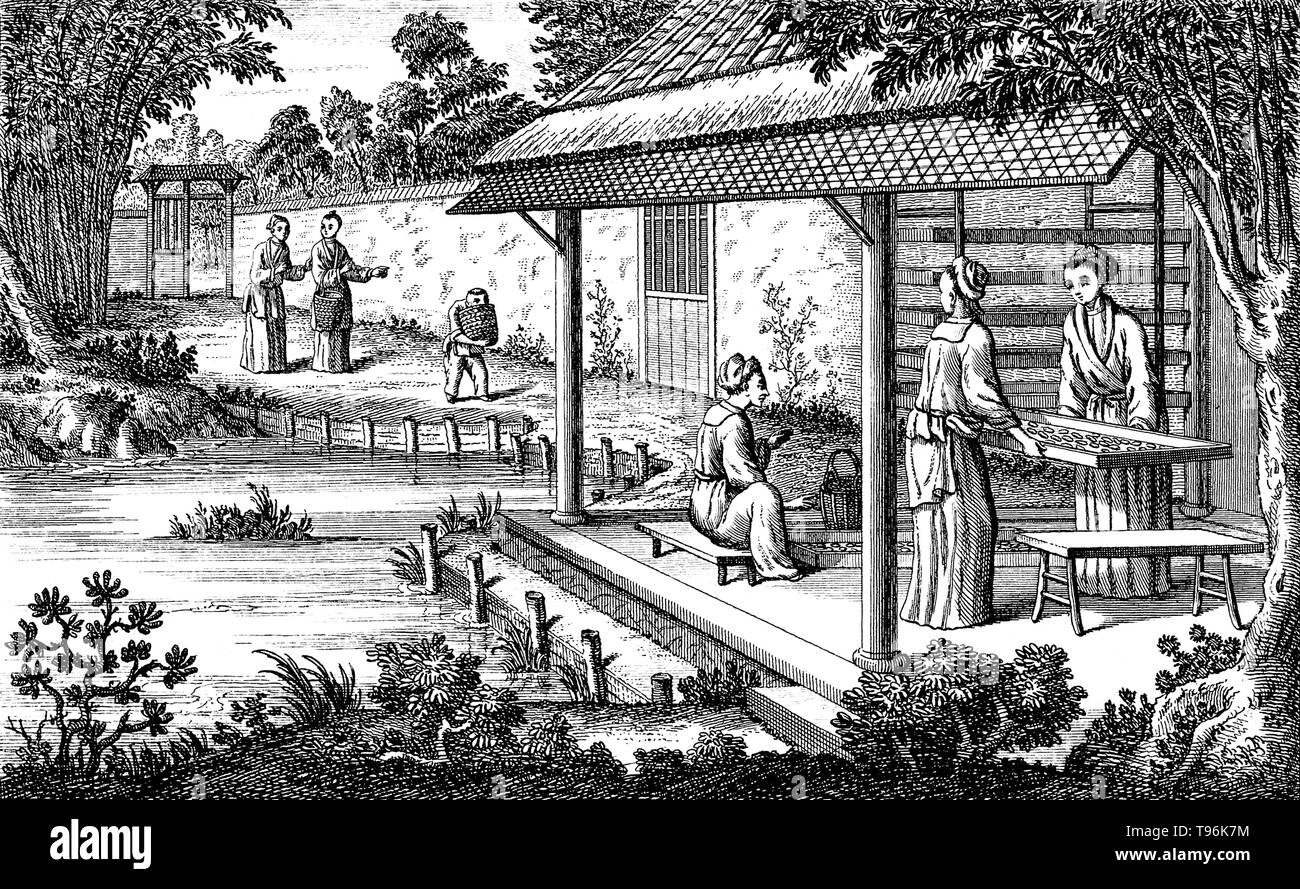 Textiles: silk manufacture in China, feeding the silkworms. The production of silk originates in China in prehistoric times. Silk remained confined to China until the Silk Road opened at some point during the later half of the first millennium BC. China maintained its virtual monopoly over silk production for another thousand years. Sericulture, or silk farming, is the cultivation of silkworms to produce silk. Stock Photohttps://www.alamy.com/image-license-details/?v=1https://www.alamy.com/textiles-silk-manufacture-in-china-feeding-the-silkworms-the-production-of-silk-originates-in-china-in-prehistoric-times-silk-remained-confined-to-china-until-the-silk-road-opened-at-some-point-during-the-later-half-of-the-first-millennium-bc-china-maintained-its-virtual-monopoly-over-silk-production-for-another-thousand-years-sericulture-or-silk-farming-is-the-cultivation-of-silkworms-to-produce-silk-image246623880.html
Textiles: silk manufacture in China, feeding the silkworms. The production of silk originates in China in prehistoric times. Silk remained confined to China until the Silk Road opened at some point during the later half of the first millennium BC. China maintained its virtual monopoly over silk production for another thousand years. Sericulture, or silk farming, is the cultivation of silkworms to produce silk. Stock Photohttps://www.alamy.com/image-license-details/?v=1https://www.alamy.com/textiles-silk-manufacture-in-china-feeding-the-silkworms-the-production-of-silk-originates-in-china-in-prehistoric-times-silk-remained-confined-to-china-until-the-silk-road-opened-at-some-point-during-the-later-half-of-the-first-millennium-bc-china-maintained-its-virtual-monopoly-over-silk-production-for-another-thousand-years-sericulture-or-silk-farming-is-the-cultivation-of-silkworms-to-produce-silk-image246623880.htmlRMT96K7M–Textiles: silk manufacture in China, feeding the silkworms. The production of silk originates in China in prehistoric times. Silk remained confined to China until the Silk Road opened at some point during the later half of the first millennium BC. China maintained its virtual monopoly over silk production for another thousand years. Sericulture, or silk farming, is the cultivation of silkworms to produce silk.
 Close-up of a chakra tray used in silkworm production. Bangalore, South India Stock Photohttps://www.alamy.com/image-license-details/?v=1https://www.alamy.com/close-up-of-a-chakra-tray-used-in-silkworm-production-bangalore-south-image4058407.html
Close-up of a chakra tray used in silkworm production. Bangalore, South India Stock Photohttps://www.alamy.com/image-license-details/?v=1https://www.alamy.com/close-up-of-a-chakra-tray-used-in-silkworm-production-bangalore-south-image4058407.htmlRMA9RW28–Close-up of a chakra tray used in silkworm production. Bangalore, South India
 mulberry tree Stock Photohttps://www.alamy.com/image-license-details/?v=1https://www.alamy.com/stock-photo-mulberry-tree-12520135.html
mulberry tree Stock Photohttps://www.alamy.com/image-license-details/?v=1https://www.alamy.com/stock-photo-mulberry-tree-12520135.htmlRFAA5CYM–mulberry tree
![[ 1910s Japan - Japanese Silk Farming ] — Two women work with silkworms during their second sleep. This postcard is from a series about sericulture, showing the steps involved in making silk. This is card 6. 20th century vintage postcard. Stock Photo [ 1910s Japan - Japanese Silk Farming ] — Two women work with silkworms during their second sleep. This postcard is from a series about sericulture, showing the steps involved in making silk. This is card 6. 20th century vintage postcard. Stock Photo](https://c8.alamy.com/comp/2BKNA6C/1910s-japan-japanese-silk-farming-two-women-work-with-silkworms-during-their-second-sleep-this-postcard-is-from-a-series-about-sericulture-showing-the-steps-involved-in-making-silk-this-is-card-6-20th-century-vintage-postcard-2BKNA6C.jpg) [ 1910s Japan - Japanese Silk Farming ] — Two women work with silkworms during their second sleep. This postcard is from a series about sericulture, showing the steps involved in making silk. This is card 6. 20th century vintage postcard. Stock Photohttps://www.alamy.com/image-license-details/?v=1https://www.alamy.com/1910s-japan-japanese-silk-farming-two-women-work-with-silkworms-during-their-second-sleep-this-postcard-is-from-a-series-about-sericulture-showing-the-steps-involved-in-making-silk-this-is-card-6-20th-century-vintage-postcard-image356354836.html
[ 1910s Japan - Japanese Silk Farming ] — Two women work with silkworms during their second sleep. This postcard is from a series about sericulture, showing the steps involved in making silk. This is card 6. 20th century vintage postcard. Stock Photohttps://www.alamy.com/image-license-details/?v=1https://www.alamy.com/1910s-japan-japanese-silk-farming-two-women-work-with-silkworms-during-their-second-sleep-this-postcard-is-from-a-series-about-sericulture-showing-the-steps-involved-in-making-silk-this-is-card-6-20th-century-vintage-postcard-image356354836.htmlRM2BKNA6C–[ 1910s Japan - Japanese Silk Farming ] — Two women work with silkworms during their second sleep. This postcard is from a series about sericulture, showing the steps involved in making silk. This is card 6. 20th century vintage postcard.
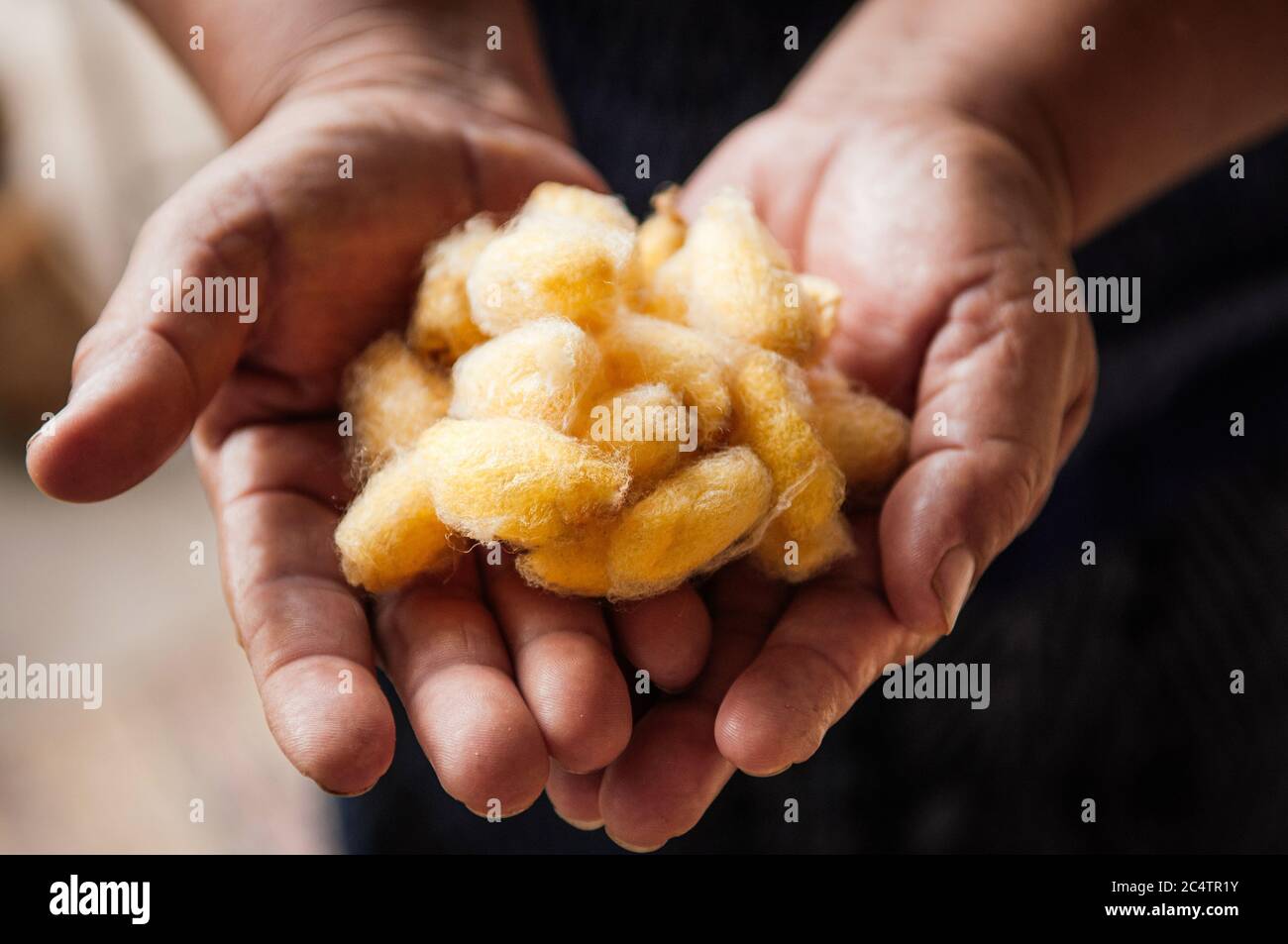 Details of natural shining yellow silk cocoons traditional sericulture of Thai silk making in Countryside Stock Photohttps://www.alamy.com/image-license-details/?v=1https://www.alamy.com/details-of-natural-shining-yellow-silk-cocoons-traditional-sericulture-of-thai-silk-making-in-countryside-image364421287.html
Details of natural shining yellow silk cocoons traditional sericulture of Thai silk making in Countryside Stock Photohttps://www.alamy.com/image-license-details/?v=1https://www.alamy.com/details-of-natural-shining-yellow-silk-cocoons-traditional-sericulture-of-thai-silk-making-in-countryside-image364421287.htmlRF2C4TR1Y–Details of natural shining yellow silk cocoons traditional sericulture of Thai silk making in Countryside
 Silkworm (Bombyx mori) with Cocoon Stock Photohttps://www.alamy.com/image-license-details/?v=1https://www.alamy.com/silkworm-bombyx-mori-with-cocoon-image260898141.html
Silkworm (Bombyx mori) with Cocoon Stock Photohttps://www.alamy.com/image-license-details/?v=1https://www.alamy.com/silkworm-bombyx-mori-with-cocoon-image260898141.htmlRFW4CX6N–Silkworm (Bombyx mori) with Cocoon
 chrysanthemum Stock Photohttps://www.alamy.com/image-license-details/?v=1https://www.alamy.com/chrysanthemum-image567480391.html
chrysanthemum Stock Photohttps://www.alamy.com/image-license-details/?v=1https://www.alamy.com/chrysanthemum-image567480391.htmlRF2RY6Y0R–chrysanthemum
 Spooling the silk (Sericulture by Liang Kai, 1200s) Stock Photohttps://www.alamy.com/image-license-details/?v=1https://www.alamy.com/stock-photo-spooling-the-silk-sericulture-by-liang-kai-1200s-135613508.html
Spooling the silk (Sericulture by Liang Kai, 1200s) Stock Photohttps://www.alamy.com/image-license-details/?v=1https://www.alamy.com/stock-photo-spooling-the-silk-sericulture-by-liang-kai-1200s-135613508.htmlRMHTHMBG–Spooling the silk (Sericulture by Liang Kai, 1200s)
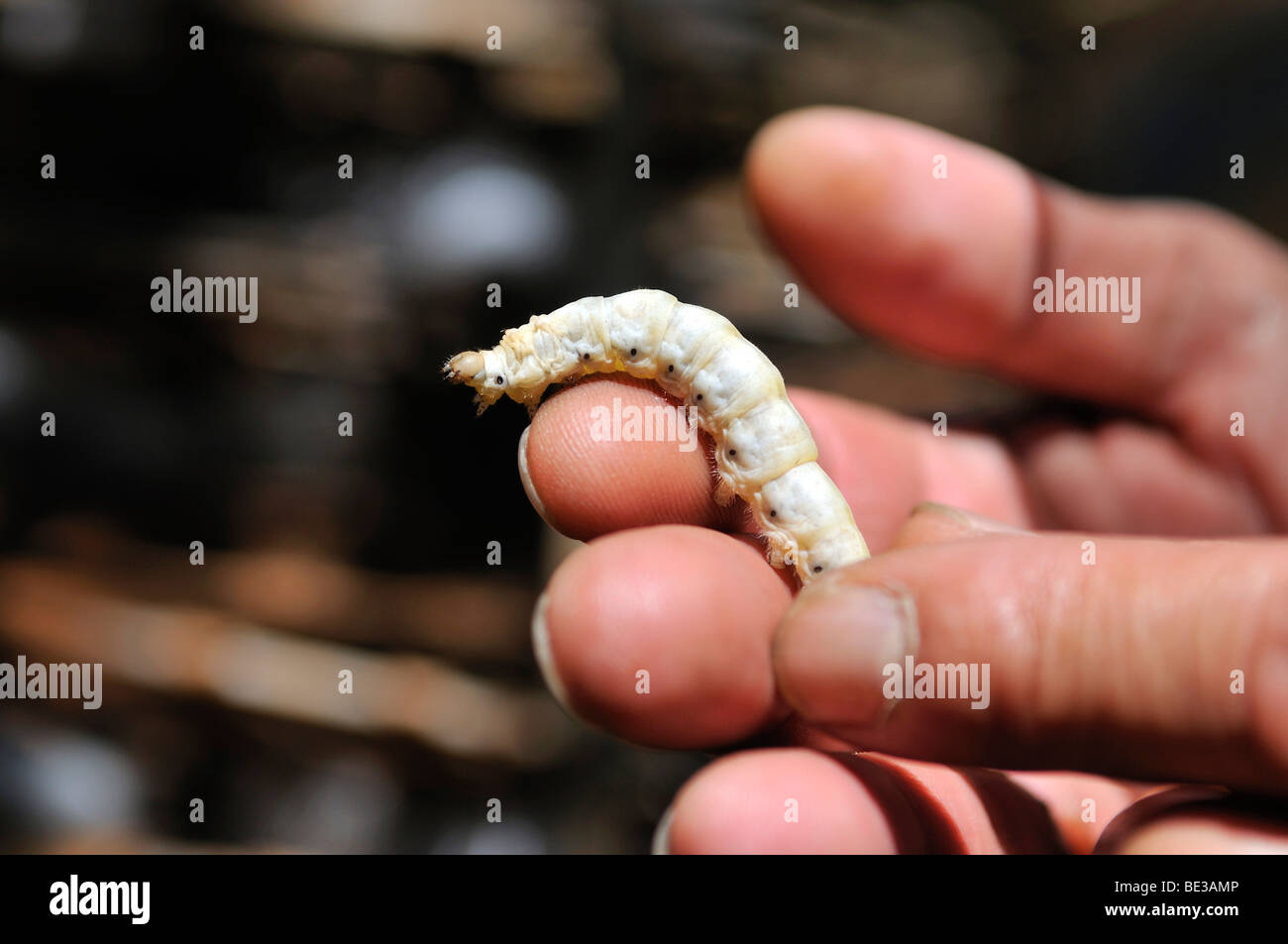 Silkworm (Bombyx mori) in the hand of the breeder, sericulture, silk farming, Dalat capital, Central Highlands, Vietnam, Asia Stock Photohttps://www.alamy.com/image-license-details/?v=1https://www.alamy.com/stock-photo-silkworm-bombyx-mori-in-the-hand-of-the-breeder-sericulture-silk-farming-25889830.html
Silkworm (Bombyx mori) in the hand of the breeder, sericulture, silk farming, Dalat capital, Central Highlands, Vietnam, Asia Stock Photohttps://www.alamy.com/image-license-details/?v=1https://www.alamy.com/stock-photo-silkworm-bombyx-mori-in-the-hand-of-the-breeder-sericulture-silk-farming-25889830.htmlRFBE3AMP–Silkworm (Bombyx mori) in the hand of the breeder, sericulture, silk farming, Dalat capital, Central Highlands, Vietnam, Asia
 Drawing, Sericulture, Unwinding Cocoons, ca. 1590 Stock Photohttps://www.alamy.com/image-license-details/?v=1https://www.alamy.com/drawing-sericulture-unwinding-cocoons-ca-1590-image264828144.html
Drawing, Sericulture, Unwinding Cocoons, ca. 1590 Stock Photohttps://www.alamy.com/image-license-details/?v=1https://www.alamy.com/drawing-sericulture-unwinding-cocoons-ca-1590-image264828144.htmlRMWARY00–Drawing, Sericulture, Unwinding Cocoons, ca. 1590
 1838 Weaving the silk (Sericulture by Liang Kai, 1200s) Stock Photohttps://www.alamy.com/image-license-details/?v=1https://www.alamy.com/1838-weaving-the-silk-sericulture-by-liang-kai-1200s-image213695708.html
1838 Weaving the silk (Sericulture by Liang Kai, 1200s) Stock Photohttps://www.alamy.com/image-license-details/?v=1https://www.alamy.com/1838-weaving-the-silk-sericulture-by-liang-kai-1200s-image213695708.htmlRMPBJK1G–1838 Weaving the silk (Sericulture by Liang Kai, 1200s)
 Woman working on a machine in a silk factory in Da Lat, Vietnam Stock Photohttps://www.alamy.com/image-license-details/?v=1https://www.alamy.com/woman-working-on-a-machine-in-a-silk-factory-in-da-lat-vietnam-image351681997.html
Woman working on a machine in a silk factory in Da Lat, Vietnam Stock Photohttps://www.alamy.com/image-license-details/?v=1https://www.alamy.com/woman-working-on-a-machine-in-a-silk-factory-in-da-lat-vietnam-image351681997.htmlRF2BC4DY9–Woman working on a machine in a silk factory in Da Lat, Vietnam
 Small silk factory around Da Lat in Vietnam Stock Photohttps://www.alamy.com/image-license-details/?v=1https://www.alamy.com/small-silk-factory-around-da-lat-in-vietnam-image458698290.html
Small silk factory around Da Lat in Vietnam Stock Photohttps://www.alamy.com/image-license-details/?v=1https://www.alamy.com/small-silk-factory-around-da-lat-in-vietnam-image458698290.htmlRF2HJ7E9P–Small silk factory around Da Lat in Vietnam
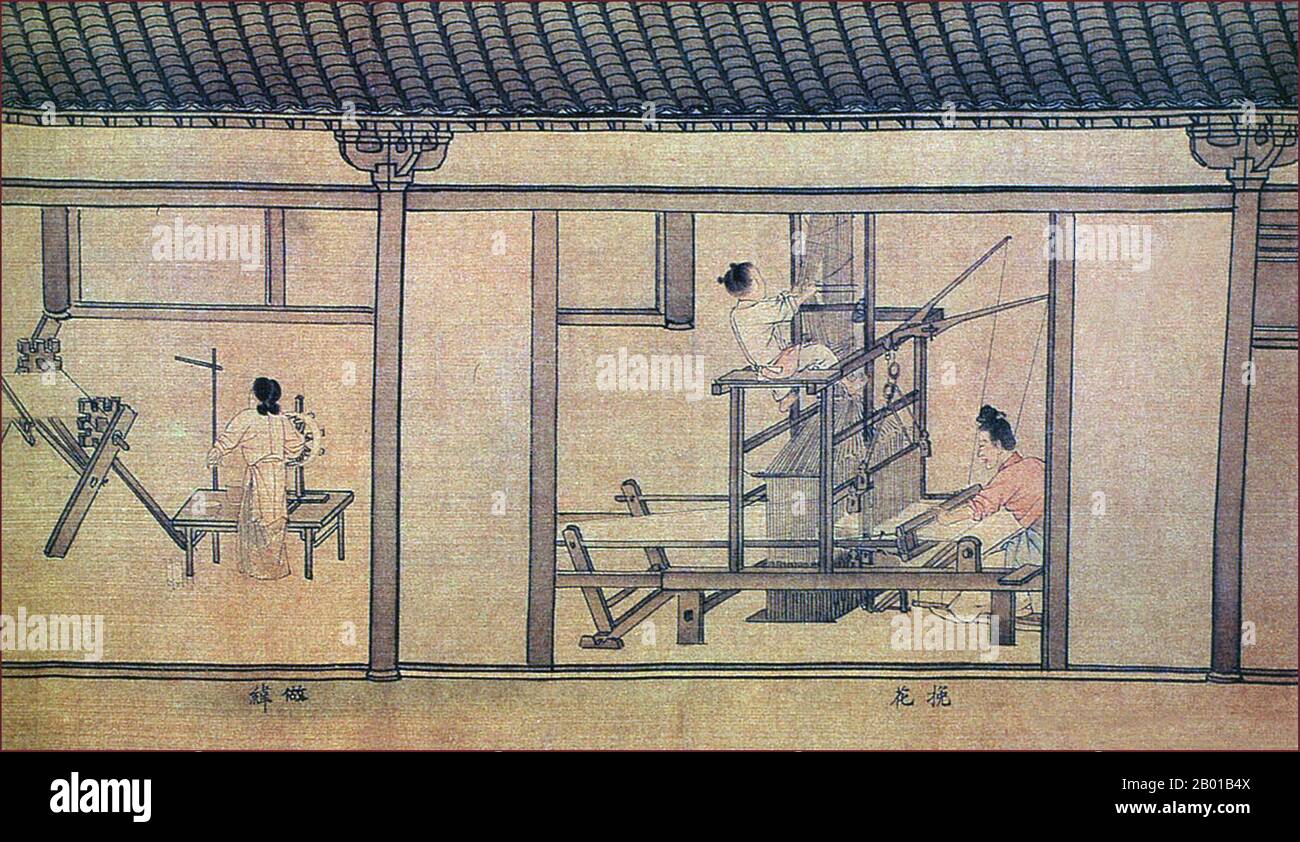 China: The Art of Making Silk (2) - Spinning and weaving silk. Detail from a Song Dynasty (960-1279) handscroll painting, 11th century. In China, silk worm farming was originally restricted to women, and many women were employed in the silk-making industry. Even though some saw this development of a luxury product as useless, silk provoked such a craze among high society that the laws were used to regulate and limit its use to the members of the imperial family. For approximately a millennium, the right to wear silk was reserved for the emperor and the highest dignitaries. Stock Photohttps://www.alamy.com/image-license-details/?v=1https://www.alamy.com/china-the-art-of-making-silk-2-spinning-and-weaving-silk-detail-from-a-song-dynasty-960-1279-handscroll-painting-11th-century-in-china-silk-worm-farming-was-originally-restricted-to-women-and-many-women-were-employed-in-the-silk-making-industry-even-though-some-saw-this-development-of-a-luxury-product-as-useless-silk-provoked-such-a-craze-among-high-society-that-the-laws-were-used-to-regulate-and-limit-its-use-to-the-members-of-the-imperial-family-for-approximately-a-millennium-the-right-to-wear-silk-was-reserved-for-the-emperor-and-the-highest-dignitaries-image344238074.html
China: The Art of Making Silk (2) - Spinning and weaving silk. Detail from a Song Dynasty (960-1279) handscroll painting, 11th century. In China, silk worm farming was originally restricted to women, and many women were employed in the silk-making industry. Even though some saw this development of a luxury product as useless, silk provoked such a craze among high society that the laws were used to regulate and limit its use to the members of the imperial family. For approximately a millennium, the right to wear silk was reserved for the emperor and the highest dignitaries. Stock Photohttps://www.alamy.com/image-license-details/?v=1https://www.alamy.com/china-the-art-of-making-silk-2-spinning-and-weaving-silk-detail-from-a-song-dynasty-960-1279-handscroll-painting-11th-century-in-china-silk-worm-farming-was-originally-restricted-to-women-and-many-women-were-employed-in-the-silk-making-industry-even-though-some-saw-this-development-of-a-luxury-product-as-useless-silk-provoked-such-a-craze-among-high-society-that-the-laws-were-used-to-regulate-and-limit-its-use-to-the-members-of-the-imperial-family-for-approximately-a-millennium-the-right-to-wear-silk-was-reserved-for-the-emperor-and-the-highest-dignitaries-image344238074.htmlRM2B01B4X–China: The Art of Making Silk (2) - Spinning and weaving silk. Detail from a Song Dynasty (960-1279) handscroll painting, 11th century. In China, silk worm farming was originally restricted to women, and many women were employed in the silk-making industry. Even though some saw this development of a luxury product as useless, silk provoked such a craze among high society that the laws were used to regulate and limit its use to the members of the imperial family. For approximately a millennium, the right to wear silk was reserved for the emperor and the highest dignitaries.
 Silk Farmers Weigh Bags of Silk Cocoons at the Silk Cocoon Market Held Annually in July When Silk Farmers Gather to Sell their Silk Cocoons in the Silk Bazaar, or Koza Han, Bursa, Turkey Stock Photohttps://www.alamy.com/image-license-details/?v=1https://www.alamy.com/stock-photo-silk-farmers-weigh-bags-of-silk-cocoons-at-the-silk-cocoon-market-94672159.html
Silk Farmers Weigh Bags of Silk Cocoons at the Silk Cocoon Market Held Annually in July When Silk Farmers Gather to Sell their Silk Cocoons in the Silk Bazaar, or Koza Han, Bursa, Turkey Stock Photohttps://www.alamy.com/image-license-details/?v=1https://www.alamy.com/stock-photo-silk-farmers-weigh-bags-of-silk-cocoons-at-the-silk-cocoon-market-94672159.htmlRMFE0K8F–Silk Farmers Weigh Bags of Silk Cocoons at the Silk Cocoon Market Held Annually in July When Silk Farmers Gather to Sell their Silk Cocoons in the Silk Bazaar, or Koza Han, Bursa, Turkey
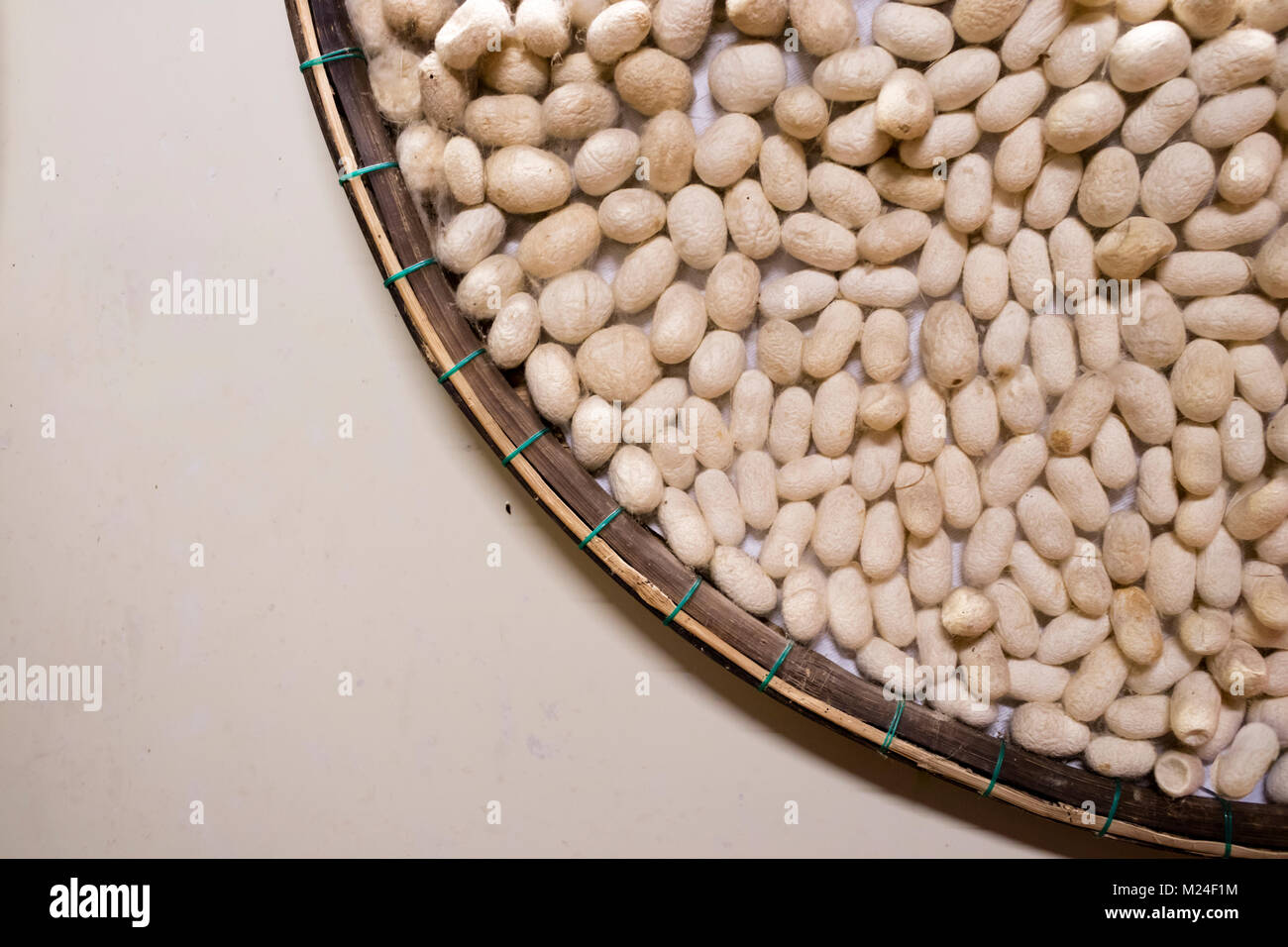 White cocoons silkworm with copyspace Stock Photohttps://www.alamy.com/image-license-details/?v=1https://www.alamy.com/stock-photo-white-cocoons-silkworm-with-copyspace-173432608.html
White cocoons silkworm with copyspace Stock Photohttps://www.alamy.com/image-license-details/?v=1https://www.alamy.com/stock-photo-white-cocoons-silkworm-with-copyspace-173432608.htmlRFM24F1M–White cocoons silkworm with copyspace
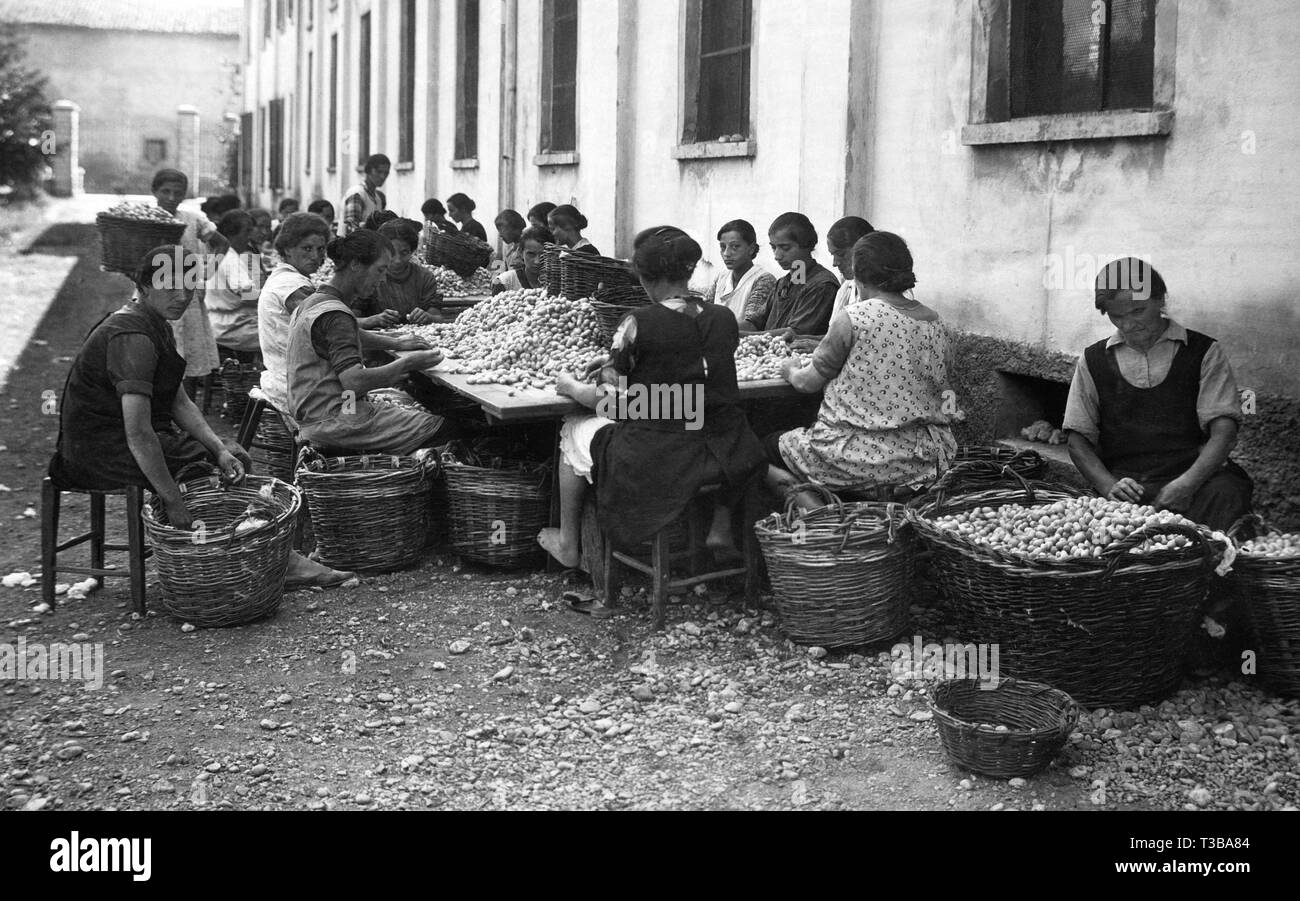 sericulture, 1939 Stock Photohttps://www.alamy.com/image-license-details/?v=1https://www.alamy.com/sericulture-1939-image243038660.html
sericulture, 1939 Stock Photohttps://www.alamy.com/image-license-details/?v=1https://www.alamy.com/sericulture-1939-image243038660.htmlRMT3BA84–sericulture, 1939
 Silkworm breeding in a silk factory. Rajshahi, Bangladesh Stock Photohttps://www.alamy.com/image-license-details/?v=1https://www.alamy.com/stock-photo-silkworm-breeding-in-a-silk-factory-rajshahi-bangladesh-141675031.html
Silkworm breeding in a silk factory. Rajshahi, Bangladesh Stock Photohttps://www.alamy.com/image-license-details/?v=1https://www.alamy.com/stock-photo-silkworm-breeding-in-a-silk-factory-rajshahi-bangladesh-141675031.htmlRMJ6DRXF–Silkworm breeding in a silk factory. Rajshahi, Bangladesh
 spinning silk thread at the Queen Sirikit Sericulture Center in Surin Thailand Stock Photohttps://www.alamy.com/image-license-details/?v=1https://www.alamy.com/stock-photo-spinning-silk-thread-at-the-queen-sirikit-sericulture-center-in-surin-20483369.html
spinning silk thread at the Queen Sirikit Sericulture Center in Surin Thailand Stock Photohttps://www.alamy.com/image-license-details/?v=1https://www.alamy.com/stock-photo-spinning-silk-thread-at-the-queen-sirikit-sericulture-center-in-surin-20483369.htmlRMB592MW–spinning silk thread at the Queen Sirikit Sericulture Center in Surin Thailand
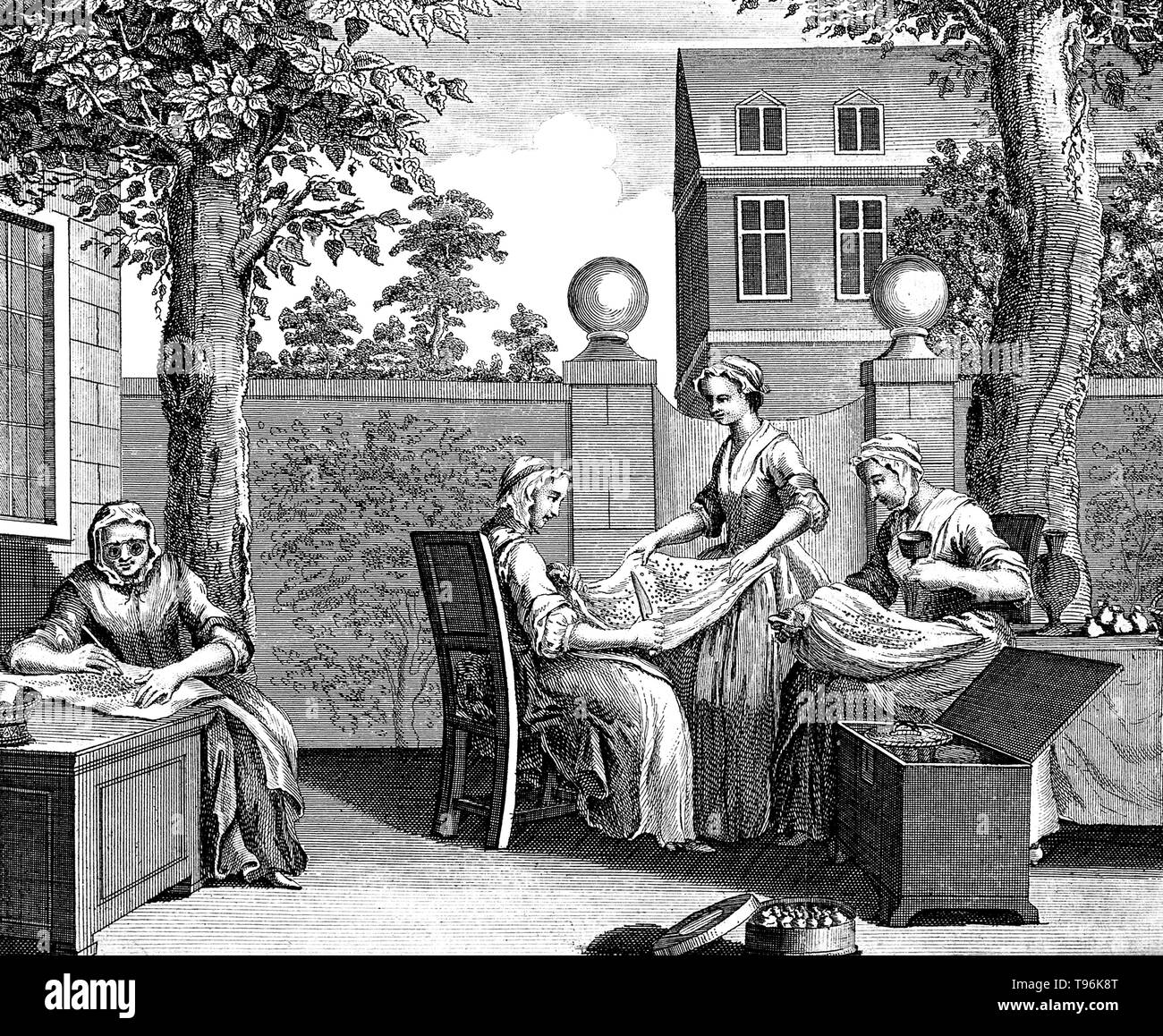 Textiles: women in a garden sorting silkworm eggs for incubation. The production of silk originates in China in prehistoric times. Silk remained confined to China until the Silk Road opened at some point during the later half of the first millennium BC. China maintained its virtual monopoly over silk production for another thousand years. Sericulture, or silk farming, is the cultivation of silkworms to produce silk. Stock Photohttps://www.alamy.com/image-license-details/?v=1https://www.alamy.com/textiles-women-in-a-garden-sorting-silkworm-eggs-for-incubation-the-production-of-silk-originates-in-china-in-prehistoric-times-silk-remained-confined-to-china-until-the-silk-road-opened-at-some-point-during-the-later-half-of-the-first-millennium-bc-china-maintained-its-virtual-monopoly-over-silk-production-for-another-thousand-years-sericulture-or-silk-farming-is-the-cultivation-of-silkworms-to-produce-silk-image246623912.html
Textiles: women in a garden sorting silkworm eggs for incubation. The production of silk originates in China in prehistoric times. Silk remained confined to China until the Silk Road opened at some point during the later half of the first millennium BC. China maintained its virtual monopoly over silk production for another thousand years. Sericulture, or silk farming, is the cultivation of silkworms to produce silk. Stock Photohttps://www.alamy.com/image-license-details/?v=1https://www.alamy.com/textiles-women-in-a-garden-sorting-silkworm-eggs-for-incubation-the-production-of-silk-originates-in-china-in-prehistoric-times-silk-remained-confined-to-china-until-the-silk-road-opened-at-some-point-during-the-later-half-of-the-first-millennium-bc-china-maintained-its-virtual-monopoly-over-silk-production-for-another-thousand-years-sericulture-or-silk-farming-is-the-cultivation-of-silkworms-to-produce-silk-image246623912.htmlRMT96K8T–Textiles: women in a garden sorting silkworm eggs for incubation. The production of silk originates in China in prehistoric times. Silk remained confined to China until the Silk Road opened at some point during the later half of the first millennium BC. China maintained its virtual monopoly over silk production for another thousand years. Sericulture, or silk farming, is the cultivation of silkworms to produce silk.
 Close-up of the hands of a female factory worker unwinding silk threads from cocoons, Bangalore, India Stock Photohttps://www.alamy.com/image-license-details/?v=1https://www.alamy.com/close-up-of-the-hands-of-a-female-factory-worker-unwinding-silk-threads-image4058472.html
Close-up of the hands of a female factory worker unwinding silk threads from cocoons, Bangalore, India Stock Photohttps://www.alamy.com/image-license-details/?v=1https://www.alamy.com/close-up-of-the-hands-of-a-female-factory-worker-unwinding-silk-threads-image4058472.htmlRMA9RW69–Close-up of the hands of a female factory worker unwinding silk threads from cocoons, Bangalore, India
 mulberry tree Stock Photohttps://www.alamy.com/image-license-details/?v=1https://www.alamy.com/stock-photo-mulberry-tree-12520140.html
mulberry tree Stock Photohttps://www.alamy.com/image-license-details/?v=1https://www.alamy.com/stock-photo-mulberry-tree-12520140.htmlRFAA5CYW–mulberry tree
![[ 1910s Japan - Japanese Silk Farming ] — Two women work with silkworms which have awoken from their last sleep. This postcard is from a series about sericulture, showing the steps involved in making silk. This is card 5. 20th century vintage postcard. Stock Photo [ 1910s Japan - Japanese Silk Farming ] — Two women work with silkworms which have awoken from their last sleep. This postcard is from a series about sericulture, showing the steps involved in making silk. This is card 5. 20th century vintage postcard. Stock Photo](https://c8.alamy.com/comp/2BKNA3T/1910s-japan-japanese-silk-farming-two-women-work-with-silkworms-which-have-awoken-from-their-last-sleep-this-postcard-is-from-a-series-about-sericulture-showing-the-steps-involved-in-making-silk-this-is-card-5-20th-century-vintage-postcard-2BKNA3T.jpg) [ 1910s Japan - Japanese Silk Farming ] — Two women work with silkworms which have awoken from their last sleep. This postcard is from a series about sericulture, showing the steps involved in making silk. This is card 5. 20th century vintage postcard. Stock Photohttps://www.alamy.com/image-license-details/?v=1https://www.alamy.com/1910s-japan-japanese-silk-farming-two-women-work-with-silkworms-which-have-awoken-from-their-last-sleep-this-postcard-is-from-a-series-about-sericulture-showing-the-steps-involved-in-making-silk-this-is-card-5-20th-century-vintage-postcard-image356354764.html
[ 1910s Japan - Japanese Silk Farming ] — Two women work with silkworms which have awoken from their last sleep. This postcard is from a series about sericulture, showing the steps involved in making silk. This is card 5. 20th century vintage postcard. Stock Photohttps://www.alamy.com/image-license-details/?v=1https://www.alamy.com/1910s-japan-japanese-silk-farming-two-women-work-with-silkworms-which-have-awoken-from-their-last-sleep-this-postcard-is-from-a-series-about-sericulture-showing-the-steps-involved-in-making-silk-this-is-card-5-20th-century-vintage-postcard-image356354764.htmlRM2BKNA3T–[ 1910s Japan - Japanese Silk Farming ] — Two women work with silkworms which have awoken from their last sleep. This postcard is from a series about sericulture, showing the steps involved in making silk. This is card 5. 20th century vintage postcard.
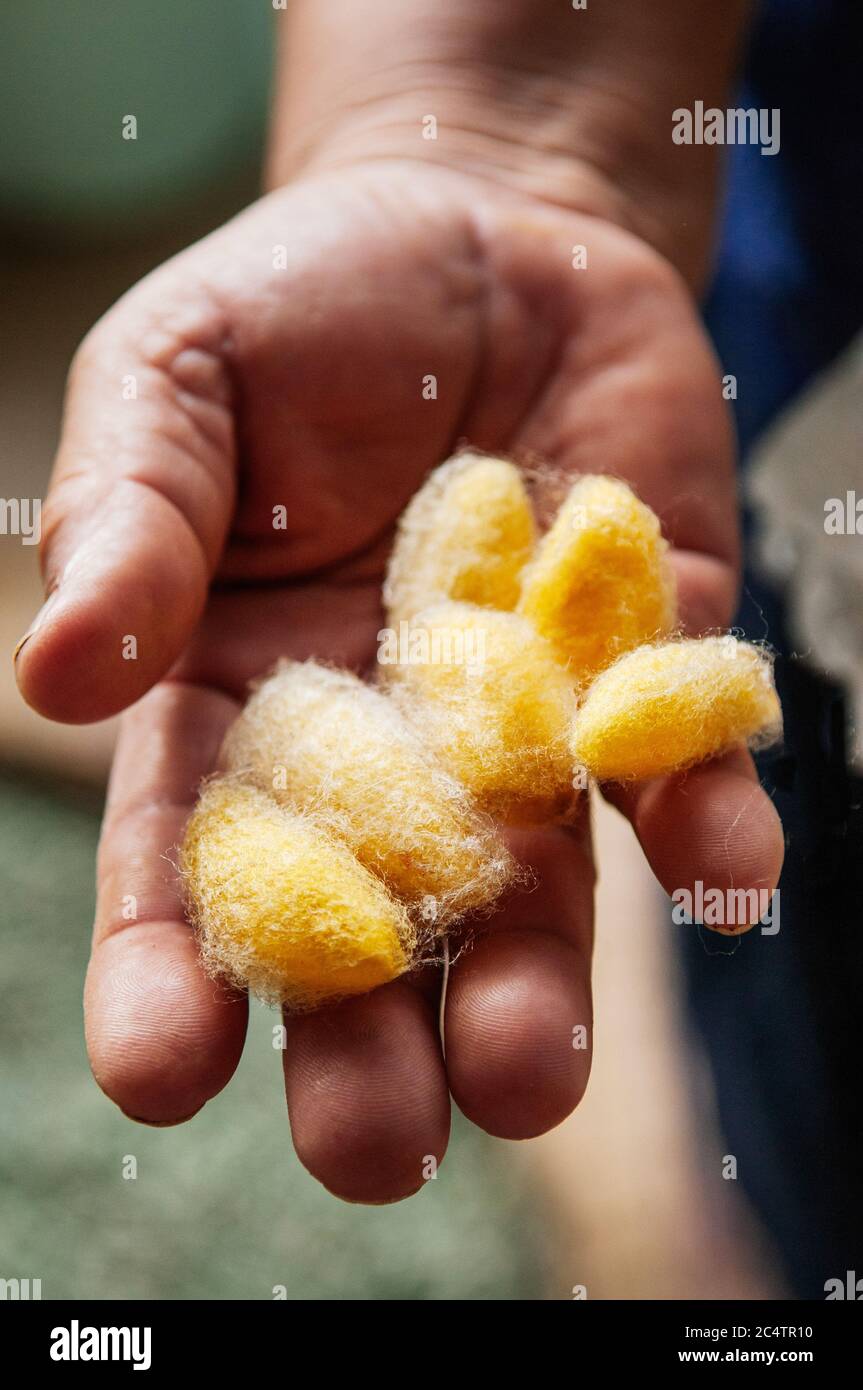 Details of natural shining yellow silk cocoons traditional sericulture of Thai silk making in Countryside Stock Photohttps://www.alamy.com/image-license-details/?v=1https://www.alamy.com/details-of-natural-shining-yellow-silk-cocoons-traditional-sericulture-of-thai-silk-making-in-countryside-image364421260.html
Details of natural shining yellow silk cocoons traditional sericulture of Thai silk making in Countryside Stock Photohttps://www.alamy.com/image-license-details/?v=1https://www.alamy.com/details-of-natural-shining-yellow-silk-cocoons-traditional-sericulture-of-thai-silk-making-in-countryside-image364421260.htmlRF2C4TR10–Details of natural shining yellow silk cocoons traditional sericulture of Thai silk making in Countryside
 Silkworm (Bombyx mori), Caterpillar Stock Photohttps://www.alamy.com/image-license-details/?v=1https://www.alamy.com/silkworm-bombyx-mori-caterpillar-image260898418.html
Silkworm (Bombyx mori), Caterpillar Stock Photohttps://www.alamy.com/image-license-details/?v=1https://www.alamy.com/silkworm-bombyx-mori-caterpillar-image260898418.htmlRFW4CXGJ–Silkworm (Bombyx mori), Caterpillar
 A silkworm on the hand of a woman researcher investigating the silk-producing mechanism of silkworms and spiders. Stock Photohttps://www.alamy.com/image-license-details/?v=1https://www.alamy.com/stock-image-a-silkworm-on-the-hand-of-a-woman-researcher-investigating-the-silk-164807581.html
A silkworm on the hand of a woman researcher investigating the silk-producing mechanism of silkworms and spiders. Stock Photohttps://www.alamy.com/image-license-details/?v=1https://www.alamy.com/stock-image-a-silkworm-on-the-hand-of-a-woman-researcher-investigating-the-silk-164807581.htmlRMKG3HN1–A silkworm on the hand of a woman researcher investigating the silk-producing mechanism of silkworms and spiders.
 Weighing and sorting the cocoons (Sericulture by Liang Kai, 1200s) Stock Photohttps://www.alamy.com/image-license-details/?v=1https://www.alamy.com/stock-photo-weighing-and-sorting-the-cocoons-sericulture-by-liang-kai-1200s-135613511.html
Weighing and sorting the cocoons (Sericulture by Liang Kai, 1200s) Stock Photohttps://www.alamy.com/image-license-details/?v=1https://www.alamy.com/stock-photo-weighing-and-sorting-the-cocoons-sericulture-by-liang-kai-1200s-135613511.htmlRMHTHMBK–Weighing and sorting the cocoons (Sericulture by Liang Kai, 1200s)
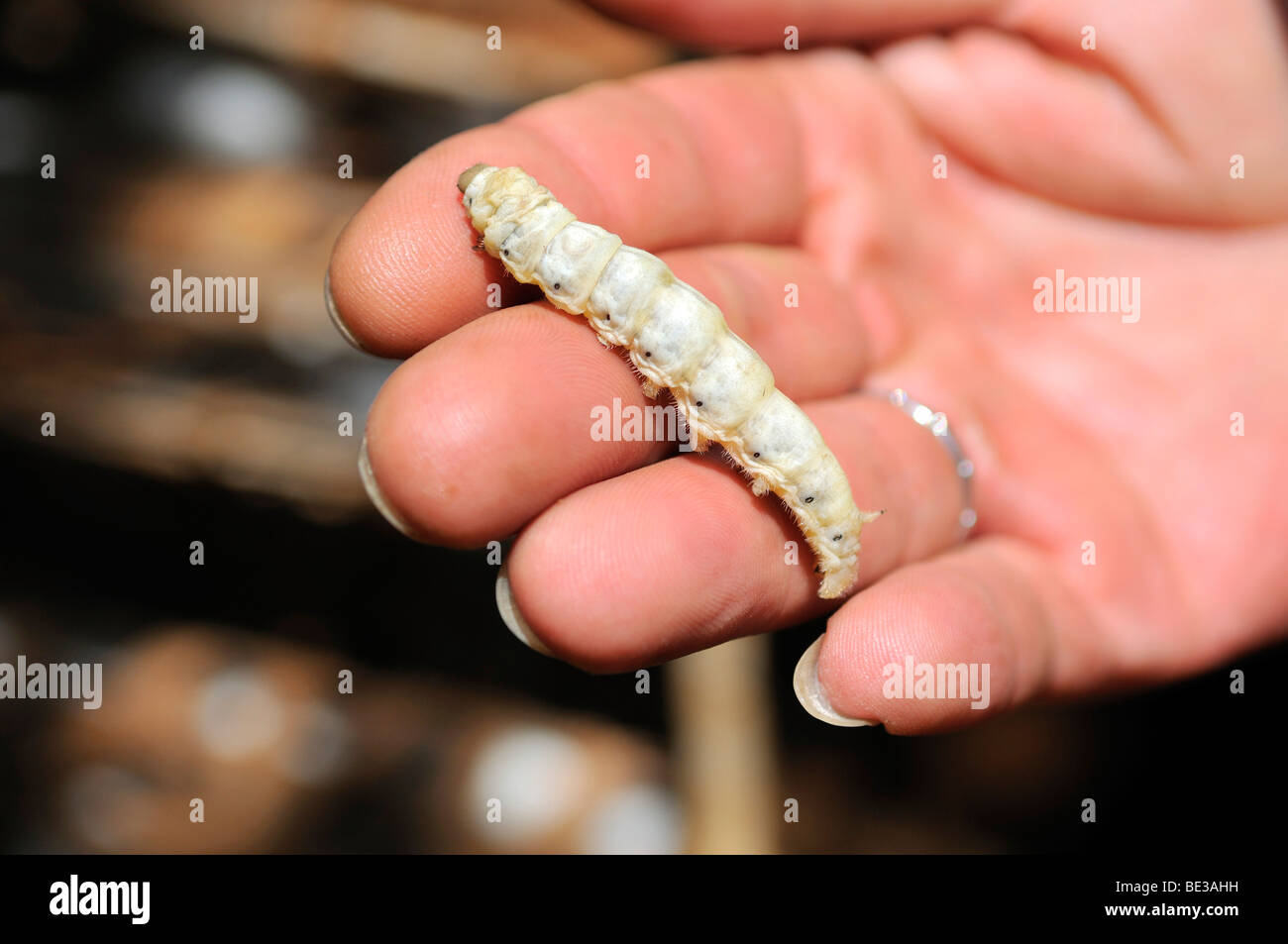 Silkworm (Bombyx mori) in the hand of the breeder, sericulture, silk farming, Dalat capital, Central Highlands, Vietnam, Asia Stock Photohttps://www.alamy.com/image-license-details/?v=1https://www.alamy.com/stock-photo-silkworm-bombyx-mori-in-the-hand-of-the-breeder-sericulture-silk-farming-25889741.html
Silkworm (Bombyx mori) in the hand of the breeder, sericulture, silk farming, Dalat capital, Central Highlands, Vietnam, Asia Stock Photohttps://www.alamy.com/image-license-details/?v=1https://www.alamy.com/stock-photo-silkworm-bombyx-mori-in-the-hand-of-the-breeder-sericulture-silk-farming-25889741.htmlRFBE3AHH–Silkworm (Bombyx mori) in the hand of the breeder, sericulture, silk farming, Dalat capital, Central Highlands, Vietnam, Asia
 Imperial Rites of Sericulture (Scroll 4- ’Offering Cocoons‥9D). Stock Photohttps://www.alamy.com/image-license-details/?v=1https://www.alamy.com/imperial-rites-of-sericulture-scroll-4-offering-cocoons9d-image364570936.html
Imperial Rites of Sericulture (Scroll 4- ’Offering Cocoons‥9D). Stock Photohttps://www.alamy.com/image-license-details/?v=1https://www.alamy.com/imperial-rites-of-sericulture-scroll-4-offering-cocoons9d-image364570936.htmlRM2C53HXG–Imperial Rites of Sericulture (Scroll 4- ’Offering Cocoons‥9D).
 1560 Spooling the silk (Sericulture by Liang Kai, 1200s) Stock Photohttps://www.alamy.com/image-license-details/?v=1https://www.alamy.com/1560-spooling-the-silk-sericulture-by-liang-kai-1200s-image213640310.html
1560 Spooling the silk (Sericulture by Liang Kai, 1200s) Stock Photohttps://www.alamy.com/image-license-details/?v=1https://www.alamy.com/1560-spooling-the-silk-sericulture-by-liang-kai-1200s-image213640310.htmlRMPBG4B2–1560 Spooling the silk (Sericulture by Liang Kai, 1200s)
 Woman working on a machine in a silk factory in Da Lat, Vietnam Stock Photohttps://www.alamy.com/image-license-details/?v=1https://www.alamy.com/woman-working-on-a-machine-in-a-silk-factory-in-da-lat-vietnam-image351680950.html
Woman working on a machine in a silk factory in Da Lat, Vietnam Stock Photohttps://www.alamy.com/image-license-details/?v=1https://www.alamy.com/woman-working-on-a-machine-in-a-silk-factory-in-da-lat-vietnam-image351680950.htmlRF2BC4CHX–Woman working on a machine in a silk factory in Da Lat, Vietnam
 Silkworm cocoons (Bombys mori) on wooden frame, production of silk thread. Stock Photohttps://www.alamy.com/image-license-details/?v=1https://www.alamy.com/silkworm-cocoons-bombys-mori-on-wooden-frame-production-of-silk-thread-image457411999.html
Silkworm cocoons (Bombys mori) on wooden frame, production of silk thread. Stock Photohttps://www.alamy.com/image-license-details/?v=1https://www.alamy.com/silkworm-cocoons-bombys-mori-on-wooden-frame-production-of-silk-thread-image457411999.htmlRF2HG4WJR–Silkworm cocoons (Bombys mori) on wooden frame, production of silk thread.
 Silkworm and vessel - modern colored vector illustration Stock Vectorhttps://www.alamy.com/image-license-details/?v=1https://www.alamy.com/silkworm-and-vessel-modern-colored-vector-illustration-image568564550.html
Silkworm and vessel - modern colored vector illustration Stock Vectorhttps://www.alamy.com/image-license-details/?v=1https://www.alamy.com/silkworm-and-vessel-modern-colored-vector-illustration-image568564550.htmlRF2T109TP–Silkworm and vessel - modern colored vector illustration
 Silk Traders Weigh Bags of Silk Cocoons at the Silk Cocoon Market Held Annually in July When Silk Farmers Gather to Sell their Silk Cocoons in the Silk Bazaar, or Koza Han, Bursa, Turkey Stock Photohttps://www.alamy.com/image-license-details/?v=1https://www.alamy.com/stock-photo-silk-traders-weigh-bags-of-silk-cocoons-at-the-silk-cocoon-market-94672375.html
Silk Traders Weigh Bags of Silk Cocoons at the Silk Cocoon Market Held Annually in July When Silk Farmers Gather to Sell their Silk Cocoons in the Silk Bazaar, or Koza Han, Bursa, Turkey Stock Photohttps://www.alamy.com/image-license-details/?v=1https://www.alamy.com/stock-photo-silk-traders-weigh-bags-of-silk-cocoons-at-the-silk-cocoon-market-94672375.htmlRMFE0KG7–Silk Traders Weigh Bags of Silk Cocoons at the Silk Cocoon Market Held Annually in July When Silk Farmers Gather to Sell their Silk Cocoons in the Silk Bazaar, or Koza Han, Bursa, Turkey
 Loom bobbin with purple thread for silk weaving Stock Photohttps://www.alamy.com/image-license-details/?v=1https://www.alamy.com/stock-photo-loom-bobbin-with-purple-thread-for-silk-weaving-173432572.html
Loom bobbin with purple thread for silk weaving Stock Photohttps://www.alamy.com/image-license-details/?v=1https://www.alamy.com/stock-photo-loom-bobbin-with-purple-thread-for-silk-weaving-173432572.htmlRFM24F0C–Loom bobbin with purple thread for silk weaving
 italy, laveno, sericulture, 1900-1910 Stock Photohttps://www.alamy.com/image-license-details/?v=1https://www.alamy.com/italy-laveno-sericulture-1900-1910-image243038643.html
italy, laveno, sericulture, 1900-1910 Stock Photohttps://www.alamy.com/image-license-details/?v=1https://www.alamy.com/italy-laveno-sericulture-1900-1910-image243038643.htmlRMT3BA7F–italy, laveno, sericulture, 1900-1910
 Silkworm breeding in a silk factory. Rajshahi, Bangladesh Stock Photohttps://www.alamy.com/image-license-details/?v=1https://www.alamy.com/stock-photo-silkworm-breeding-in-a-silk-factory-rajshahi-bangladesh-141675026.html
Silkworm breeding in a silk factory. Rajshahi, Bangladesh Stock Photohttps://www.alamy.com/image-license-details/?v=1https://www.alamy.com/stock-photo-silkworm-breeding-in-a-silk-factory-rajshahi-bangladesh-141675026.htmlRMJ6DRXA–Silkworm breeding in a silk factory. Rajshahi, Bangladesh
 spinning silk thread at the Queen Sirikit Sericulture Center in Surin Thailand Stock Photohttps://www.alamy.com/image-license-details/?v=1https://www.alamy.com/stock-photo-spinning-silk-thread-at-the-queen-sirikit-sericulture-center-in-surin-20453313.html
spinning silk thread at the Queen Sirikit Sericulture Center in Surin Thailand Stock Photohttps://www.alamy.com/image-license-details/?v=1https://www.alamy.com/stock-photo-spinning-silk-thread-at-the-queen-sirikit-sericulture-center-in-surin-20453313.htmlRMB57MBD–spinning silk thread at the Queen Sirikit Sericulture Center in Surin Thailand
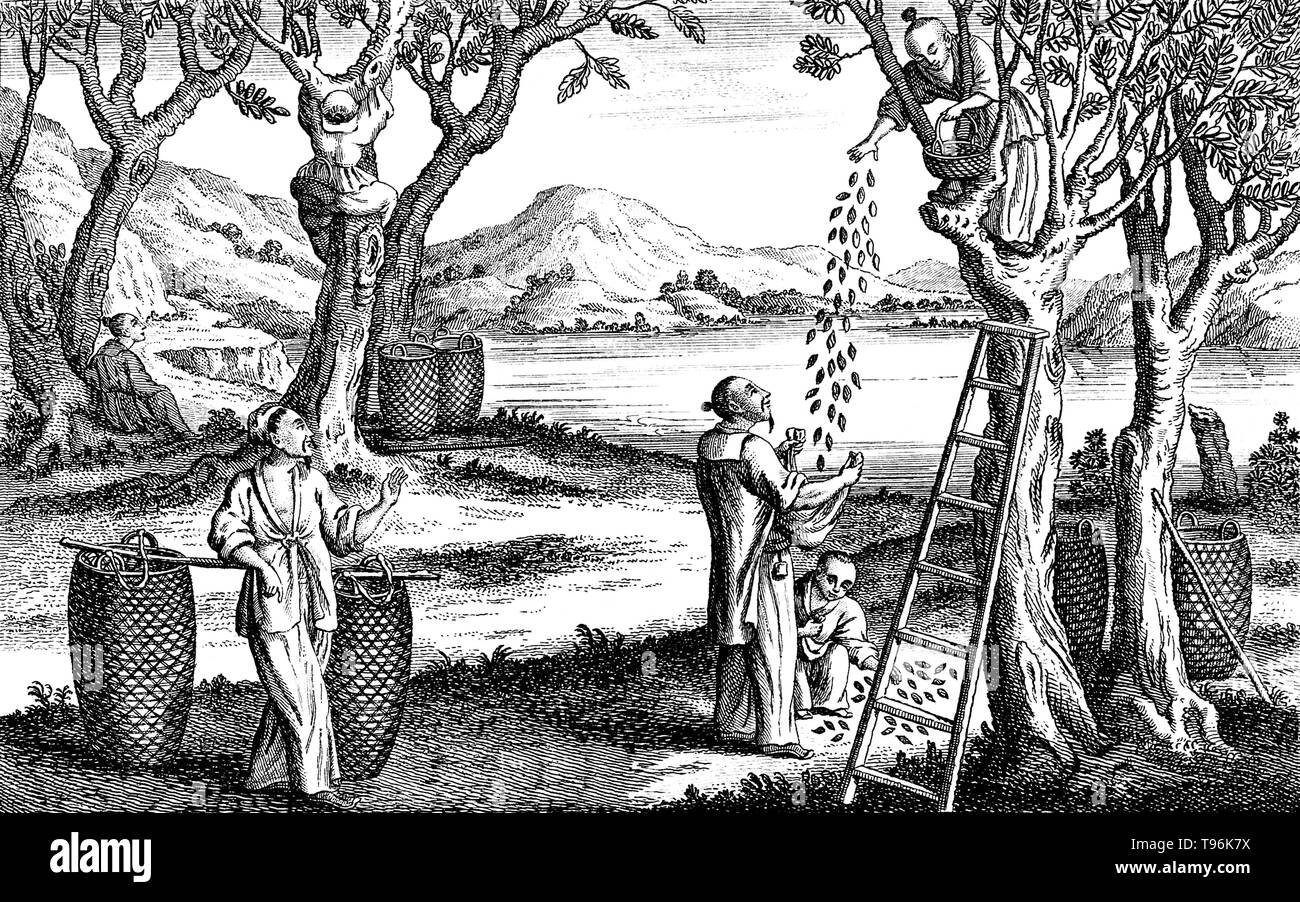 Textiles: silk manufacture in China, gathering mulberry leaves. The production of silk originates in China in prehistoric times. Silk remained confined to China until the Silk Road opened at some point during the later half of the first millennium BC. China maintained its virtual monopoly over silk production for another thousand years. Sericulture, or silk farming, is the cultivation of silkworms to produce silk. Stock Photohttps://www.alamy.com/image-license-details/?v=1https://www.alamy.com/textiles-silk-manufacture-in-china-gathering-mulberry-leaves-the-production-of-silk-originates-in-china-in-prehistoric-times-silk-remained-confined-to-china-until-the-silk-road-opened-at-some-point-during-the-later-half-of-the-first-millennium-bc-china-maintained-its-virtual-monopoly-over-silk-production-for-another-thousand-years-sericulture-or-silk-farming-is-the-cultivation-of-silkworms-to-produce-silk-image246623886.html
Textiles: silk manufacture in China, gathering mulberry leaves. The production of silk originates in China in prehistoric times. Silk remained confined to China until the Silk Road opened at some point during the later half of the first millennium BC. China maintained its virtual monopoly over silk production for another thousand years. Sericulture, or silk farming, is the cultivation of silkworms to produce silk. Stock Photohttps://www.alamy.com/image-license-details/?v=1https://www.alamy.com/textiles-silk-manufacture-in-china-gathering-mulberry-leaves-the-production-of-silk-originates-in-china-in-prehistoric-times-silk-remained-confined-to-china-until-the-silk-road-opened-at-some-point-during-the-later-half-of-the-first-millennium-bc-china-maintained-its-virtual-monopoly-over-silk-production-for-another-thousand-years-sericulture-or-silk-farming-is-the-cultivation-of-silkworms-to-produce-silk-image246623886.htmlRMT96K7X–Textiles: silk manufacture in China, gathering mulberry leaves. The production of silk originates in China in prehistoric times. Silk remained confined to China until the Silk Road opened at some point during the later half of the first millennium BC. China maintained its virtual monopoly over silk production for another thousand years. Sericulture, or silk farming, is the cultivation of silkworms to produce silk.